

18 Top Attractions & Places to Visit in Death Valley, CA
Written by Lana Law Updated May 3, 2023 We may earn a commission from affiliate links ( )
Author Lana Law has visited Death Valley many times and in different seasons to enjoy photography, hikes, and to see the wildflowers in bloom.
Despite the forbidding name, Death Valley is a beautiful area of desert wonders and one of the best national parks in the United States . Sand dunes, salt flats, mountains, craters, and the lowest lake in North America make for some of the most spectacular scenery in the Southwest.
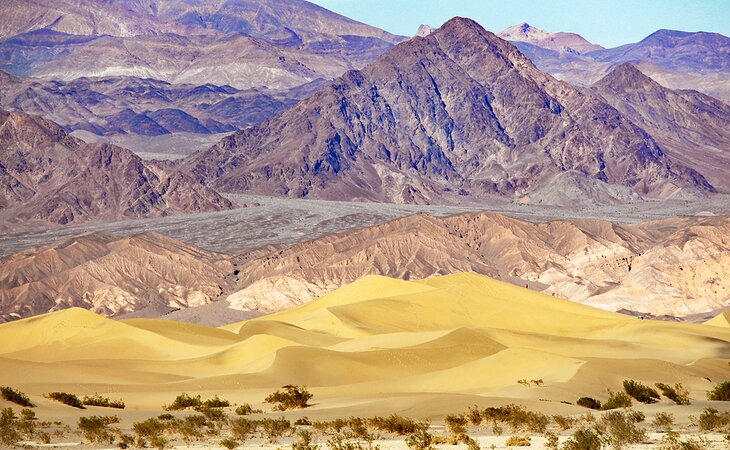
The valley, protected as a national park, covers 3,000 square miles and is known for being the hottest, driest, and lowest point in North America . Roadside lookouts offer stunning panoramas, and hiking trails allow easy access to the terrain.
Many people visit the park on a day trip from Las Vegas . The centrally located Furnace Creek is the main service center in the park and is about a two-hour drive from Las Vegas. This is also where you'll find the park visitor center, campgrounds, restaurants, a store, a gas station, and The Ranch at Death Valley .
On the west side of the park, is Panamint Springs , with a restaurant, gas station, and some limited accommodation. This is a convenient stop if you are entering the park from the west side and a good lunch option if you are visiting Father Crowley Point and Darwin Falls, the two main tourist attractions on this side of the valley.
Determine what you want to see with this list of attractions and places to visit in Death Valley .
Note: Death Valley's roads, trails, and some attractions were badly damaged in August and September by torrential rains. Work is ongoing, and most things should be back up and running by mid-2023.
Also on This Page:
1. sand dunes near stovepipe wells, 2. badwater basin, 3. the racetrack, 4. zabriskie point, 5. dantes view, 6. artist's drive and artist's palette, 7. devil's golf course and artist's drive, 8. harmony borax works and the sand dunes near stove pipe wells, 9. twenty mule team canyon, 10. keane wonder mine, 11. father crowley point, 12. ubehebe crater, 13. rhyolite ghost town, 14. natural bridge, 15. spring wildflowers, 16. devil's cornfield, 17. darwin falls, 18. wild rose charcoal kilns, map of attractions & things to do in death valley, ca, driving routes through death valley national park.
- Organized Tour of Death Valley
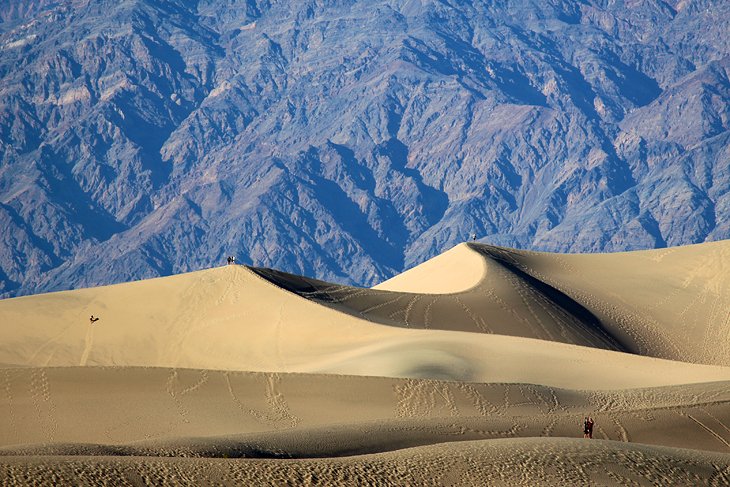
One of the most beautiful sites and most photographed landscapes in Death Valley is the Mesquite Flat Sand Dunes , just east of Stovepipe Wells . In the morning and late afternoon, when the sun hits the sculpted dunes, creating long curving shadows, the views are fantastic. Mountains rise up on the horizon providing the perfect backdrop. For photographers, it's pure magic.
You can walk in the dunes, climb to the highest points, or set up a lawn chair and soak up the desert scenery. On busy days in the spring, there is rarely a dune without a person climbing up or running down, but on quiet days, particularly in January or February, you will likely have the dunes to yourself. If you arrive at the dunes after a windy spell, they will be untracked.
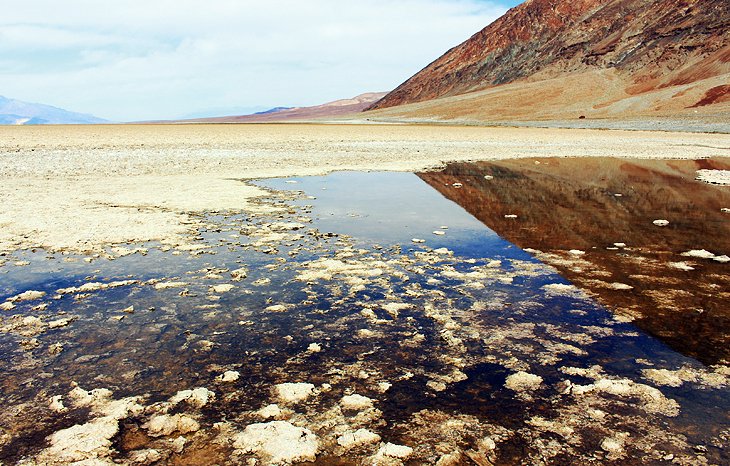
At the south end of Death Valley National Park, Badwater Basin is the lowest point of land in the western hemisphere , at 277 feet below sea level. Needless to say, this area is very hot, even in the winter.
Badwater Lake is a shallow lake surrounded by mountains and rimmed with salt, but you may not always see water here. Depending on the conditions or the time of year, Badwater may be quite full or have very little water. In either case, the area is interesting and there are a number of things to do.
When there is almost no visible water from the shore, you can walk out, seemingly endlessly, across the white salt flat. When there is water, and if the air is still, which it often is in the morning and early evening, the mountains across the valley reflect in the water, and the scene is stunning. This can be a wonderful area for photography. If there is enough water, it's even possible to paddle out on the lake.
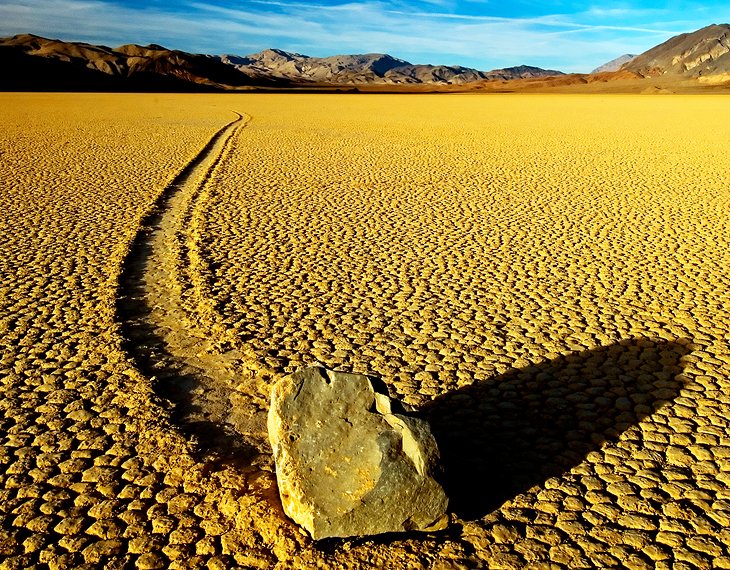
With a four-wheel-drive vehicle , you can take a rugged road that leads to one of Death Valley's most mysterious sights, known as The Racetrack. This area is a huge dried mud bed, where stones of various sizes can be seen with long tracks trailing behind them, as if they have been pushed through the mud.
Speculation existed for years about how the stones were moved. Many thought the stones were pushed along by the wind after rains. However, more recently, with the help of time-lapse photography, it is thought that the stones are actually moved by floating ice pushing the rocks. Regardless of the method, the result is a most interesting sight.
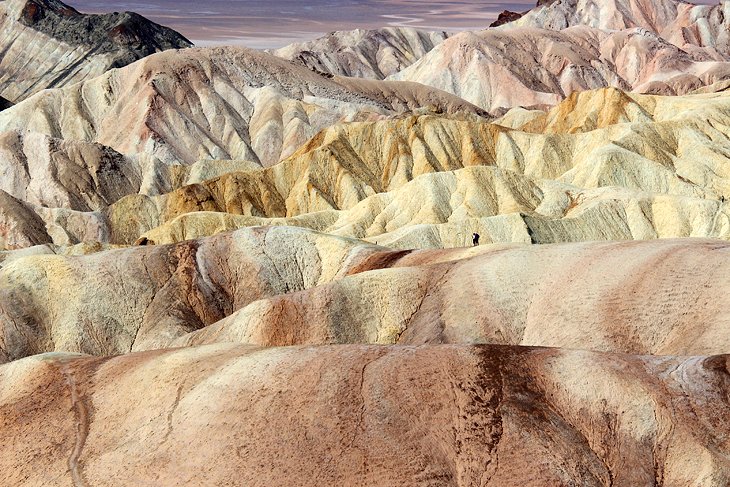
Zabriskie Point looks out over a surreal landscape of undulating, hard-packed ridges of gold, orange, and brown earth. Sweeping views from the lookout extend over this unique formation and beyond to the valley behind and the Panamint Mountains in the distance. The colors are particularly spectacular in the morning or late afternoon.
You can drive to the lookout at Zabriskie Point. A 7.8-mile hiking trail leads out from Zabriskie point, but if you want to get out on the ridges and immerse yourself in the scenery without undertaking a long hike, just wander out a short distance and return on the same track.
You can reach Zabriskie Point by heading east from Furnace Creek on highway 190 for four miles. If you are coming into the park from Las Vegas on the route described above, this is one of the stops on your way to Furnace Creek.
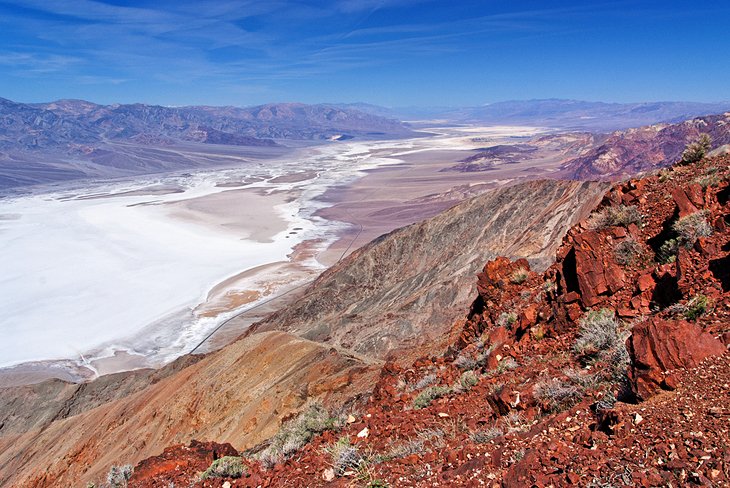
Dante's View offers one of the best overall perspectives of Death Valley. The view from the top looks out over the valley floor, as far as the eye can see, and across to the mountains that line the far side of the valley.
This lookout is a little out of the way but worth the effort. From Zabriskie Point head east on Highway 190 to the sign-posted turn for Dante's View. From the highway, it is a 16-mile drive along a twisty, paved road to the top , which stands at 5,478 feet above sea level. Vehicles on this road must be less than 25 feet in length.
The temperature up here is much cooler than on the valley floor, which can be a refreshing treat on hot days.
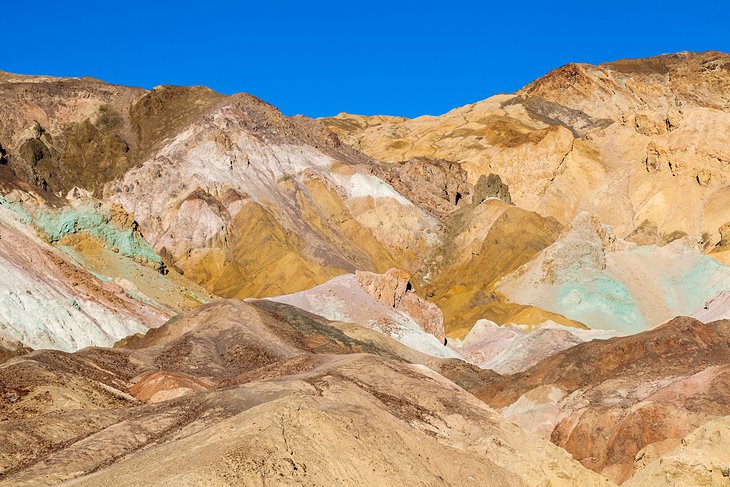
Artist's Palette is an area located along Artist's Drive, a short scenic road that takes you up close to a section of the Black Mountains. Artist's Palette is a colorful section of hillside, with shades that range from orange, pink, and brown to green and turquoise, created by metals in the rock.
Artist's Drive is a one-way, nine-mile paved loop , accessible to vehicles under 25 feet in length. This is a worthwhile side trip and a popular thing to do on the way from Furnace Creek to Badwater, located right off Badwater Road. If possible, try to do this drive in the late afternoon, when the colors are at their best.
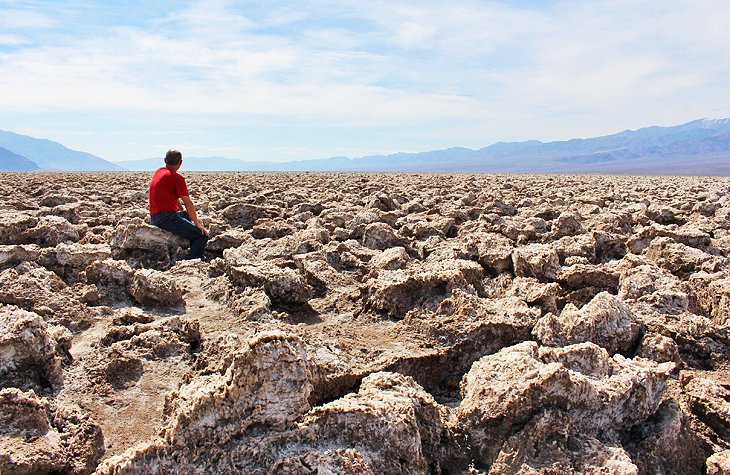
Devil's Golf Course is a flat expanse of sharp salt crystals that form a huge field of jagged salt boulders . It may seem like there isn't much to see here, but the vastness, solitude, and quietness, along with the unusual sight, create a unique experience.
Located south of Furnace Creek, just off the main road heading towards Badwater (Badwater Road) this is an easy stop. From the parking area, you can walk right out onto the field, if you choose.
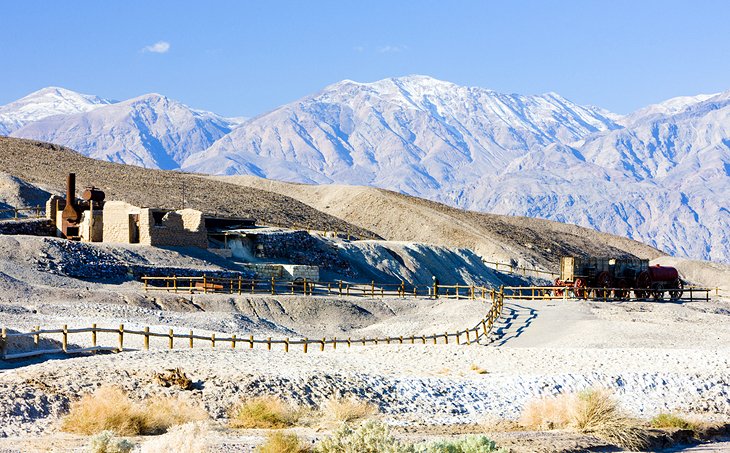
Aaron Winters found borax in Death Valley in 1881. He soon sold his claims to William T. Coleman, builder of the Harmony Borax Works, where borate-bearing muds were refined until 1888. The site of the former operation is located just north of Furnace Creek.
You can wander around the crumbling adobe walls and see the old broiler and some of the vats. Also located here are wagons once used for transporting goods out of the valley. Closed in 1888, this was the first successful borax works in the history of borax mining in Death Valley.
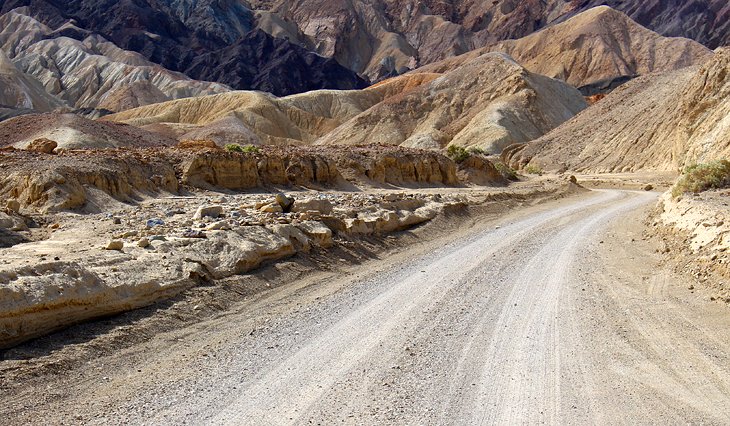
Twenty Mule Team Canyon is a 2.7-mile one-way dirt road that runs through some fantastic scenery. The road is bounded in some areas by rock walls on either side, barren flats, and colorful hills, similar to those found just down the road at Zabriskie Point. The terrain here is different from other parts of the park and reveals the ruggedness of the region.
During the borax days, twenty mule teams were used to haul the borax-filled wagons out of Death Valley, and this road offers some perspective on the type of landscape these vehicles were forced to contend with in the 1880s. However, there is no indication that this specific route was used in this fashion.
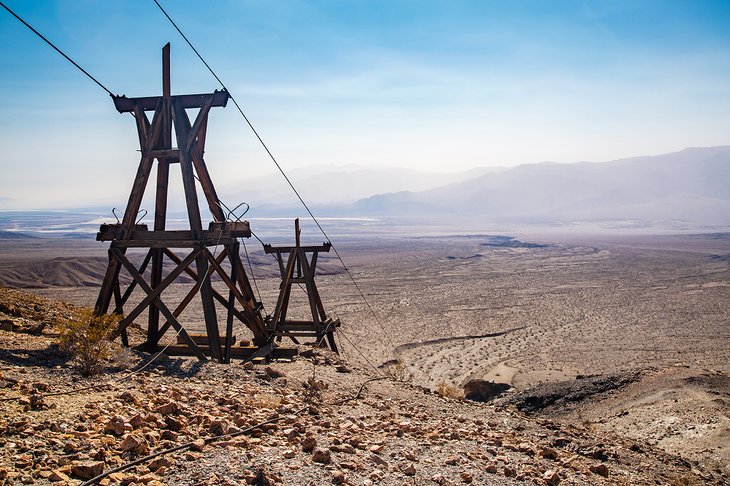
The remains of this historic gold mine can be difficult to get to but worth the effort if you are interested in this type of attraction. You can see the old aerial tramway , which is still intact, along with other structures. The mine is set on a hillside, and views extend across the valley.
Getting to the site involves a drive down a rough dirt road, which is usually passable in a regular vehicle, and a short but moderately strenuous hike from the parking area. The road is just under three miles, and the hike is a quarter of a mile to the lowest section of the tram.
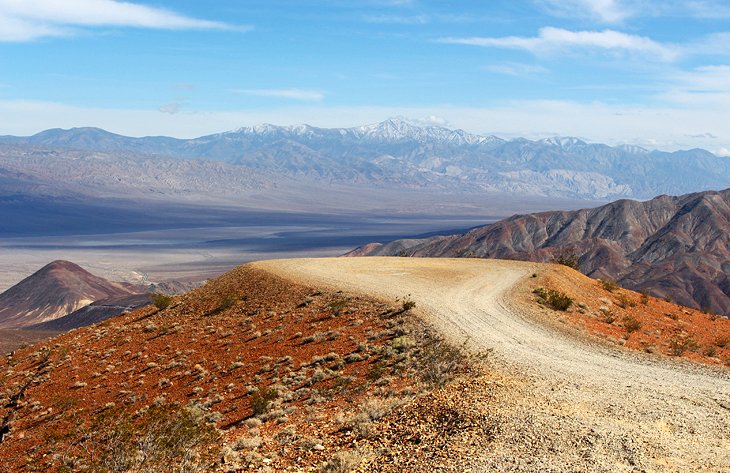
Father Crowley Point is a high lookout on the west side of the park that offers a different perspective than viewing areas on the busier east side of the park. If you are entering Death Valley from the west, Father Crowley Point should be your first stop before the long descent towards Panamint Springs.
There are two parking areas: one right at the overlook and another further back, closer to the highway. The first parking lot is easily accessed right off the main highway, and many people choose to walk the short distance out to the lookout point. The road to the lookout is not paved, quite bumpy, and may require high clearance.
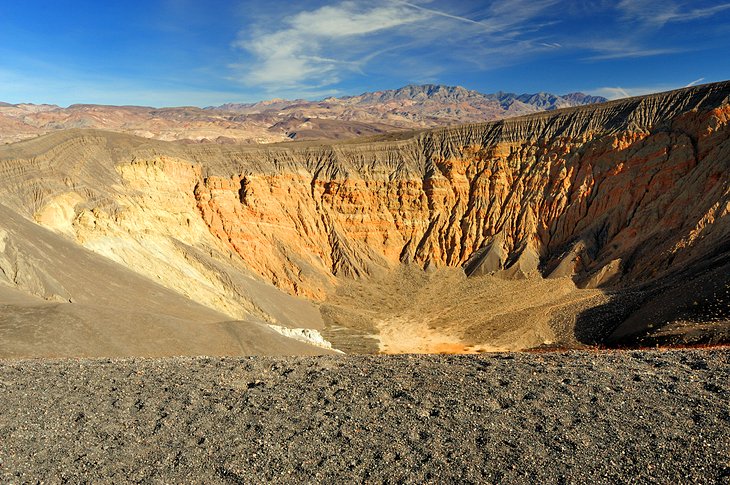
The Ubehebe Crater measures about a half-mile wide and 400 feet deep, and it is the only crater in the area that resulted from a volcanic explosion . It is located at the north end of Death Valley, in the general vicinity of Scotty's Castle, which is closed due to flooding.
The landscape here is different from other areas of the park. The ground is dark, with lava flows and cinders. If you are feeling up for a walk, trails lead down into the crater.
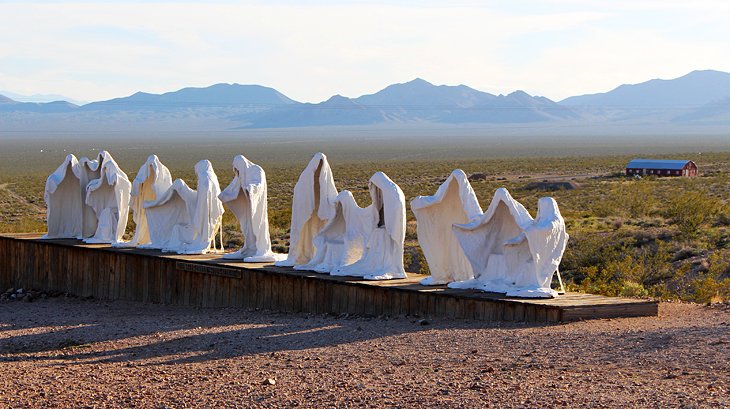
Rhyolite is an abandoned mining town, with remnants of its glory days visible in the crumbling and decaying old buildings. One of the highlights of this ghost town is a unique art installation of ghostly figures erected on the edge of the town. One large piece, standing before a vast expanse of desert, displays ghosts arranged in the form of The Last Supper .
Other pieces are also found here, in what is now called the Goldwell Open Air Museum , including a giant pink lady made of blocks, called "Lady Desert: The Venus of Nevada."
Rhyolite is a good stop on your way out of the park. It is located off Daylight Pass Road (highway 374) just outside the park boundary, on the way to Beatty.
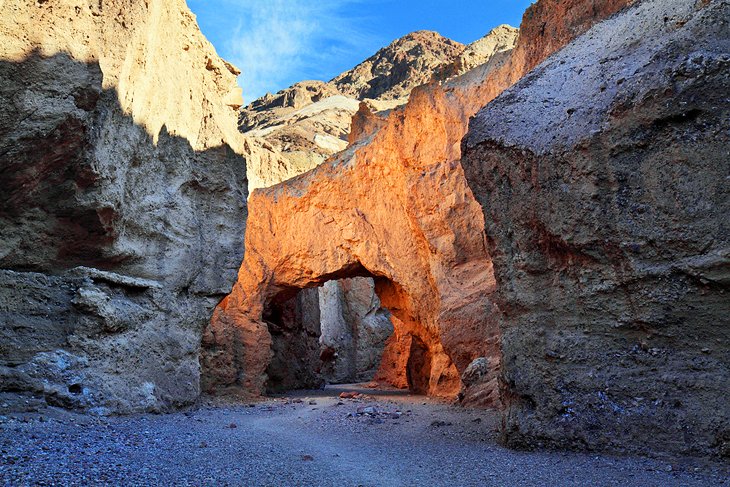
Natural Bridge is, as the name suggests, a large natural bridge set in a canyon, not far from Badwater.
An easy two-mile round-trip hike leads to the end of the canyon, but if you only want to see the bridge, it is located about half a mile from the parking area . In the midday heat, this can still feel like quite a journey, and it may be something you want to tackle earlier in the day. The parking area is located 1.5 miles along a dirt road off Badwater Road.
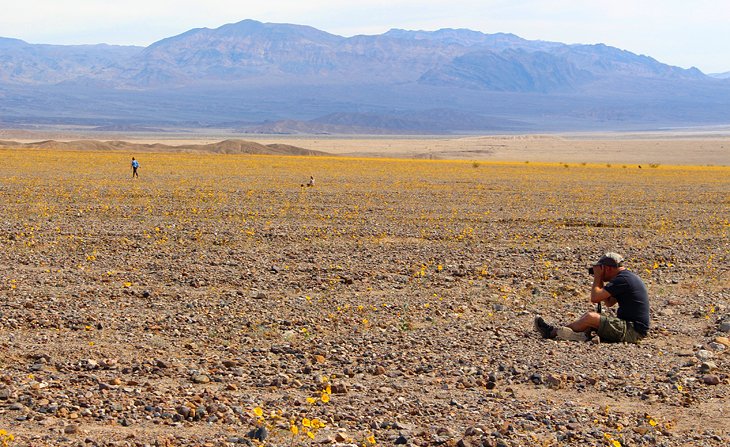
One of the park's biggest attractions is the spring wildflower bloom, which usually peaks in March . Depending on the year, the conditions, and the extent of the bloom, this event can draw thousands of people to the park. To anyone unfamiliar with deserts, it might seem amazing that anything can grow in these hot dry conditions.
On weekends during the bloom, it's not uncommon to see people pulled off to the side of the road all over the park, picnicking on the bare ground, meditating among the flowers, or walking through the fields. Despite the fact that people do this, you should not walk out in the fields and trample the flowers.
One of the best places to visit to see this beautiful display is in the south part of the park around Badwater and up towards Furnace Creek , where a carpet of yellow spreads across the valley floor. Areas further north also see a good display of flowers, usually with a mix of colors that range from white and yellow to orange and purple.
The park visitor center can point you in the right direction and offer information on what is blooming while you are in the park.
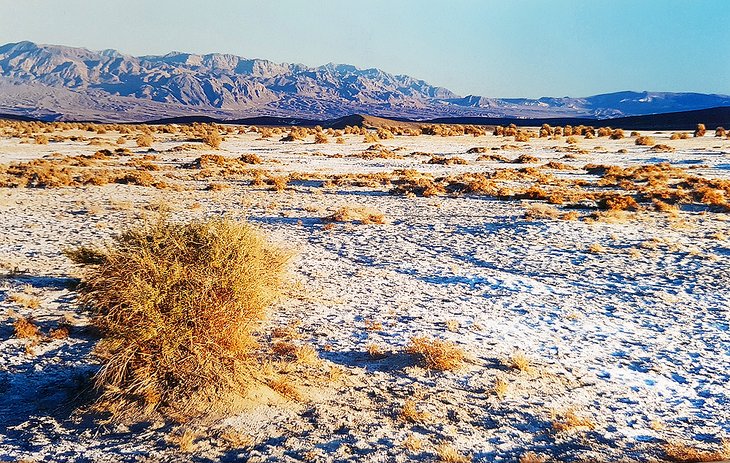
Compared to the rest of the sights in Death Valley, Devil's Cornfield is not necessarily worth going out of your way to see, but it's a sight you will pass if you are driving from the east to Stovepipe Wells and the sand dunes.
Clumps of vegetation that look like tumbleweeds dot the landscape as it stretches out to the distant hills and mountains. Depending on the time of year, the shrubs may be green or dried out to an amber color. Photographers can have some fun in this area, particularly in the late afternoon.
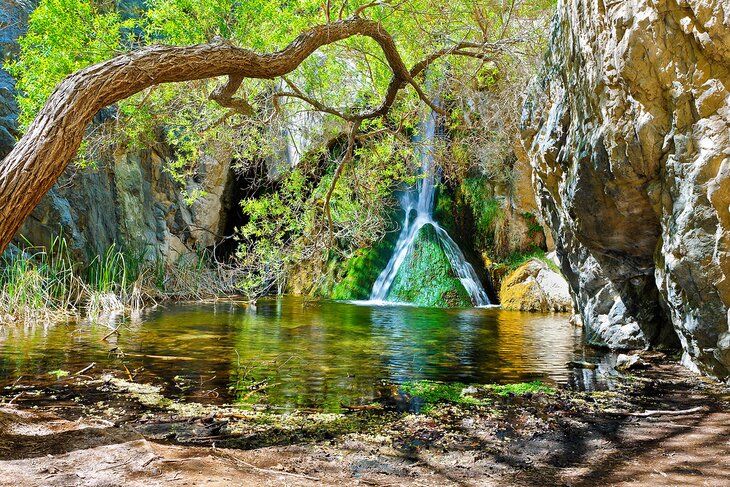
After your trip, when you tell your friends about your experiences in Death Valley and include the fact that you visited a waterfall, they may think you are trying to play a joke on them. However, break out the photos and show them that this amazing natural wonder actually exists.
The trail is 1.9 miles long and with an elevation gain of only 275 feet , most people consider it fairly easy and suitable for all abilities. You'll start out at a valley entrance and as the trail progresses, it gets increasingly narrow. You'll hear the falls before you see them. Although not overly high, the flowing water with a pool below is a very welcome sight in the desert.
Note the trail was damaged during the August 2022 floods. It is still passable but caution is advised.
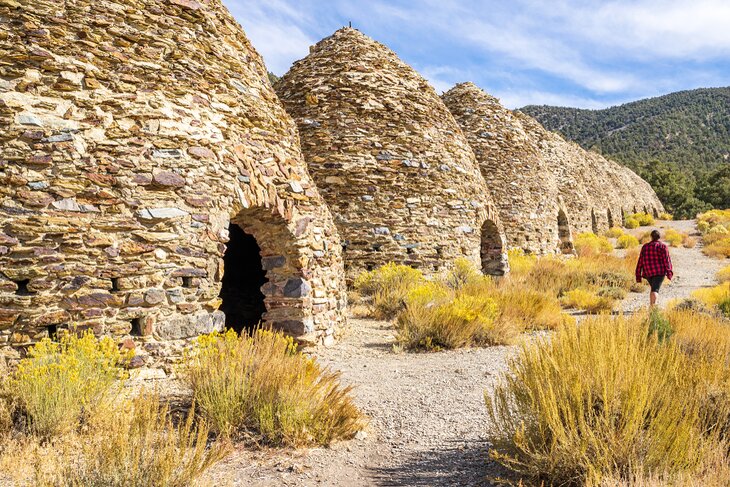
An off-the-beaten-track attraction that, if you have the right vehicle, is worth visiting is the Wild Rose Charcoal Kilns. These beehive-shaped stone structures are in remarkably good shape considering that they were used back to make charcoal when the park area was a mining hot spot at the turn of the 20th century.
The Wild Rose Charcoal Kilns have doors that are open, and you can wander freely in and out of the structures. It's more than likely that you'll have this remote spot to yourself — the road is notoriously bad and suitable for high-clearance 4WD vehicles , only.
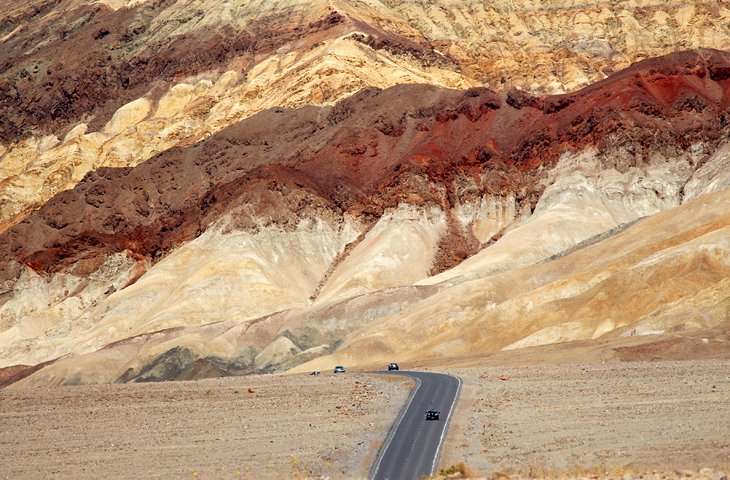
Most visitors come either from California, entering from the west off Highway 395 onto Highway 190, through Panamint Springs, or from Las Vegas, where there are a couple of routing options.
From Las Vegas: You can easily visit Death Valley on a day trip from Las Vegas . The best way to do this is to head out on Highway 160 (leaving from the south end of Las Vegas) to Death Valley Junction, where the road becomes Highway 190, entering the park. This road runs past the turnoff for Dante's View , Twenty Mule Canyon, and Zabriskie Point, and on to Furnace Creek with a park visitor center and some amenities.
From Furnace Creek you can head south to Badwater , passing the pullouts for Desolation Canyon, Artist's Drive (Artist's Palette), Devil's Golf Course , and Natural Bridge . When you have visited Badwater, backtrack via Furnace Creek and beyond to the Harmony Borax Interpretive Trail, Mustard Canyon, and the Sand Dunes near Stovepipe Wells .
If you started early in the day and still have plenty of time, you may want to continue on. It's a little over a half-hour to Panamint Springs and another 20 minutes to Father Crowley Point . After this, you can turn around and head back to Stovepipe Wells, and out of the park on the Daylight Pass Road (374) that leads to Beatty.
Before getting to Beatty, stop at the Rhyolite ghost town to see the ruins of this old mining town and some creative art installations. From Beatty take Highway 95 back to Las Vegas.
If you have time for a second day in Death Valley , you can spend the night in the park or in Beatty. With two days, you'll be able to add on a visit to the Race Track and a few more stops for hiking and sightseeing.

More on California
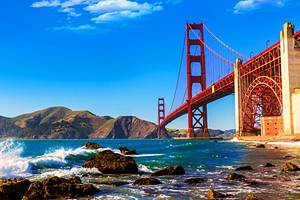
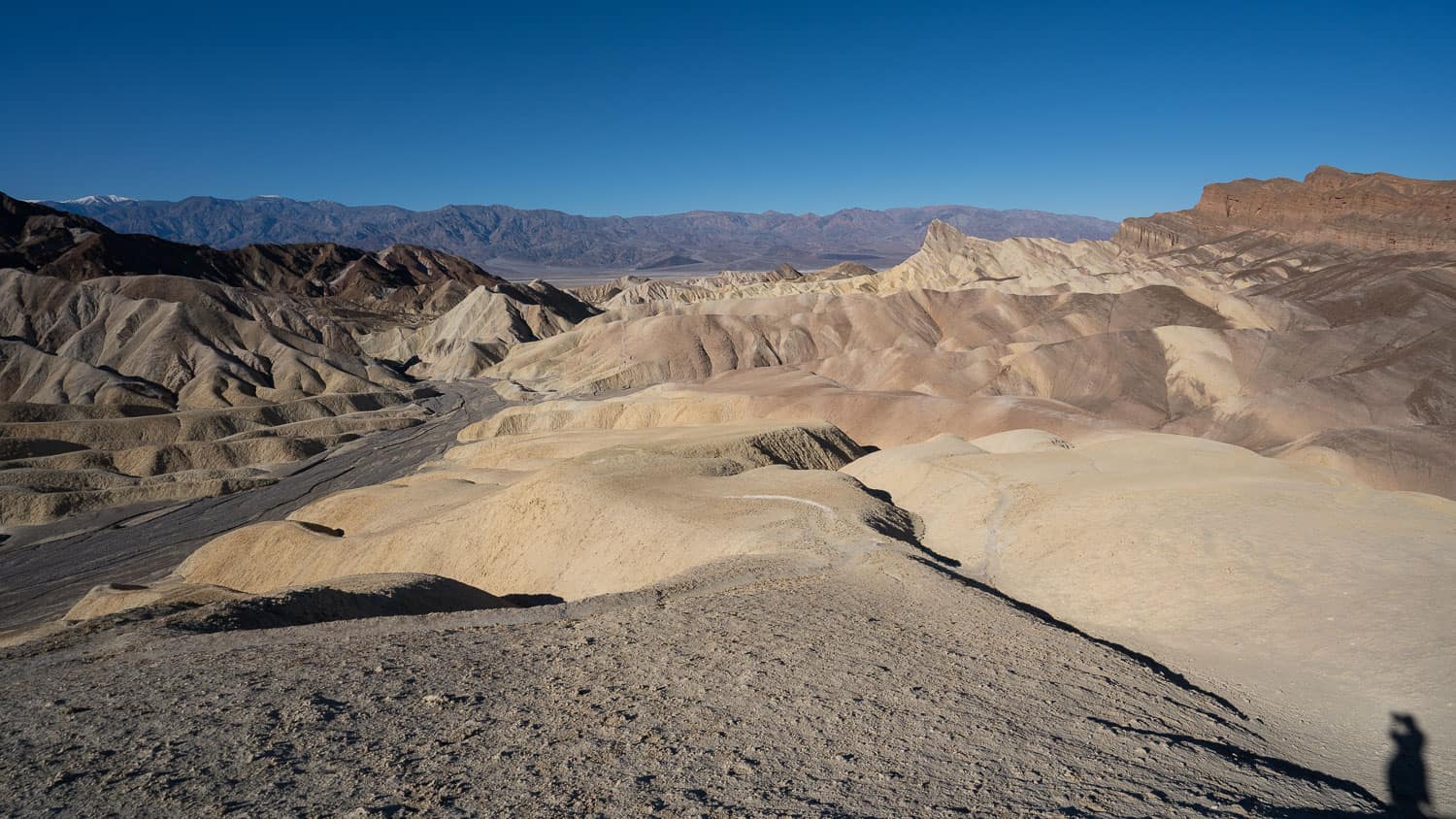
15 Incredible Things to Do in Death Valley National Park
This page contains affiliate links. Please read our disclosure for more info.
Death Valley National Park is unlike anywhere else we’ve visited. It’s one of the lowest and hottest places on earth and is full of incredible otherworldly landscapes.
We spent a week roaming its vast stark beauty—watching sunrises on sand dunes and sunsets across salt flats, hiking through rippled badlands and golden canyons, and admiring multicoloured hills and snow-capped peaks.
Here I share our picks for the best things to do in Death Valley from easy but dramatic viewpoints to more challenging hikes. You’ll also find our tips for making the most of your trip, where to stay, a suggested itinerary, and a map with all the top attractions.
Where is Death Valley National Park?
Best things to do in death valley national park: our top picks, other death valley attractions worth visiting, things to do near death valley, death valley itinerary for two days, accommodation in death valley, tips for visiting death valley national park, map of death valley attractions, is death valley worth visiting, more california posts.
Death Valley National Park is in Inyo County, California, along the border with Nevada (a small part of the park is in the neighbouring state) and east of the Sierra Nevada mountains.
You’ll need your own vehicle to get there or you could visit on this small group Death Valley day trip from Las Vegas .
Here are approximate driving times from nearby destinations to Furnace Creek (in the heart of the park):
- Las Vegas (Nevada) – 2 hours
- Los Angeles – 4 hours 30 minutes
- Bakersfield – 4 hours
- Joshua Tree – 4 hours 15 minutes
- Palm Springs – 5 hours
- Yosemite Village – 6 hours (in summer)
- Sequoia National Park – 6 hours
- Zion National Park (Utah) – 4 hours 30 minutes
We visited Death Valley on a road trip between Palm Springs and Zion National Park. See our tips for visiting Zion in winter .
It’s also ideal to combine with Joshua Tree National Park, which we passed on the way (and visited previously).
See our guide to the best things to do in Southern California for more suggestions for the area as well as our post on the best Joshua Tree hikes .
At the end of this post you’ll find a map of Death Valley National Park with all these featured attractions.
Back to Contents
Death Valley National Park is immense—3.4 million acres with 1000 miles of roads. These suggested Death Valley activities focus on the main part of the park (within an hour or so of Furnace Creek where the visitor centre and hotels are located).
There are many things to see in Death Valley beyond this area, but you’ll have to drive for hours and many roads are 4WD only (all the places below are accessible without 4WD).
These are our Death Valley must sees.
1) See the Sunrise at Zabriskie Point
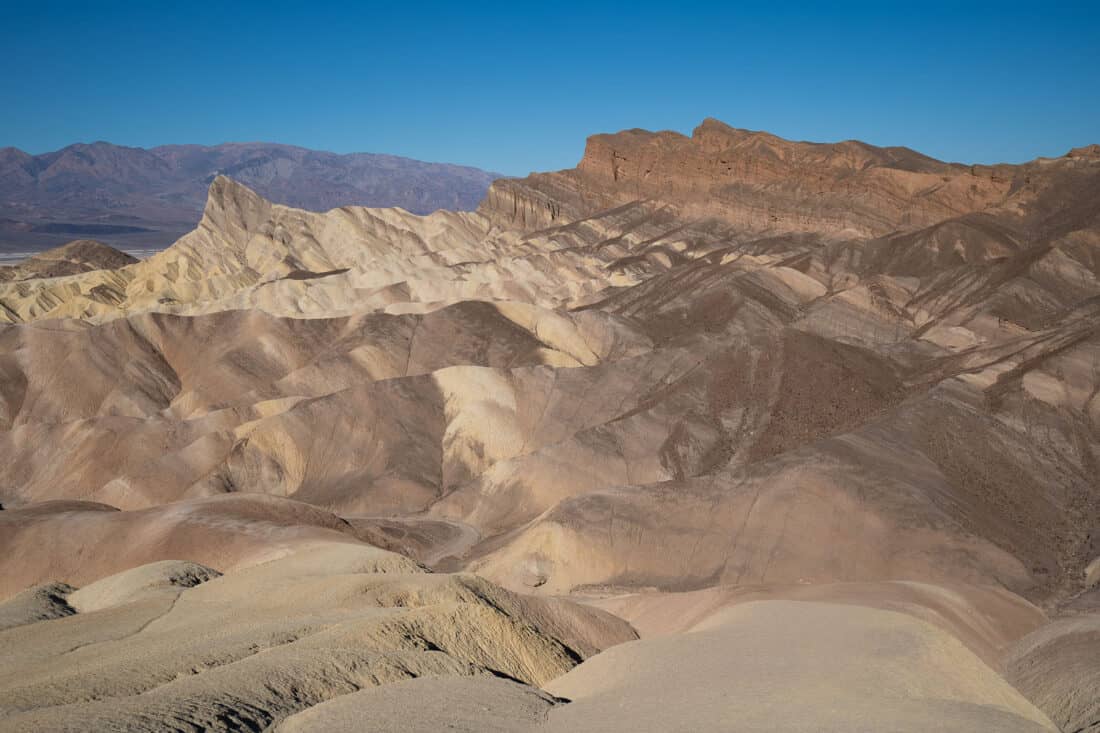
Access: Paved road Facilities: Toilet in car park Time needed: 10+ minutes Distance from Furnace Creek Visitor Centre: 5 miles (8km)/ 10 minutes
If you only do one Death Valley activity, make it the viewpoint at Zabriskie Point.
It’s only a few minutes’ walk on a paved path from the parking lot to the viewing area, and it is spectacular.
You gaze down into the valley of bumpy badlands striped yellow and brown, shaped by the force of water. You can also see the jagged peak of Manly Beacon, the rugged Red Cathedral and beyond to the salt flats and snow-topped Panamint Mountains.
Zabriskie Point is most popular at sunrise and it’s well worth getting up for. The sun rises behind you and it’s a stunning sight as it lights the mountains in front and turns them a glowing red.
Don’t expect to have it to yourself, but on a winter weekday, we found there was enough space to spread out. Some visitors are organised and bring chairs, blankets, and hot drinks. You’ll definitely want extra layers as it felt very chilly in the wind.
If you don’t manage to wake up in time, the light was still beautiful two hours after sunrise when the badlands are fully lit up. It’s also a popular sunset spot.
One of the best hikes in Death Valley starts from here (see below).
2) Hike the Golden Canyon and Gower Gulch Loop
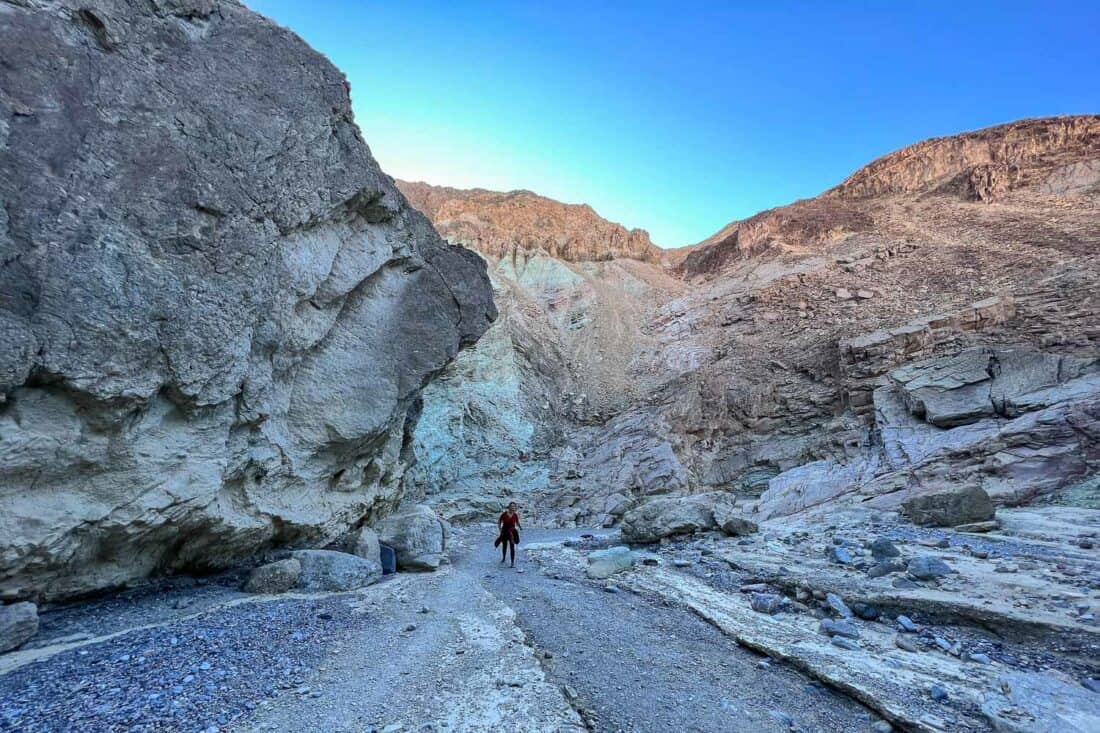
Access: Paved road Facilities: Toilet at both trailhead car parks Time needed: 1-3 hours Hiking stats: 6.2 miles (10km)/ 2.5 hours / 1130 feet (345m) elevation gain Distance from Furnace Creek Visitor Centre to Golden Canyon Trailhead: 3.5 miles (5.5km)/ 7 minutes The Golden Canyon hike is one of the best things to do in Death Valley National Park. This popular trail has its own trailhead and most visitors do a 2-mile roundtrip hike from here to the junction to Red Cathedral.
You can also experience it on a longer loop hike, which is what we did. As we were already at Zabriskie Point for sunrise we decided to hike down into Golden Canyon and come back up Gower Gulch.
We’re so glad we did as the hike was amazing. My favourite part was at the start walking down from Zabriskie on the Badlands Loop with the rippled badlands and Red Cathedral glowing in the golden morning light. Starting at 7.15am we didn’t see anyone else until we reached the Golden Canyon.
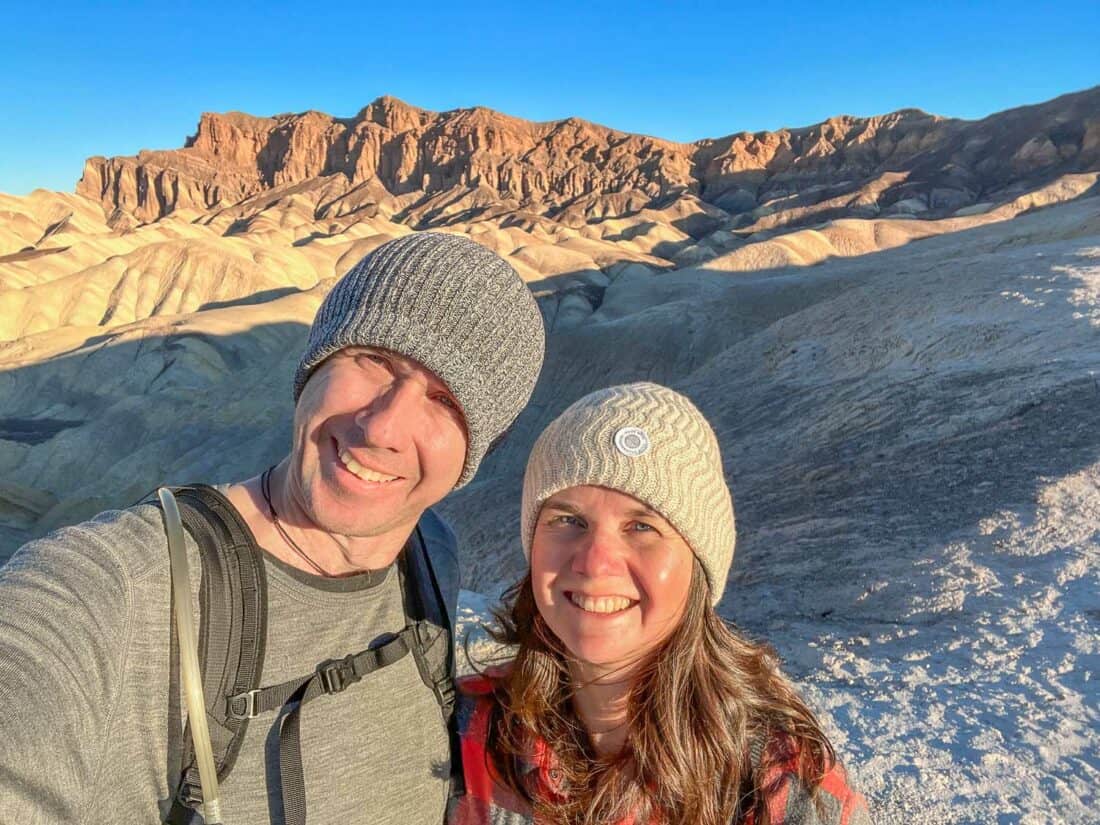
It was magical walking in solitude through the harsh, dry but stunning environment.
It was a little steep and slippy in parts, and you have to walk on a narrow ridge at one point, which was slightly nerve-racking, but overall we didn’t find it a difficult walk and it gets easier when you reach Golden Canyon.
You definitely want to start early and bring plenty of water as once the sun hits the canyon, it feels very hot.
When you reach the high walls of Golden Canyon, you have the option of a one-mile return detour to Red Cathedral, but we skipped it as it involves some scrambling.
It took us 65 minutes to reach the Golden Canyon trailhead (where there’s a toilet) and then we walked parallel to the road for 10 minutes before turning left into Gower Gulch.
Some people don’t think Gower Gulch is worth it but we enjoyed it (and it’s quieter than Golden Canyon). There was some gently scrambling at the beginning, but then it opened up and the ascent was fairly easy. There are some interesting rock formations and green and pink walls.
It took another hour to get back to Zabriskie Point—the last section back on the Badlands Loop was the hardest as it was a steep climb in full sun. The view looking back was astounding though.
Don’t miss hiking in this area. Even if you don’t do the full loop, there are plenty of shorter options.
See a map of the Golden Canyon and Gower Gulch hike on Alltrails or the NPS website for all the Golden Canyon trails.
3) Enjoy a Colourful View at Artists Palette
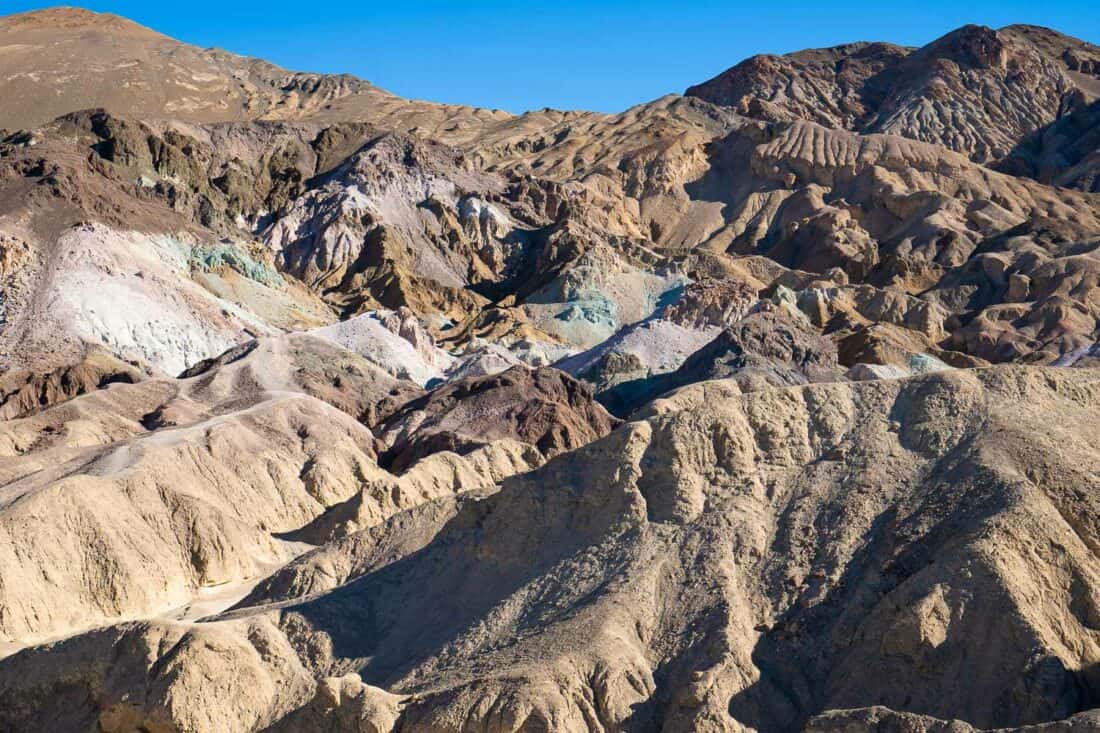
Access: One-way paved road, no vehicles longer than 25 feet Facilities: Toilet in car park Time needed: 30 minutes including drive Distance from Furnace Creek Visitor Centre: 14.5 miles (23.5km)/ 24 minutes
Another of the best views in Death Valley is at Artists Palette. Here you can admire the colourful hills created by mineral oxidation—pink and green mixing with the usual shades of orange and brown.
The viewpoint is accessed on the 9-mile Artists Drive Loop, a beautiful if twisty road that can only be driven one way (starting at the south end off Badwater Rd).
There are various places to stop and take photos, but the third stop (marked on Google Map as Artist’s Palette) is the best one. There’s also a toilet here.
You can see the vibrant hills from the parking lot or walk up the trail as far as you’d like for a higher perspective.
Artists Palette is best visited in the golden hour before sunset. We arrived an hour after sunrise (after visiting Badwater Basin) and the hills were still in shadow so the colours were muted.
We came back another day mid-morning (three hours after sunrise) and the colours were much better, although the light was a little harsh.
This was one of the filming locations for Tatooine in the Star Wars movies and it’s easy to believe you’re on another planet.
4) Watch the Sunset at Dante’s View
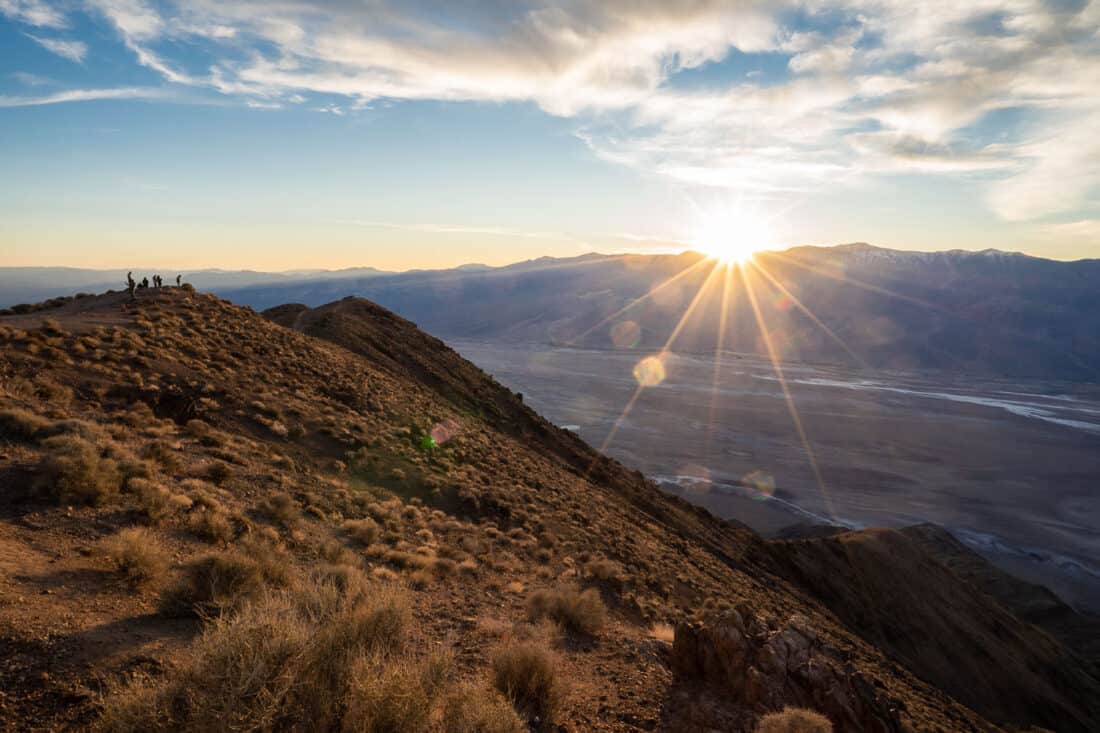
Access: Paved, winding, and steep road. No RVs or trailers (car park to leave trailers lower down) Facilities: Toilet at lower parking but it’s quite far from upper parking—stop on the way up Time needed: 30 minutes – 1 hour Distance from Furnace Creek Visitor Centre: 25 miles (40km)/ 35 minutes
Dante’s View is one of the best places to visit in Death Valley for more spectacular views. It’s popular at sunset, although I’m sure sunrise would also be beautiful (if freezing).
Here you realise that Death Valley is not all desert as you ascend to 5575 ft (1699 m) above Badwater Basin on the ridge of the Black Mountains. The temperature can be 30ºF lower up here.
The sweeping panorama takes in much of the park—the salt flats and the badlands and the Panamint Mountains on the other side of the valley.
You can easily enjoy the view from the parking lot or follow the trails in either direction along the rim (I think the view is best to the left). It’s busy at sunset but easy to find a spot to yourself.
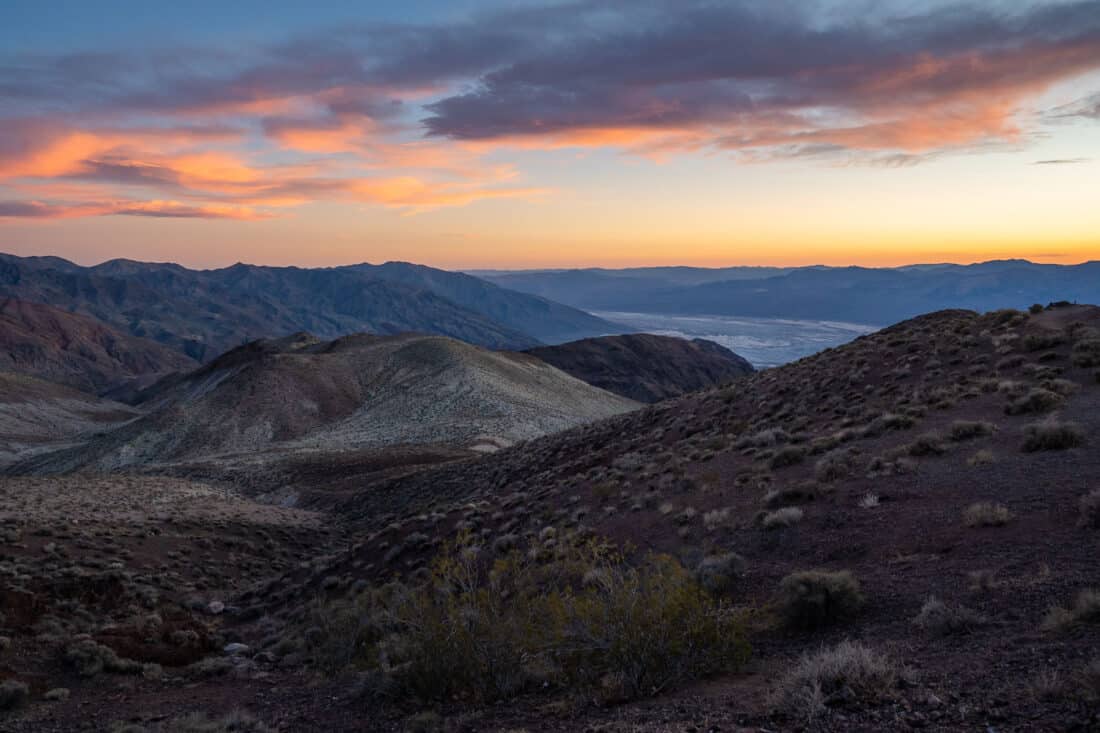
Expect the sun to disappear behind the mountains 10 minutes before the official sunset time. It’s well worth waiting 20 minutes after sunset as the sky lights up in pink and orange and the clouds glow—just gorgeous!
It’s well worth the drive up here for views like this.
5) Visit the Lowest Point at Badwater Basin Salt Flats
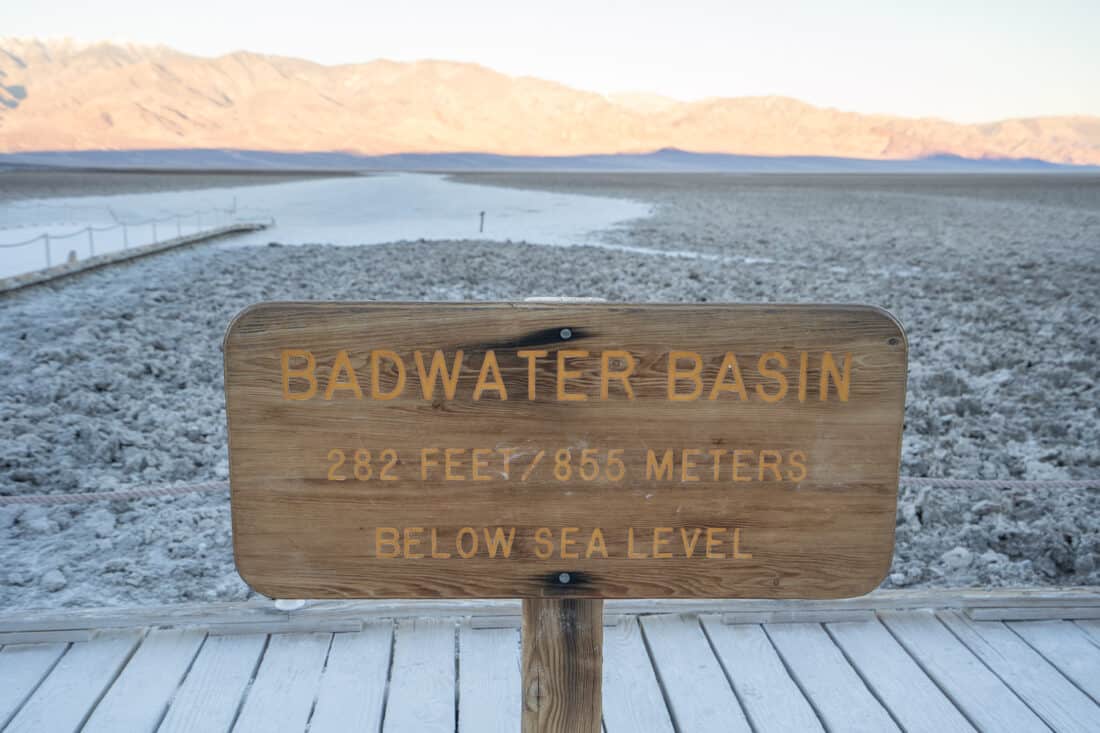
Access: Paved road Facilities: Toilet in car park Time needed: 15 minutes+ Distance from Furnace Creek Visitor Centre: 15.5 miles (25km)/ 20 minutes
Badwater Basin is one of the most iconic spots in Death Valley. This salt pan is an ancient lake bed and is the hottest and lowest point in North America at 282 feet below sea level (look for the sea level marker on the mountain above the parking lot).
Again there’s an easily accessible viewing platform or you can walk out onto the immense salt flats as far as you want.
It’s popular at sunset but there were only a few others here at sunrise. Although we couldn’t see the sun come up, it was beautiful to see the light catch the snowy mountains opposite.
6) Climb a Dune at Sunrise at Mesquite Flat
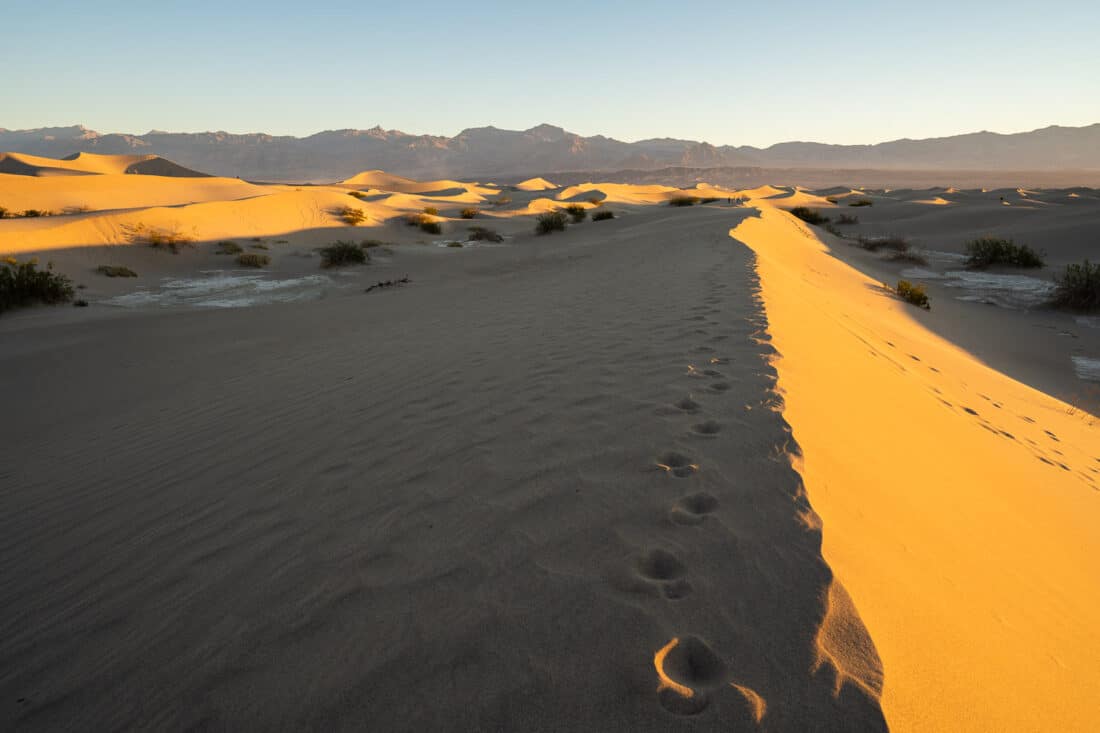
Access: Paved road Facilities: Toilet in car park Time needed: 30 minutes – 1 hour+ Distance from Furnace Creek Visitor Centre: 23 miles (35km)/ 26 minutes
The Mesquite Flat sand dunes are the most accessible sand dunes in Death Valley, next to Stovepipe Wells.
It’s well worth venturing beyond the parking lot and climbing up into the dunes for the best views. There’s no trail—just create your own path.
You can hike to the top of the biggest dune (about two miles return), but walking on sand is hard going so we enjoyed the view from a distance.
We arrived about 30 minutes before sunrise to allow time to get to a good spot—we only had to walk about 10 minutes before we decided on a place to wait. It was another stunning sunrise with the tops of the distant mountains turning pink before the dunes began to glow.
On our way back we had fun running down the dunes (which is less scary than it feels).
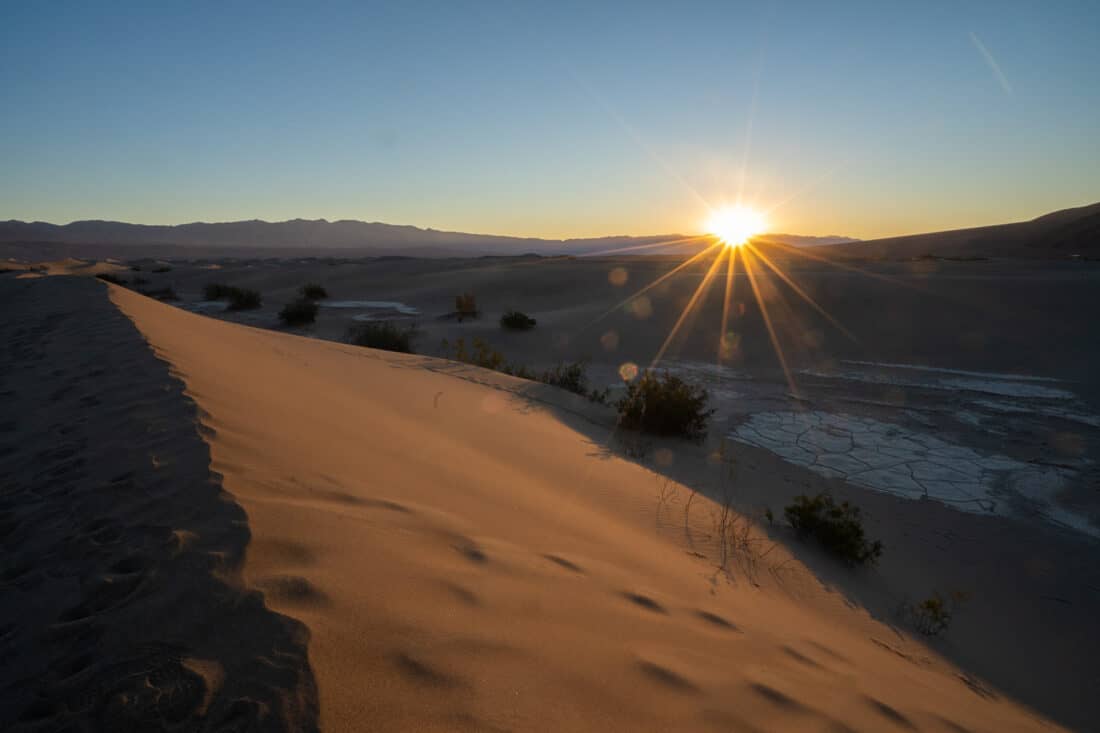
Mesquite Flat is best visited at sunrise or sunset when the light is gorgeous and it’s not too hot. We wore hiking sandals, which were ideal as shoes would fill with sand.
Eureka Dunes are even taller but they are three hours from Furnace Creek and may require a 4WD. It’s much harder to get there for the best light unless you camp nearby.
If you have more time, we also recommend these things to do in Death Valley.
7) Hike the Rim of Ubehebe Crater
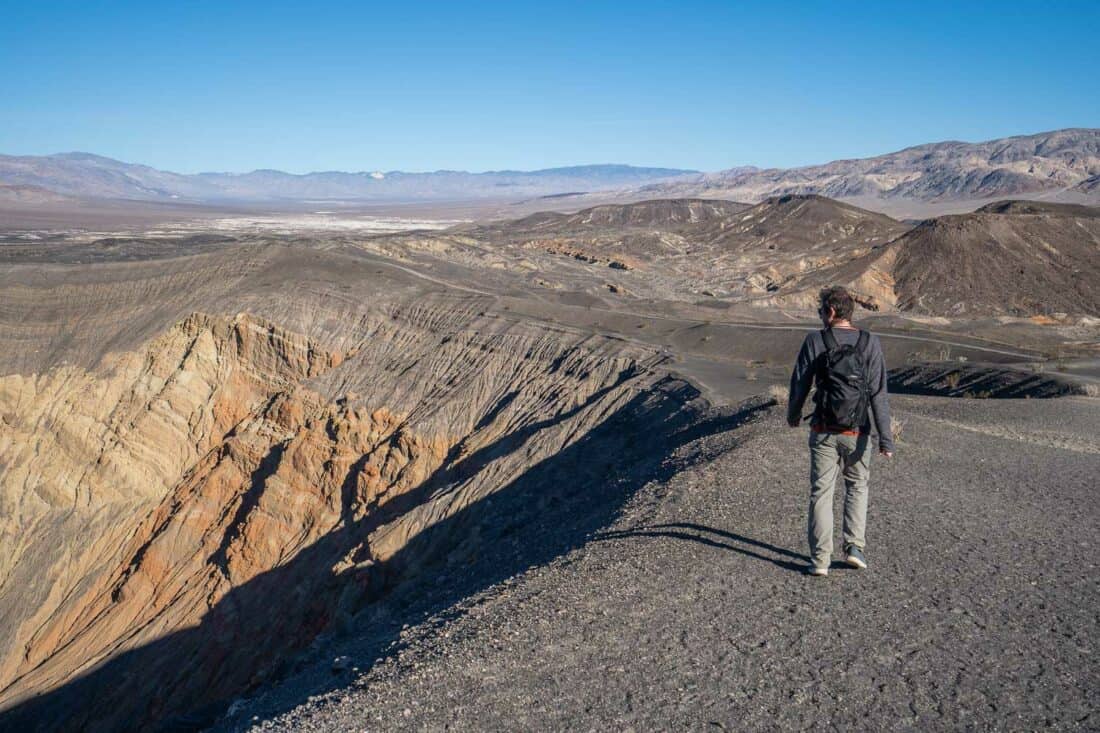
Access: Paved road Facilities: None (nearest toilet 5 miles before at Grapevine Ranger Station) Time needed: 1 hour (longer to descend into crater) Hiking stats: 2 miles (3.2km)/ 50 minutes / 485 feet (148m) elevation gain including Little Hebe Crater Distance from Furnace Creek Visitor Centre: 55 miles (90km)/ 1 hour and 15 minutes
Ubehebe Crater is an extinct volcano in a more remote part of the park. We visited after Mesquite Flat sand dunes, which are an hour away.
We hiked the rim of the 2100-year-old crater, gazing down into the massive expanse—dark grey on one side, orange and gold on the other. It’s a wild and beautiful place—we were the only ones there at 8.30am.
At 2800 feet, it’s cooler than Furnace Creek, but it still felt hot as there’s no shade. We hiked counterclockwise to do the elevation first—the first hill was surprisingly hard going as you’re on loose gravel and sand.
This way you pass the smaller Little Hebe Crater.
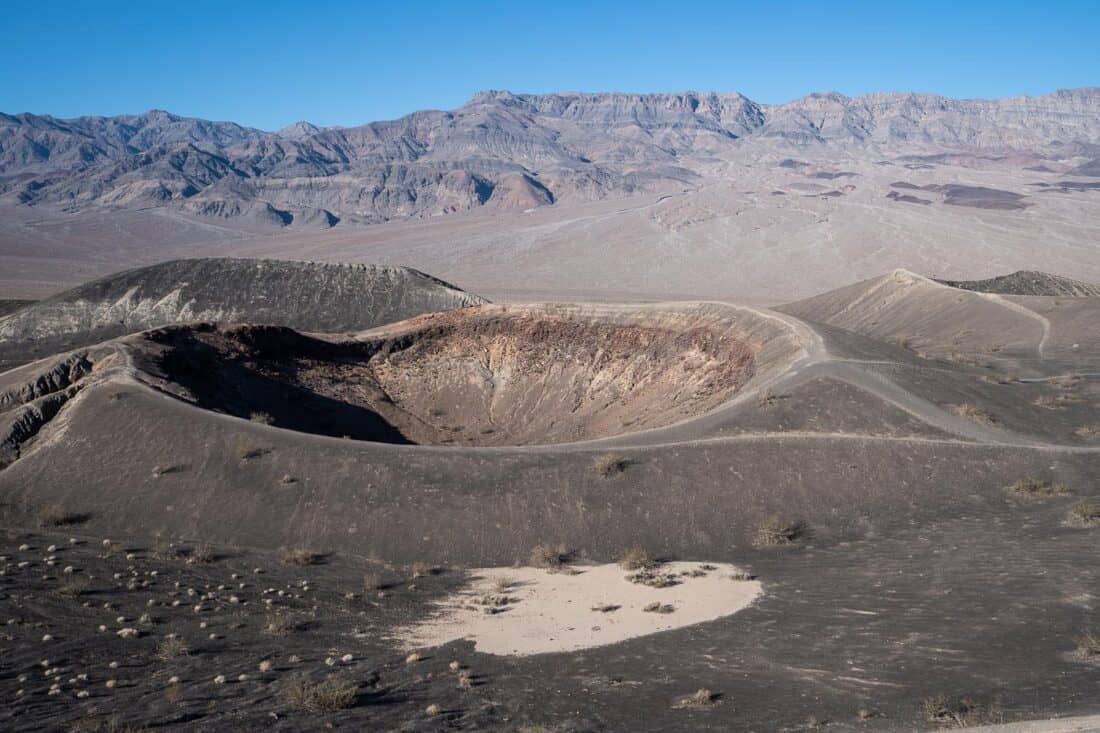
You can also hike down into the crater but expect a challenging climb out in ankle-deep debris.
From Ubehebe you can delve deeper into the park to the Racetrack Playa, but it requires a 4WD. Scotty’s Castle is also in this area, but it’s closed for repairs after a flood until at least 2023.
8) Make a Quick Stop at Devil’s Golf Course
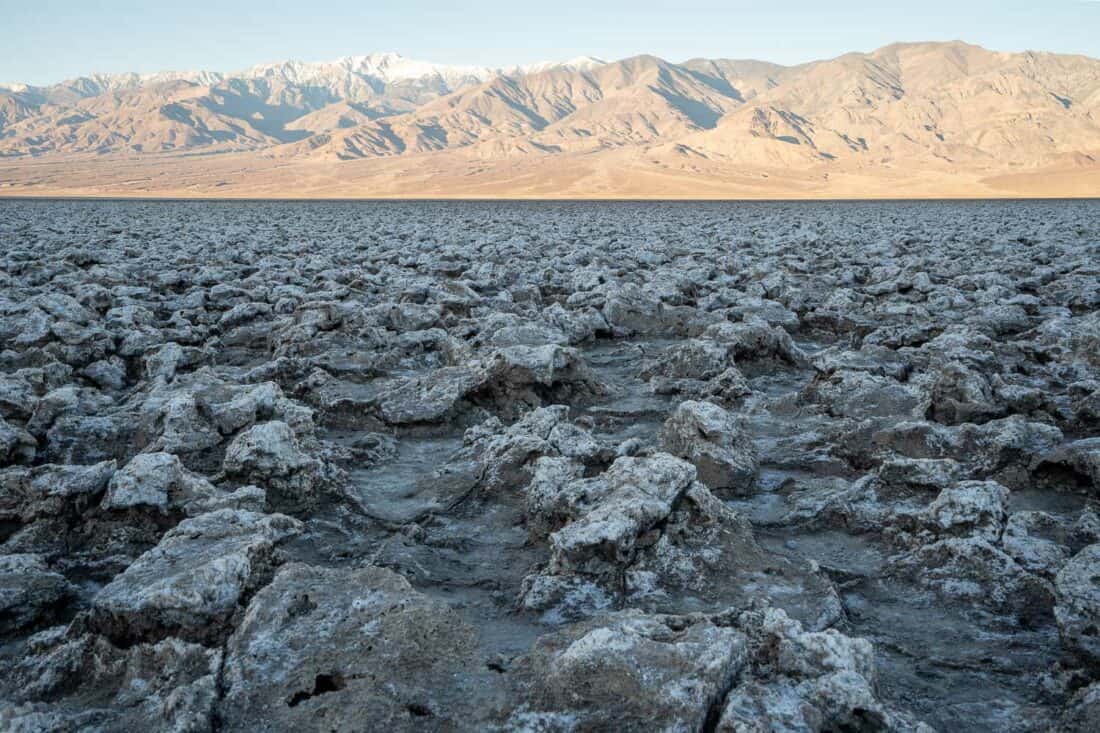
Access: Gravel road off Badwater Rd usually accessible to sedans Facilities: None Time needed: 5 minutes+ Distance from Furnace Creek Visitor Centre: 10 miles (15km)/ 15 minutes
Not far from Badwater Basin is a quick stop called Devil’s Golf Course where rock salt has been eroded by wind and rain into jagged spires.
It’s a cool (and usually quiet) place to see in Death Valley, but you can’t walk on the dangerous sharp rocks. Apparently, only the devil could play golf here!
9) Hike Through Desolation Canyon
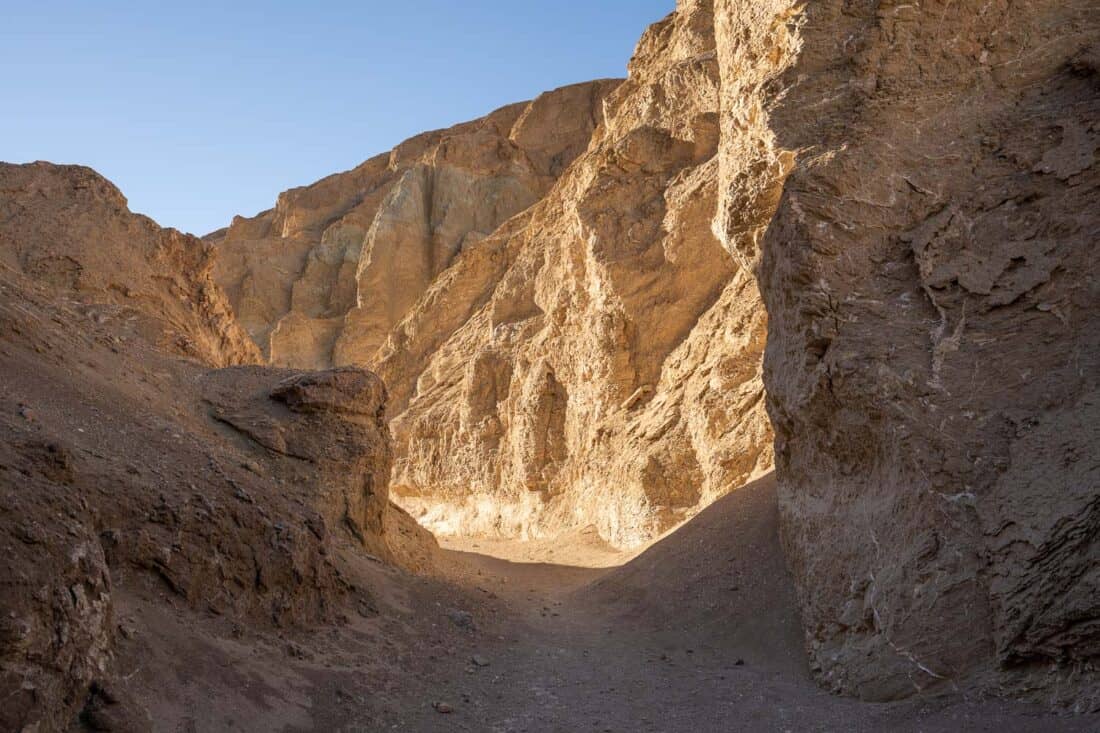
Access: Unmarked gravel road off Badwater Rd usually accessible to sedans Facilities: None Time needed: 1.5 to 2 hours for full hike. Hiking stats: 3.6 miles (5.8km) / 770 ft (235m) elevation gain Distance from Furnace Creek Visitor Centre: 5.5 miles (9km)/ 10 minutes
If you are looking for a quieter hiking trail than Golden Canyon, head to Desolation Canyon.
The hike starts uphill through the canyon and ends with a view of Artists Palette.
We didn’t make it that far as the heat was a bit much and we turned around after 25 minutes/ 1 mile when we reached an 8ft rocky wall that you had to scramble up.
See the Desolation Canyon hike on Alltrails .
The access road is unmarked so you’ll need Google Maps to find it.
10) Drive the Adventurous Twenty Mule Team Canyon
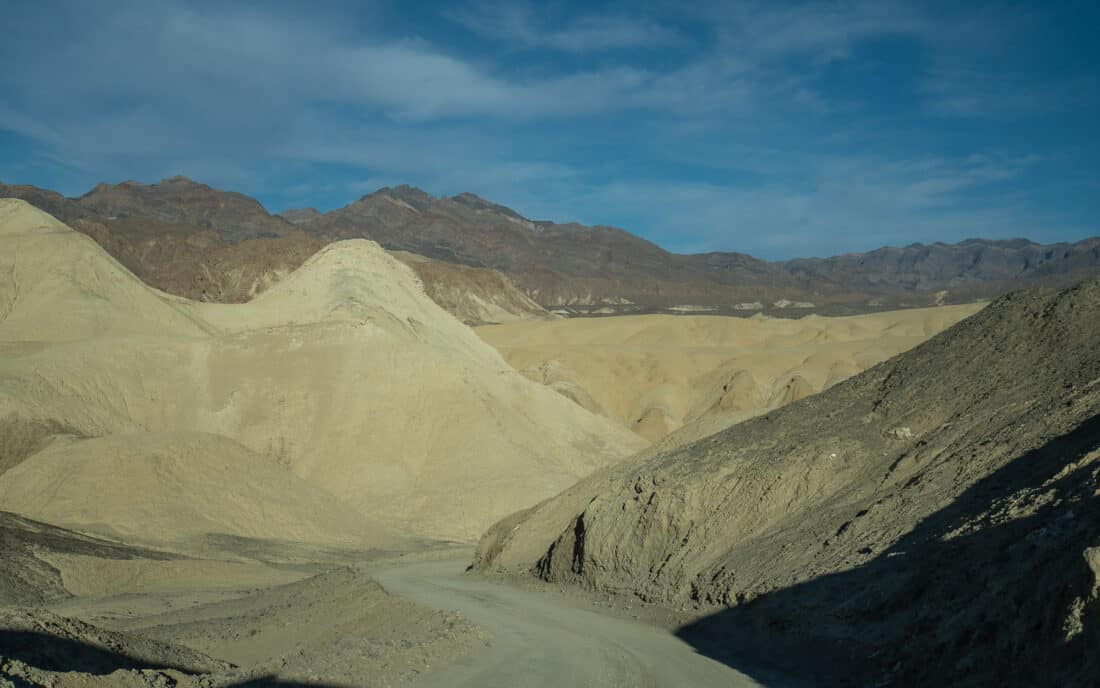
Access: One-way dirt road usually accessible to sedans Facilities: None Time needed: 10-30 minutes Distance from Furnace Creek Visitor Centre: 6 miles (9.5km)/ 10 minutes
We drove the one-way Twenty Mule Team Canyon on the way from Zabriskie Point to Dante’s View. It was only a 10-minute detour (we didn’t make any stops) and worth it if you are looking to get off the beaten track in Death Valley.
It’s not for nervous drivers, though, as the dirt road through the badlands is very narrow, winding, and ends with a steep rollercoasteresque drop.
11) Head Back in Time at Harmony Borax Works
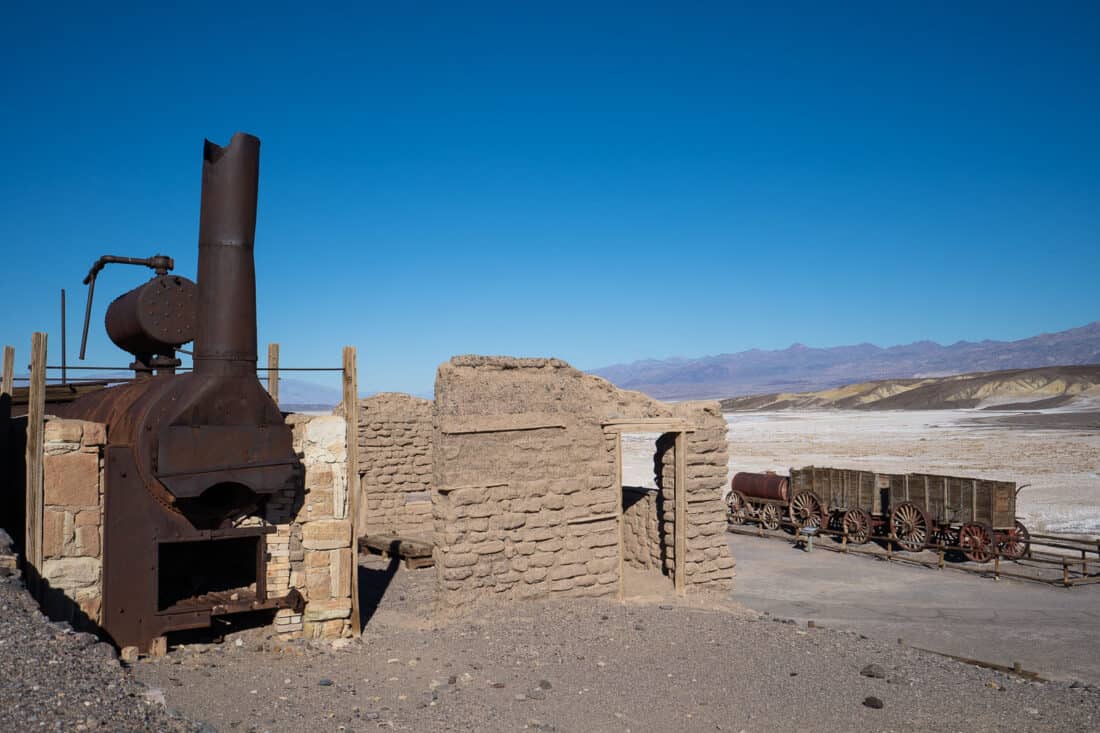
Access: Paved road Facilities: None Time needed: 15-20 minutes Distance from Furnace Creek Visitor Centre: 2 miles (3km)/ 5 minutes
The 0.4-mile history trail at Harmony Borax Works near Furnace Creek is an easy walk and a nice change from other parts of the park.
Signs give you information on the 1884 borax plant as you stroll past the old processing buildings. The wagon on display was pulled by large mule teams (known as the 20-Mule Team) to transport the finished product to market.
Like the Rhyolite gold mine, the plant only lasted a few years.
Harmony Borax Works is one of the best places to see the stars in Death Valley. We were staying too far out to do this, but it’s an easy trip from the Furnace Creek hotels (some guests even biked here).
12) Spot Pupfish on the Salt Creek Trail
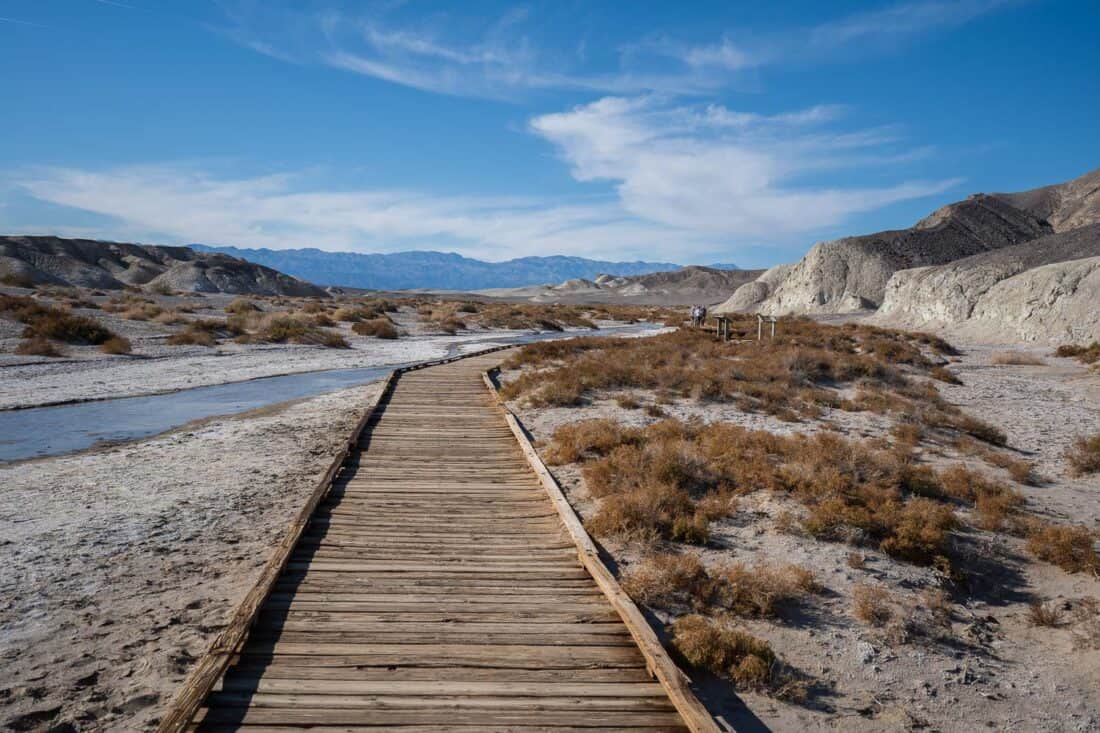
Access: Gravel road usually accessible to sedans. Facilities: Toilet in car park Time needed: 20 minutes Distance from Furnace Creek Visitor Centre: 14.5 miles (23.5km)/ 20 minutes
I didn’t expect much from the Salt Creek Trail, but I enjoyed the easy walk on the 0.5-mile boardwalk loop.
It feels very different from the rest of the park—a little oasis with a pretty stream surrounded by vegetation. The rare tiny pupfish lives in the salty water here.
Salt Creek is easy to add to your Death Valley itinerary as it’s not far from Furnace Creek.
13) Cool Off at The Ranch Lodge
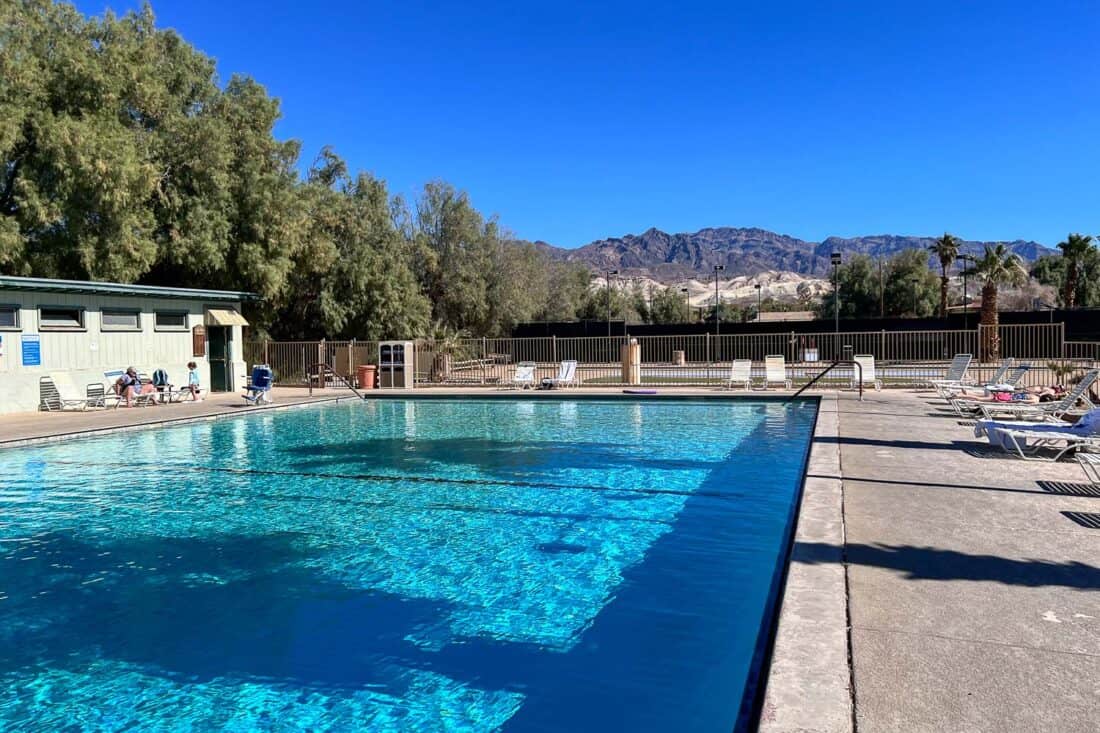
Access: Paved road Facilities: Toilets, stores, restaurants, pool Time needed: 15 minutes – half a day Distance from Furnace Creek Visitor Centre: 0.5 miles (1km)/ 2 minutes
The Ranch Lodge in Furnace Creek has a few facilities open to non-guests that we really appreciated after a hot morning hiking.
There’s an old-fashioned ice cream parlour where you can sit at the counter or on the outside terrace to enjoy a sundae, cone, or milkshake. It’s not the best ice cream, but you won’t care in the heat.
There’s also a general store, outdoor store, restaurant, golf course, and horse riding.
Best of all, the hotel allows non-guests to access the pool for $14. This was so refreshing after a morning of hiking and the perfect way to spend the heat of the day.
The large spring-fed pool is naturally warm year round so it’s comfortable to swim even in winter.
It’s worth leaving the park and heading across the border to Nevada for some interesting attractions.
14) Visit Rhyolite Ghost Town
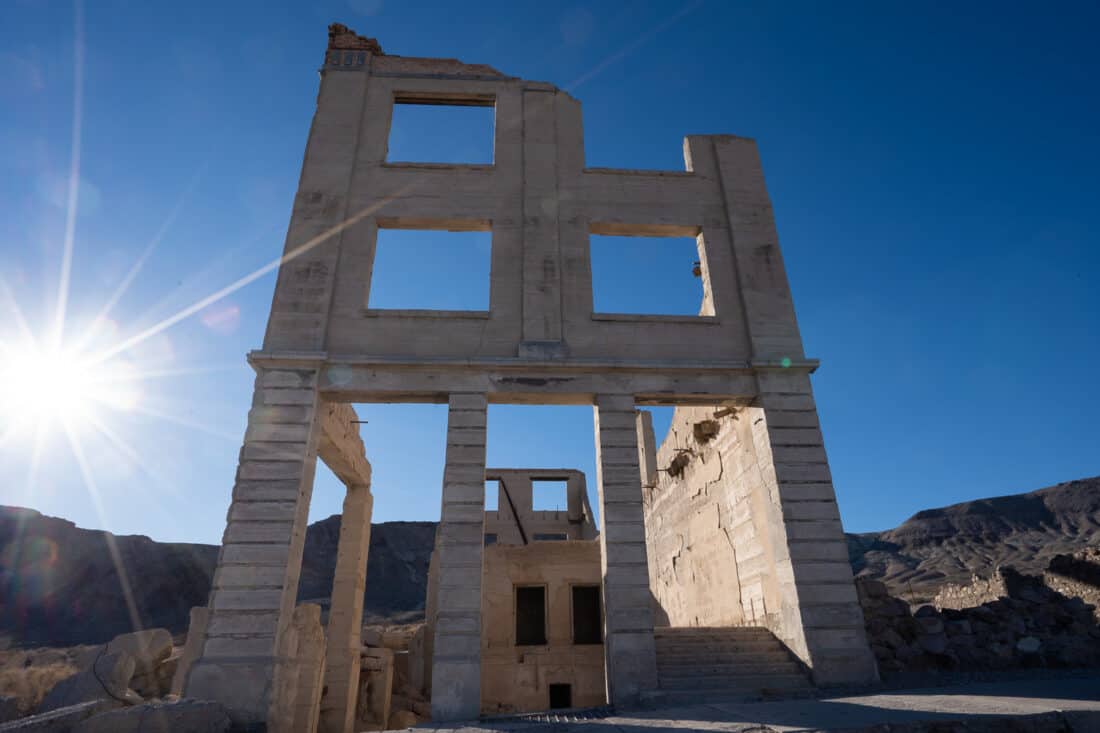
Rhyolite ghost town is one of the most unusual things to do in Death Valley (even if it is outside the park).
This remote gold mining town thrived in its brief boom years—there was a train station, general store, bank, school, miner’s union and more—but it didn’t take long until the gold ran out.
You can now wander past the ruins of its glory years—most of the buildings were built in 1906 and 1907 and the mine shut down just a few years later.
Surrounded by dramatic desert mountains it’s a bleak but intriguing place.
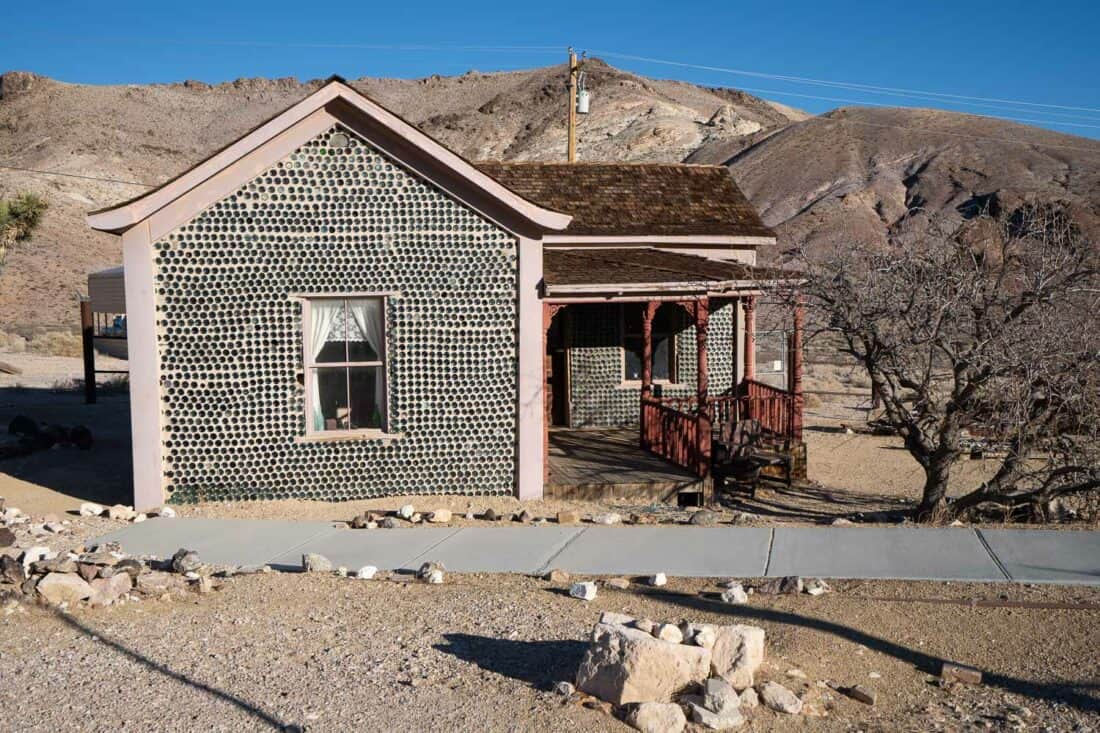
One of the most interesting sights is Tom Kelly Bottle House—the house was made with thousands of glass bottles as wood was hard to come by.
If you are staying in Beatty, you should definitely stop at Rhyolite. It’s free entry and open 24 hours.
15) See Burros in Beatty
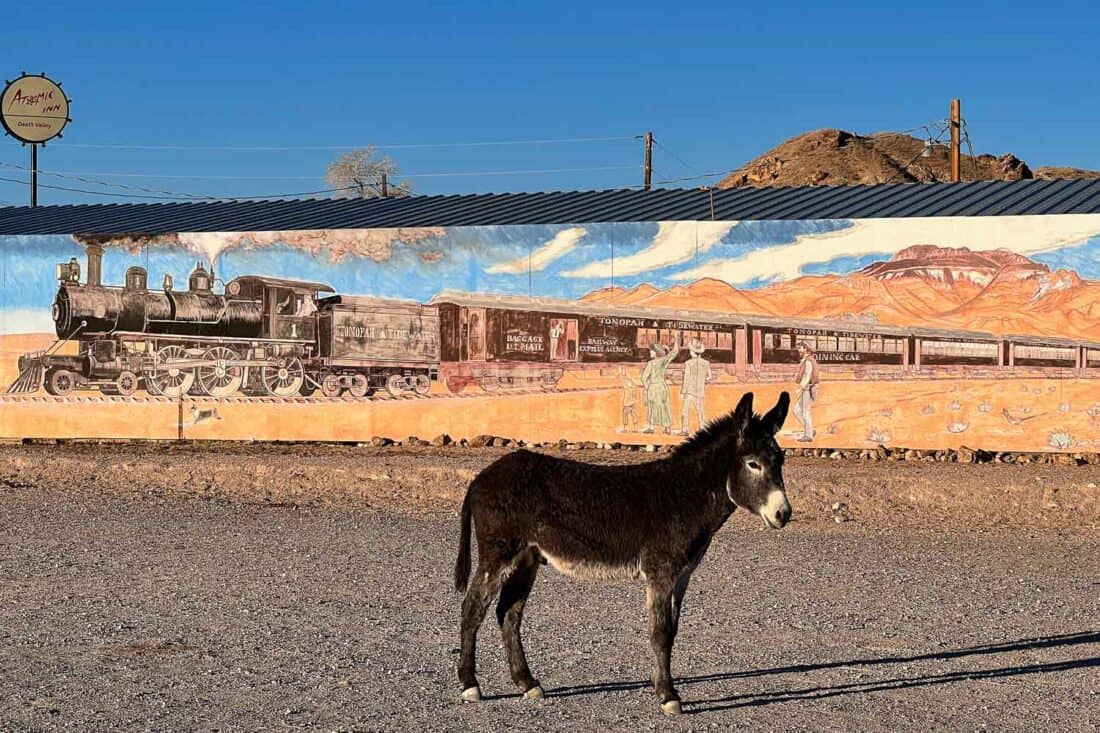
Beatty is a small desert town in Nevada and one of the most affordable bases for exploring Death Valley. It has a remote, Wild West vibe with a wooden saloon on Main St (sadly closed).
Best of all, you can often see wild burros roaming the streets. These donkeys were used in the gold mining days and let free when the industry went bust.
If you only have two days in Death Valley, this is the itinerary I recommend.
- Zabriskie Point for sunrise
- Hike Golden Canyon and Gower Gulch
- Lunch/Rest (maybe enjoy the pool at The Ranch)
- Harmony Borax Works
- Twenty Mule Team Canyon
- Dante’s View for sunset
- Mesquite Flat sand dunes for sunrise
- Ubehebe Crater
- Salt Creek Trail
- Artists Palette (1-2 hours before sunset)
- Devil’s Golf Course
- Badwater Basin for sunset
If you have any extra time, add Desolation Canyon or Rhyolite and Beatty.
The best places to stay in Death Valley are in the heart of the park at Furnace Creek. Here you are close to popular attractions like Zabriskie Point (just 10 minutes away), which makes it much easier to be there for sunrise and sunset.
There are two hotels here— The Ranch at Death Valley is more affordable and family-friendly and The Inn at Death Valley is very expensive. Both of them book up far in advance though, so we couldn’t get a reservation (booking three weeks out in winter).
Camping is a budget option in Furnace Creek and various locations within the park.
Stovepipe Wells is another place to stay within the park. Stovepipe Wells Village Hotel isn’t as convenient for Zabriskie Point (35 minutes away), but it’s closer to the Mesquite Flat sand dunes and is more affordable than Furnace Creek.
As we couldn’t get a hotel in the park, we rented an Airbnb in the nearest town outside the park—Beatty, which is actually in Nevada.
We loved the quirky, stylish house, but the location did feel further away than we’d like, and we had a lot of 5.30am starts to see the sunrise in the park.
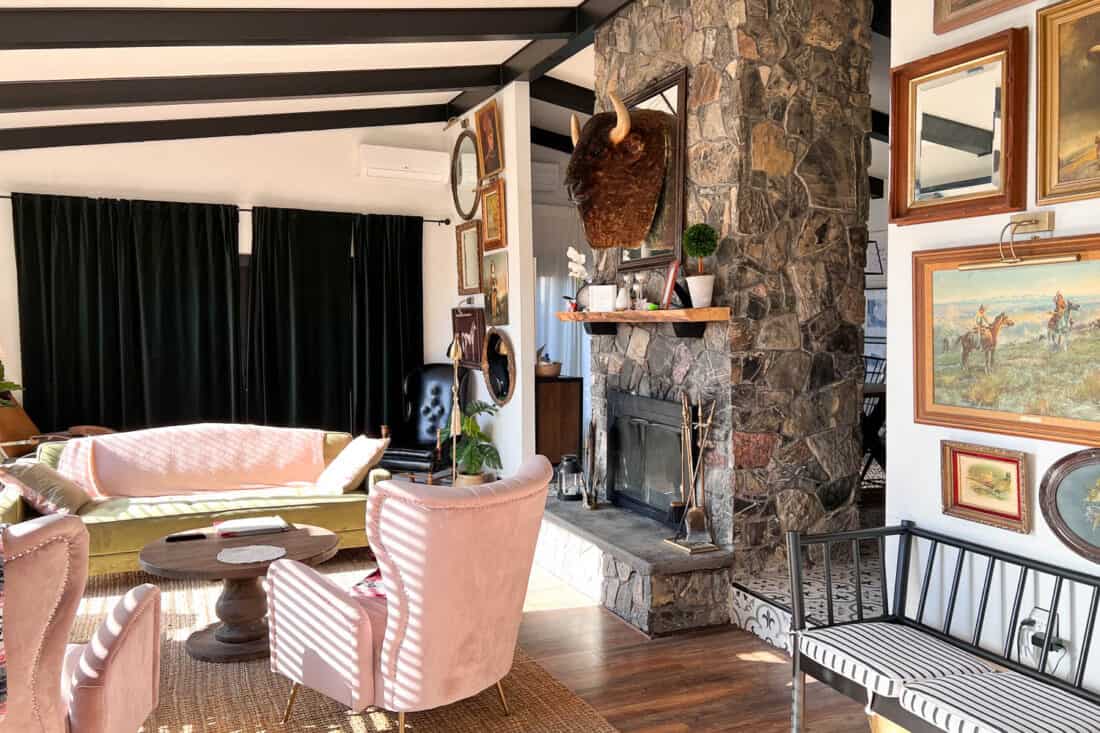
Although Beatty is an easy 40-minute drive from Furnace Creek, you have to bear in mind how spread out the sights are, so we usually had to drive for about an hour.
But if accommodation in the park is unavailable or too expensive, Beatty is a good option. There are a few budget motels here including Death Valley Inn and Exchange Club Motel .
- There are no entrance gates. Pay the $30 fee (per vehicle) when you arrive at the visitor centre or some popular spots have ticket machines next to the parking.
- An America the Beautiful annual national parks pass can also be used (display it in your car). This is excellent value if you’ll visit three or more national parks or monuments in a year.
- The best time to visit is early spring or winter. It’s excessively hot in summer and will be dangerous to hike.
- Even in winter, it was hotter than we expected—coming from Beatty before sunrise the temperature rose from 35ºF to 60ºF as we descended into the park. In the afternoons it reached 90ºF. Be prepared with a hat, sunglasses, and sunscreen.
- In winter wear layers for the cool mornings and hot afternoons.
- Bring a cooler with lots of water and food. There are no shops or restaurants outside Furnace Creek and Stovepipe Wells.
- A 4WD vehicle is a good idea and will allow you to explore further into the park, but it’s not necessary for the Death Valley top sights on this list. We rented an SUV (without 4WD) and appreciated the higher clearance, but we saw sedans on all the roads we drove. We use Rental Cars to search for the best deals.
- There’s no cell signal in most of the park so save Google Maps offline for directions.
- The Alltrails app is useful if you plan to hike. We bought the Pro plan so we could save route maps offline.
- Fill up with gas outside the park (Beatty is a good spot) as it’s very expensive at Furnace Creek. Stovepipe Wells is slightly cheaper but still well over regular prices.
- Don’t enter canyons if there’s any sign of rain.
- Leave no trace—don’t litter or take any rocks or plants with you.
Yes, Death Valley is absolutely worth visiting! It’s a huge and diverse national park with so much to explore.
Just make sure you visit outside the summer to experience the inhospitable landscapes more safely and enjoyably. At any time of year it’s always worth getting up early for the best views and most comfortable temperatures.
I hope this post has given you some ideas of what to see in Death Valley. Let us know your favourite places!
Southern California
- 23 Unmissable Things to Do in Southern California
- 14 Best Hikes in Joshua Tree National Park
- Borrego Springs Sculptures: The Ultimate Guide to Galleta Meadows
- 18 Best Outdoor Activities in San Diego
- Disneyland & California Adventure in One Day: An Itinerary for Adults
Northern California
- The Best 3 Day Yosemite National Park Itinerary
- 17 Best Things to Do in Sonoma California
- Mono Lake in California: Visit the Stunning Tufa Towers Near Yosemite
- Visiting Bodie California Ghost Town: Everything You Need to Know
If you enjoyed this post, pin it!
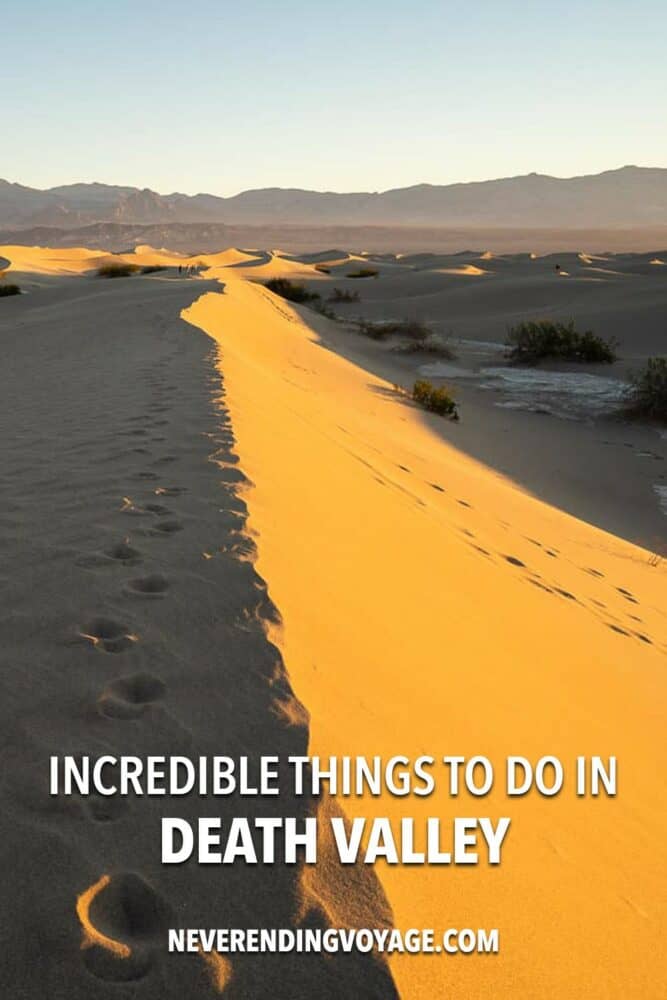
Leave a Reply Cancel reply
Required fields are marked *. Your email address will not be published. By clicking the Submit button, you give consent for us to store your information for the purposes of displaying your comment and you accept the terms of our Privacy Policy .
This site uses Akismet to reduce spam. Learn how your comment data is processed .

Your Death Valley Visitor Guide: Comprehensive Travel Tips
Sure, Yosemite’s mountains are showy and California’s redwoods are towering, but Death Valley isn’t trying to be your best friend. It’s going to challenge you. The park presents a stark, sharp landscape that rewards visitors who are looking for something more edgy.
If that’s you, then read on because this guide will help you plan your Death Valley visit. I aim to be helpful, so this guide is stuffed with practical tips about the park, suggested things to do, an accommodation guide and packing ideas.
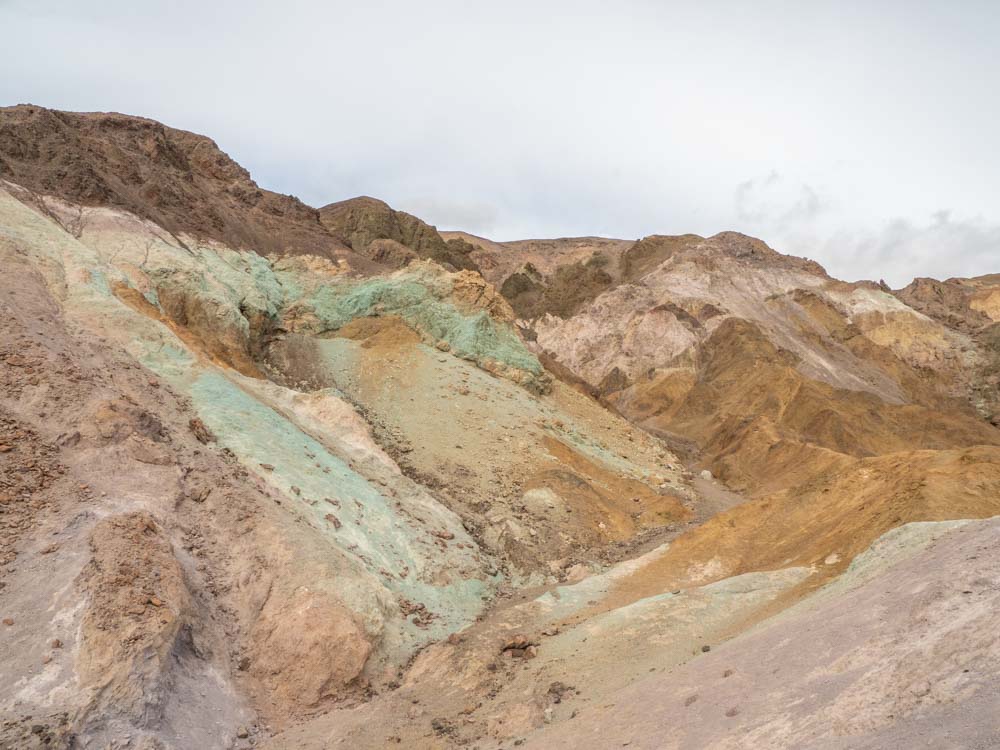
(This article contains affiliate links. This means that if you choose to purchase, I’ll make a small commission.)
You can trust me to give you accurate Death Valley travel planning tips because I actually live in California and visit Death Valley at least every other year. I encourage you to scroll the whole article. But if you have particular questions, use this handy table of contents to skip around.
- Why visit Death Valley
- Info on the Death Valley Visitors Center
- How to get to to Death Valley
- How many days do you need for Death Valley
- Top things to do in Death Valley National Park
- The best time to visit Death Valley
- Where to stay in Death Valley
- Food, gas and cell service
- Guided tours
- What to pack
Why Visit Death Valley
Death Valley is named for the doomed efforts of pioneers who, in 1849, were desperately seeking passage through the southern Sierras. This hot, dry landscape is an unforgiving place for a lost wagon train, but the pioneers persevered. After the establishment of California, Death Valley became a borax mining boom-town in the 1880’s.
In the 1920’s the Pacific Borax Company engaged in a generous act of corporate philanthropy when they lobbied the US government and local citizens to to turn their cash cow into a protected space. The area was designated a National Monument in 1933, and then a National Park in 1994.
Death Valley’s topography includes a vast salt lake bed, which is the lowest spot in the US at -282 feet. In stark contrast, the lake bed is dwarfed by the 11,000 foot Telegraph Peak. There are eroding sandstone cliffs, canyons, volcanic craters and cliffs “painted” with mineral deposits.
The lonely remnants of Death Valley’s mining boom also add historical interest to the park. This forbidding landscape and hard scrabble history has a lot of stories to tell, which is why visiting Death Valley National Park is such a treat.
For more background, check out some of our fun facts about Death Valley .
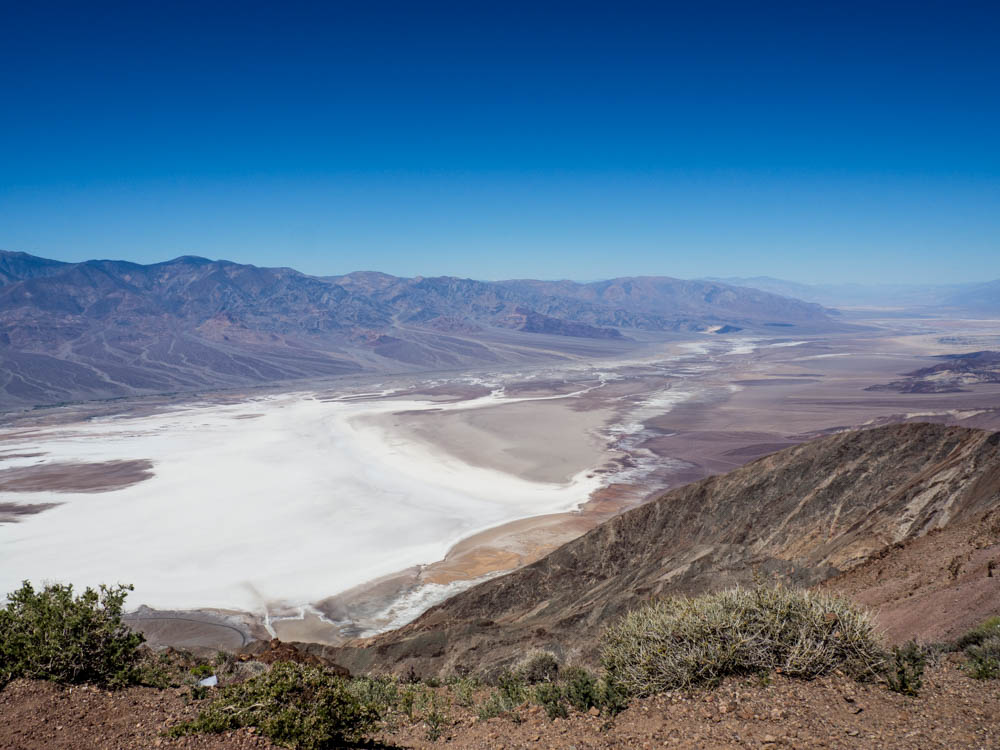
Death Valley National Park Visitor Center & Fees
Death Valley actually covers 5,200 square miles of the Mohave Desert. But many of the top things to do in Death Valley are located in a centralized area near Furnace Creek, which is also where the Visitor Center is located.
At the Visitor Center you can also check in for the nearby campgrounds, get advice on how to visit the park’s attractions, get hiking suggestions (with maps), and visit the bookstore. They also have museum exhibits on the park’s history and geology. And you can sign your kids up for the Junior Ranger program.
The Furnace Creek Visitor Center is open most days from 8a-5p.
Death Valley Passes
Death Valley has 5 roads that enter the park and none of them are gated. Access into the park is open all of the time. But you do still need a pass to visit. And the only way to get a park map, is to buy the pass.
The entrance fee for Death Valley is $30 per vehicle for a 7-day pass. Motorcycles are $25 and people traveling on foot (who does that in Death Valley?) or bike (ditto!) are $15. An annual pass to Death Valley is $55.
You can also use the $80 America the Beautiful National Parks annual pass , the free Military and Veterans pass or the $80 Senior lifetime pass to access the park.
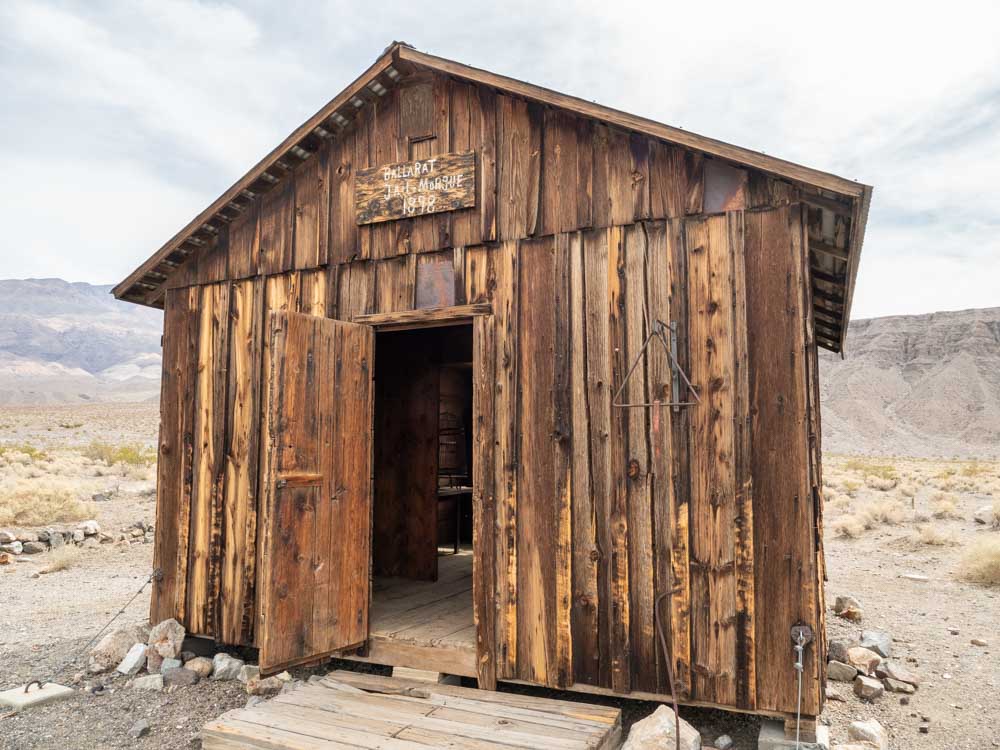
How to Get to Death Valley
How far is death valley from los angeles.
LA to Death Valley : 271 miles, 4.75-5.25 hours.
The fastest route is via Ridgecrest and the Panamint Valley. If you go that way, we suggest that you stop into Ballarat Ghost town on the way in.
You can take an a bit of extra time and go in via I15 through Baker and Death Valley Junction. That route allows you to detour down to Dante’s View .
You can even combine Death Valley with a road trip to Joshua Tree National Park . This is a routing that we recommend on our list of the top 20 scenic road trips in CA .
How Far is Death Valley from San Francisco?
SF to Death Valley : 502 miles, 7.5-8.5 hours.
The most reliable way is down I5 or Hwy 99 down to Tahachapi and then into the park via Ridgecrest. I prefer Highway 99 to I5 because there’s less truck traffic and you drive past some pretty orchards along the way. Check out our looping route between SF and Death Valley which has some interesting stops around Ridgecrest and the Central Valley.
The scenic way to get from San Francisco to Death Valley is west on Highway 120 through Yosemite/Tioga Pass to Highway 395. This route has amazing scenery. Make time for extra stops, or even better, add on extra days using our Highway 395 road trip itinerary.
This route requires a Yosemite entrance fee and it’s not open in the winter. The closure is usually from November to late-May, but check the Yosemite National park site for status.
How Far is Death Valley from Las Vegas?
Las Vegas to Death Valley : 111-142 miles, ~2 hours.
Las Vegas is actually the closest airport to Death Valley . There are several ways to do the routing. One takes you near Dantes View and the other comes in further north and goes past Rhyolite Ghost Town .
This guide for doing Death Valley as a day trip from Las Vegas , explains the options and offers key stops.
How Long is the Death Valley Road?
People Google this question but it’s a difficult one to answer because there are many roads in the park and none of them are called “Death Valley Road”.
That said, Highway 190 is the major northeast-to-southwest thoroughfare through Death Valley. It runs 187 miles from Olancha (south of Lone Pine) to Death Valley Junction.
Where is the Death Valley Entrance?
There is no single entrance into Death Valley, but there are three main entrances that most people use. The first is to come in from Highway 395 at Lone Pine. The second is to come up the Panamint Valley Road from Ridgecrest. The third enters west into the park from Death Valley Junction.
There are two less popular but scenic routes. There’s Highway 178 which goes north from Shoshone into Badwater Basin. The other takes the narrow high road on Immigrant Canyon Road, which goes over a 5,300 foot pass.
Is Driving in Death Valley Safe?
Yes. If you are worried about road conditions, all of the top sights listed here are accessible from paved roads. Some of the dirt roads are graded and accessible for normal passenger cars but others are only recommended for all 4×4 vehicles with clearance. The Park Service map has very clearly marked guidance on roads.
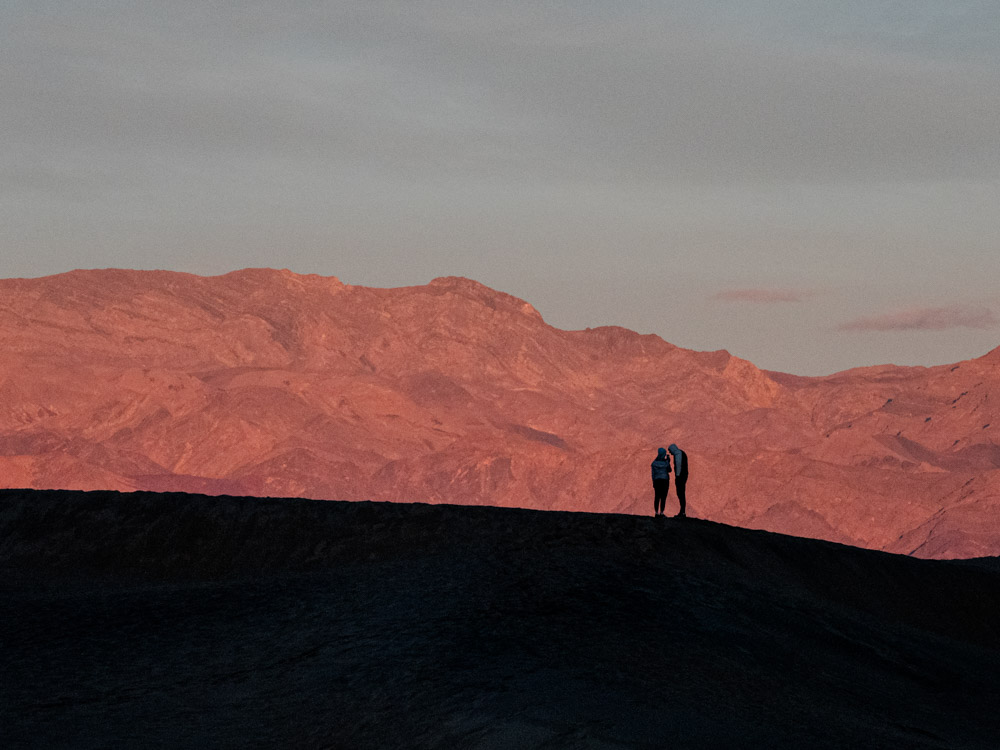
How Much Time do You Need for Death Valley?
Is one day enough for Death Valley? Not really. It’s the largest national park in the continental US and there is a LOT to do and see. That said, some of the most popular sights are centrally situated. With the help of our Death Valley day trip guide , you can see many of the highlights in one day if you don’t mind scurrying around.
Two days will allow you to visit Death Valley’s top sites with time for some longer hikes. Here’s our two-day itinerary .
And a three day Death Valley vacation will allow you to add in yet more hikes in the park.

Top Things to Do in Death Valley
There are so many cool things do to in Death Valley, it’s hard to figure out how to prioritize. We recommend doing a mix of scenic vistas, hikes and historic sites. That way, you’ll get a great sense of what the park is all about.
Mesquite Dunes at Dawn or Dusk
One of the best ways to get your awe inspired in Death Valley is to get up and out before dawn. The warm light against the orange sand is a beautiful wake-up call and this is a fantastic spot for an early morning photo shoot.
Badwater Basin
Badwater basin is the vast drainage aquifer for Death Valley, covering nearly 200 square miles of daunting salt flats. At -282 feet, it’s the lowest spot in the United States. It’s called “badwater” because a surveyor found that his mule wouldn’t drink the extremely salty water. You can visit anytime of day, but the valley is particularly beautiful at dusk, when the sun is setting over Telescope Peak to the west.
The Golden Canyon Gower Gulch Hike
The Golden Canyon trail in Death Valley is popular…and for good reason. While hiking you enter an ancient portal into Death Valley’s unique geology. You leave the flats of Badwater Basin behind and enter the canyon’s narrow runway, flanked by yellow and red rock formations and intriguing tentacles along Golden Canyon’s side shoots.
Most people just do the Golden Canyon hike but we recommend taking the time to add on the Gower Gulch loop. It will give you views of the Badwater Basin, Zabriskie Point geology and some of the colorful mineral deposits that characterize the area. Here’s our full guide for hiking Golden Canyon and Gower Gulch.
Artists Palette Drive
This scenic drive is located in the Badwater Basin, so you can add it on before or after doing the Golden Canyon hike or Badwater Basin viewpoint. The Artists Palette one-way, nine mile drive will take you through an amazing geologic rainbow. One option is to simply do the drive and get a quick view of the eye candy. But I recommend that you can stop at the multiple pull-outs along the way.
You’ll be rewarded if you get out of the car and hike closer to these multi-hued rock formations. The second pullout has particularly good access for getting into the colorful side canyons.

Zabriskie Point at Dawn
Zabriskie Point at dawn is a must see for your Death Valley trip. The point has generous folds of sandstone in the foreground with the Panamint Mountains as a backdrop. Dawn is pretty enough with the morning sun lighting up the Panamint mountains in pink, but things get really interesting about 20 minutes later when the sun rises a bit more and starts throwing shadows onto the sandstone canyon below. From there, you can head down into the canyon for the 2.7 mile Badlands Loop hike. Zabriskie Point is a short ten minute drive from Furnace Creek.
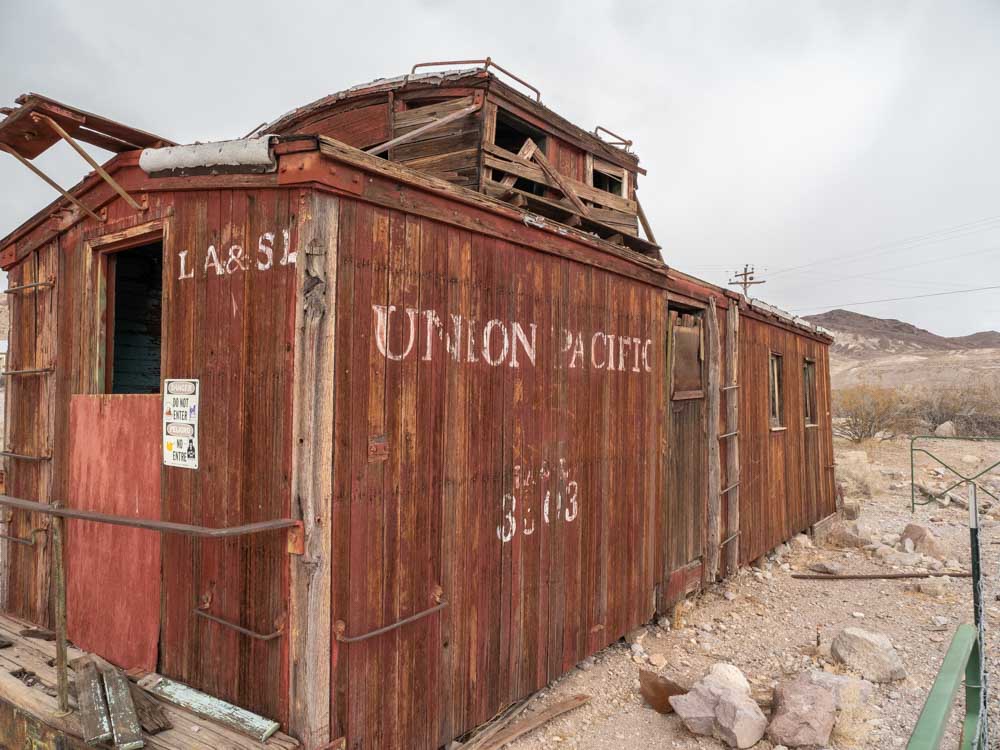
Ryolite Ghost Town
Technically, Rhyolite is just outside of the park boundary. But since mining was such an important part of Death Valley’s history, it’s worth visiting. Rhyolite’s crumbling infrastructure offers a great lesson on California’s unpredictable mining history. The town went from boom to bust in just 20 short years. On site, you can poke around the building ruins, old rail cars and a cool building make of soda bottles. You should also visit the nearby Goldwell Sculpture garden.
If you like dusty and abandoned spots, check out this guide to California ghost towns . It includes a few others that are near Death Valley.
Dante’s View
Dante’s View is 25 miles southeast of Furnace Creek. At a height of 5,400 feet, you’ll get wide angle panoramic views of the Badwater Basin and the Panamint mountain range.
The other cool thing about Dante’s View is that it’s the same view that Luke, Obi Wan, C3PO and R2D2 had when they were headed into Mos Eisley. And if you are a Star Wars nerd, the Twenty Mule Team Drive, Golden Canyon, Desolation Canyon, Mesquite Dunes and Artist’s Drive were also filming locations.
May the force be with you.

If You Have Extra Time
Ubehebe crater.
The Ubehebe Crater is 58 miles north of Furnace Creek. Death Valley visitors who are in a hurry quite often don’t make the time for it, but I found the crater fascinating. This unique formation is a 600 foot deep inverted volcano. It was formed when gases and magma built up and then exploded all over the surrounding desert floor. The resulting geology has created layers of colorful and textured rock deposits. While there, you can circumnavigate the 1.5 mile rim and/or walk down to the bottom of the crater.

Harmony Borax Works
Borax is a compound used in many detergents and other household products. It’s not as sexy as gold, but during the late 1800’s it was a major part of Death Valley’s mining operations. The Harmony Borax Works offer a quick history lesson on Death Valley’s mining history. It’s located just a few minutes north of Furnace Creek.
20 Mule Team Road
This 2.5 mile one way dirt road takes a drive into the landscape below Zabriskie Point. The short drive takes you through an eroded spare landscape and there is a short .3 mile hike to a nearby overlook.
Sidewinder Canyon Hike
This hike isn’t as popular as Golden Canyon, but it’s quite rewarding for the patient hiker. It’s billed as a 4 mile out and back hike, and the attraction is exploring the four slot canyons that branch off of the main route. They are a revelation and reminiscent of Antelope Canyon in Arizona. Check out our Sidewinder Canyon hiking guide — it has practical tips for how to do the hike with some cool pics that will make you want to go now.
Mosaic Canyon
This 3.5 mile hike takes you through yet another slot canyon with quite a variety of rock textures. If you’re short on time, you can simply wander partway into the canyon and then head out for your next adventure.
Natural Bridge
This 2 mile out and back will take you to a lovely red rock arch. It’s located in Badwater Basin.
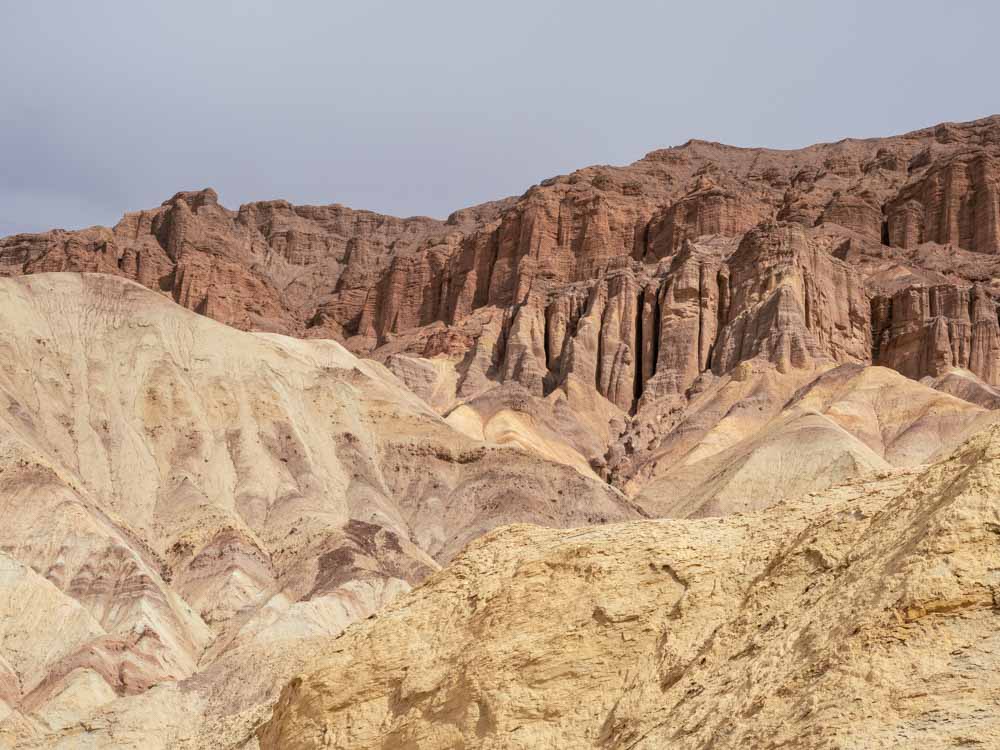
The Best Time to Visit Death Valley National Park
The short answer is February/March for pleasant temps and (maybe) wildflowers. Mid-October through December is also very pleasant. The long answer can be found in our when to visit Death Valley article . It includes a temp and precip chart, advice on how to visit in the hotter months and more detail about less busy months.
Whatever you do, try not to go during the summer. It’s often 115′ during July and August. That sort of heat will prevent you from being able to do much of the hiking and sightseeing on this Death Valley itinerary.
If you are visiting Death Valley as part of a larger trip, check out our season-by-season guide for CA to get more itinerary ideas.
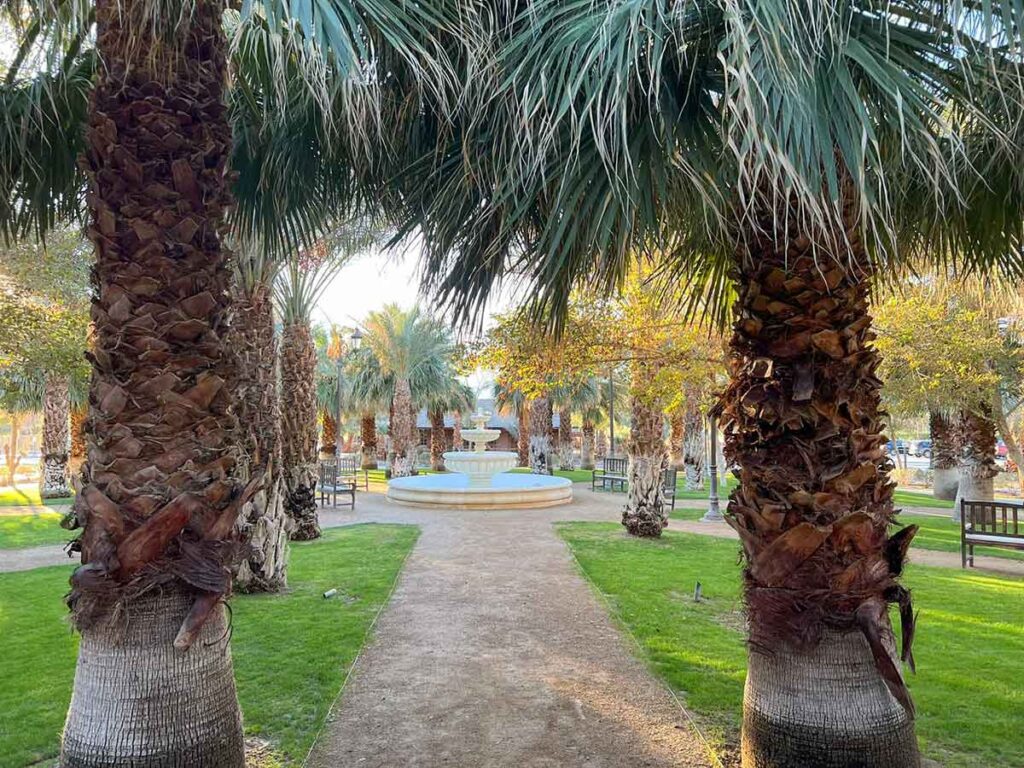
Where to Stay on Your Death Valley Trip
There are 12 private and public campgrounds in Death Valley, disbursed across the 5,200 square miles of the National Park. Which campground you choose will be dependent upon whether you want to be in the thick of things or out in the hinterlands. Use our guide to all Death Valley campgrounds and find the right option for you. You can also book a glamping tent in Panamint Springs .
If you prefer a hotel stay, there are three hotels within the park. They range in quality and, frankly, none are a fabulous deal for the money. But if you aren’t camping, it’s worth staying at one of these three places because the nearest lodging outside of the park is 60 miles away. However, book early because during high season, these lodgings fill up fast.
We have a full hotel guide that also gives suggestions for more budget-friendly places to stay outside of the park.
- The Inn at Death Valley is a fancy historic inn, with lovely grounds and a nice restaurant. Check reviews and book with Booking.com .
- The Ranch at Death Valley is a centrally located family-friendly place in Furnace Creek. Check reviews and book with Booking.com .
- The Stovepipe Wells Village Hotel is a perfectly serviceable motel. They don’t have a lot of amenities, but there is a restaurant and small store onsite. Check reviews on Trip Advisor .
Can you rent a cabin or Airbnb in Death Valley?
There are no cabins for rent in the park. And the closest Airbnbs to central Death Valley are in Pahrump, which is an hour from Furnace Creek. There are also a few listings in Shoshone, Beatty, Lone Pine and yet more in Ridgecrest.
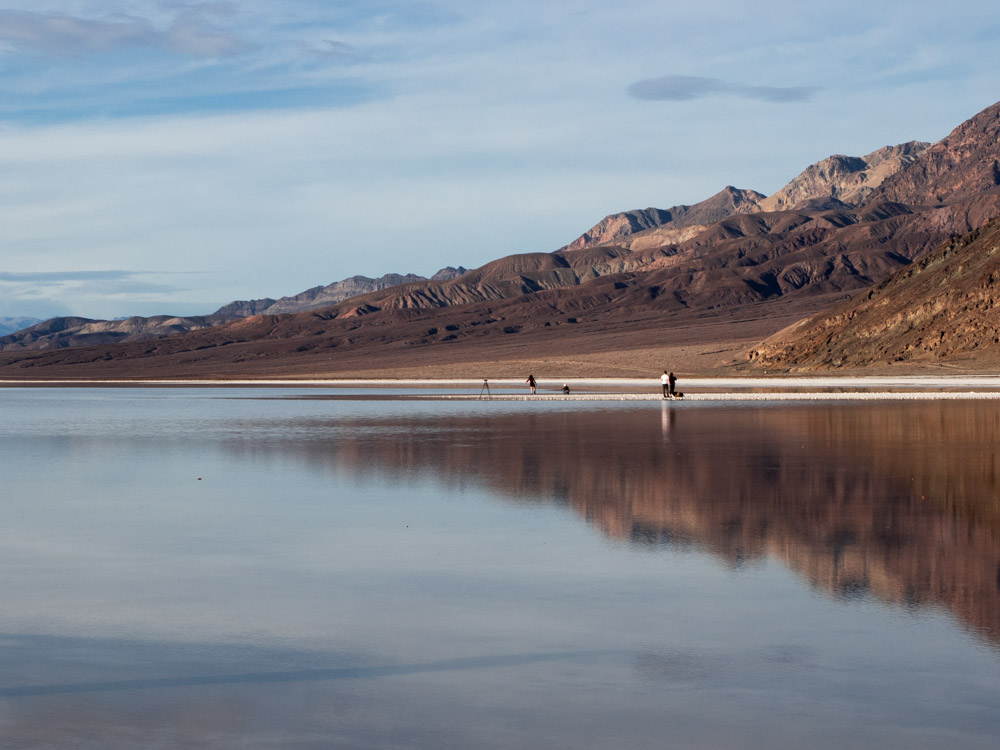
Death Valley Travel Tips: Food, Gas & Cell Service
Is there cell service in death valley.
You’ll be tempted with a bar or two, but don’t expect much. And forget about it on the more remote areas of the park or while hiking in slot canyons.
So, cache or print this guide in advance of visiting. Use offline Google maps, Alltrails maps and pick-up paper maps and visitor guides in Furnace Creek (or print them in advance).
Where to Get Gas in Death Valley
There are three places within the park boundary to get gas: Panamint Springs (on the west side), Stovepipe Wells Village (north/central) and Furnace Creek (next to the Visitor’s Center). Keep your tank topped up, because they sometimes run out of gas. In addition, Furnace Creek is the only gas station in the park that sells diesel and premium fuels.
There are also gas stations in the towns along the major gateway roads into the park.
Where to Get Groceries in Death Valley
There is no proper grocery store in Death Valley. You can get snacks, treats and light grocery items like sandwich makings at the Panamint Springs store, Stovepipe Village and the Ranch at Furnace Creek.
Where to Eat in Death Valley
The Inn at Death Valley is the fancy hotel in the park. Their main restaurant has breakfast, lunch and dinner. Their dinner offerings are quite good and reservations are recommended. They also have a poolside cafe with sandwiches, wraps and the like.
The Ranch at Furnace Creek has The Ranch restaurant which offers breakfast and dinner. They also have the Last Kind Words Saloon which has a lovely wood bar and serves drinks, steaks, salads and burgers. The Coffee & Cream is open from 1-7p and has casual food, pizza, sandwiches and ice cream. The 19th Hole has burgers and a full bar (but it closes at 6pm).
Stovepipe Wells Village has the Toll Road which offers a breakfast buffet and a dinner menu. You can also eat in their Badwater Saloon .
I’ve eaten at all of these concession venues and can say that they’re fine but overpriced for the value. You’re a captive audience in Death Valley. So if you are on a budget, bring a cooler and pack as much of your own food as you can.

Death Valley Guided Tours
The National Park sometimes runs guided ranger tours or talks for Golden Canyon, Mesquite Dunes, Badwater and Harmony Borax Works. Check their calendar to see if anything is scheduled for your Death Valley visit.
If you are staying in Las Vegas, you can book onto one of several different Death Valley guided day tours. All of them are approximately 10 hours and will pick-up from Las Vegas hotels and Airbnbs. They are all ~$250 per person for the full day, which includes a guide, national park fee, lunch, snacks and water.
The tours differ by which stops they make and whether or not you can customize your options. Check out these four choices and click on the link to get more info, read reviews and book.
- The Death Valley Day Trip from Las Vegas : This is a basic “best-of” tour. It adds a stop for the Devil’s Golf Course and doesn’t go to Dante’s View.
- Small-Group Death Valley National Park Day Trip from Las Vegas : This tour does stop at Dante’s Peak and Pahrump, but it doesn’t go to the Mesquite Dunes.
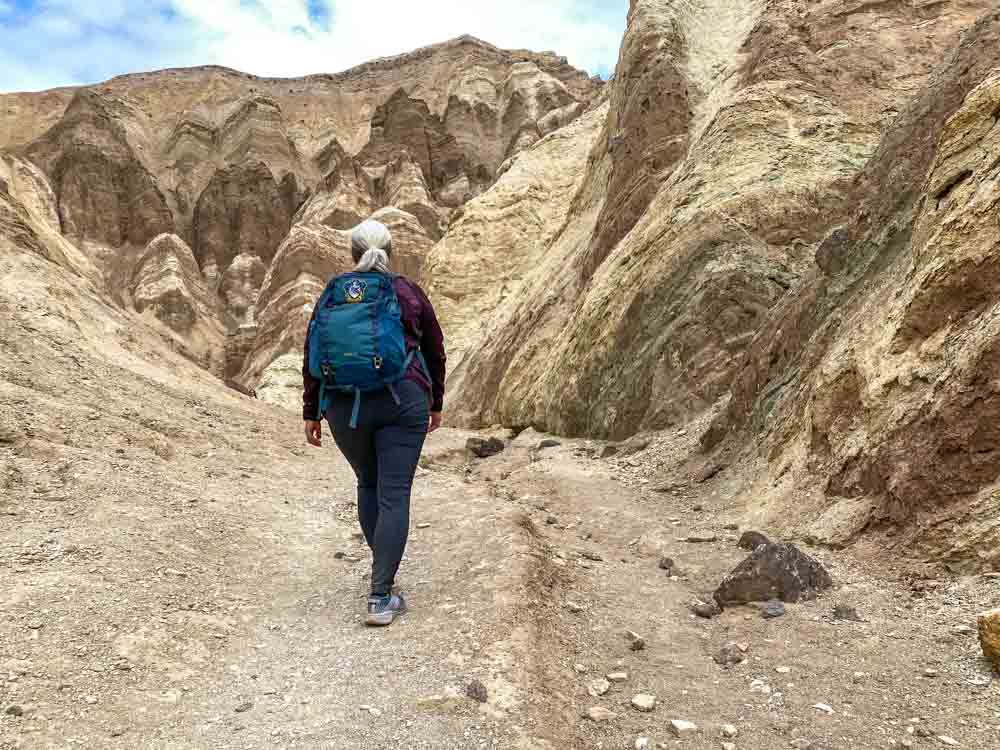
What to Pack for Death Valley National Park
Bring an old school map . If you do nothing else, please consider getting an old school road atlas. I love the California Road and Recreation Atlas , which features secondary and tertiary roads, parks and camping spots. It’s perfect for going off the beaten path.
Bring double the water . This is the Mohave Desert after all and the hikes and vista points don’t have water. Bring a water bottle for on the go and stock the car with larger refillable bottles like this wide mouth gallon jug .
Bring a cooler full of food . Services are thin on the ground. Take a good sized cooler (like this Yeti ) that will keep cold in the heat and will hold a decent amount of lunch and snack items.
Pack layers . Just because it doesn’t rain (much) in Death Valley, doesn’t mean that there isn’t weather. On my most recent trip, I went through three layers just on the Golden Canyon hike.
Proper hiking pants . Yoga pants and gym shorts don’t cut it when you are hiking because you don’t want to be dropping your phone and keys all over Death Valley. Proper hiking pants or shorts with zippered pockets are a must. I love the hiking pants from Kuhl and Columbia .
Proper hiking shoes . You don’t necessarily need heavy hiking boots for your Death Valley trip, but you should at least invest in some trail runners or light hikers. Flexible sole gym shoes aren’t good for gripping the rocky, gravely soil of Death Valley. We’ve put 1,000’s of miles on the Hoka Speedgoat trail runners . They have strong foot cushioning and decent grip.
There’s your Death Valley travel guide. We’re hoping that it’s given you all of the practical information that you need for your trip. If you have any questions, be sure to find us on Facebook. Have fun and happy trails!
Explore More California National Parks
- If you are also got an equally thorough guide for visiting Joshua Tree National Park .
- Here’s a guide for visiting Yosemite in the winter , how to road trip it from San Francisco , and what to pack (whatever the season).
- North Coast Redwoods road trip with 9 stops, including Redwoods National Park.
- Our complete list of ALL California national parks (with map). And we have a similar one for all California State Parks too.
- Exploring national park sites in San Francisco’s Presidio .
Share these Death Valley trip details with your friends on Pinterest:
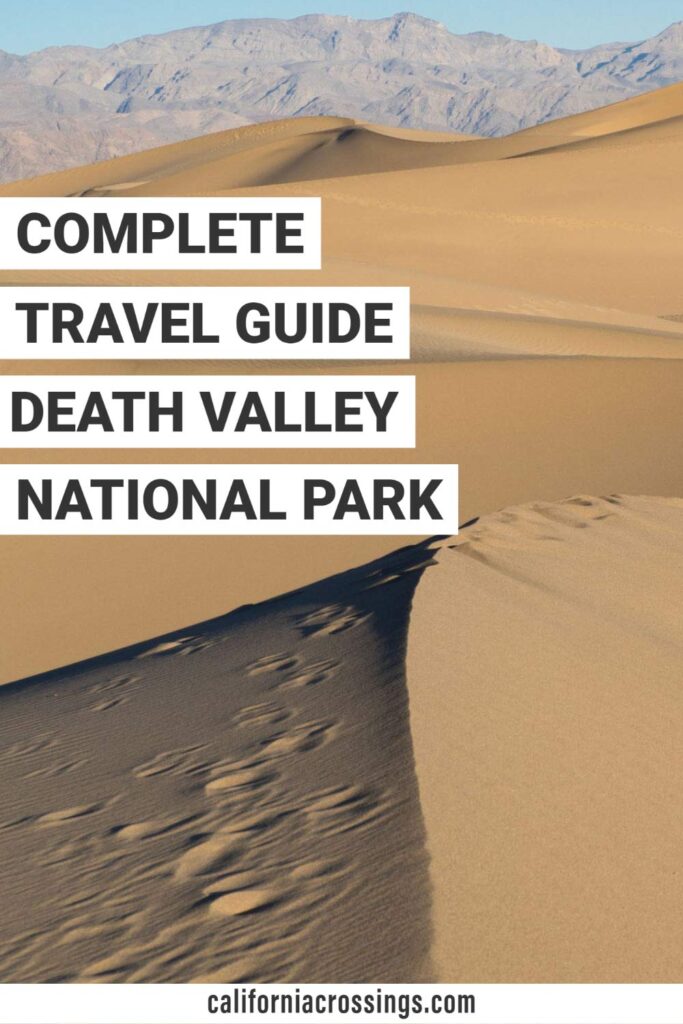
Share with your friends
1 thought on “Your Death Valley Visitor Guide: Comprehensive Travel Tips”
I never considered Death Valley a worthy destination, but you’ve changed my mind. I truly love your writing style- thanks so much for sharing all the great tips!
Leave a Comment Cancel reply
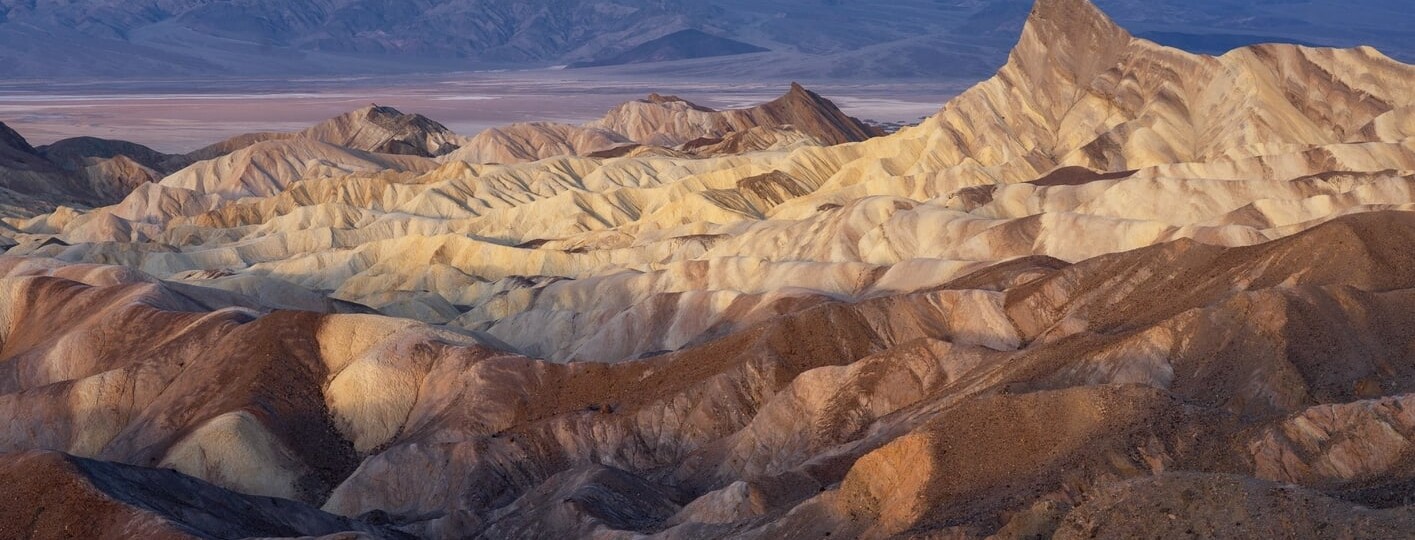
Best Things to Do in Death Valley, California, USA
Home | Travel | North America | United States | California | Death Valley | Best Things to Do in Death Valley, California, USA
Visiting Death Valley in California USA was one of the most anticipated adventures of our trip.
Located between Nevada and California, Death Valley National Park is the second largest in the United States. We spent half a day there on our 10-day West Coast road trip since we were only passing through Death Valley on our way from Las Vegas to Yosemite.
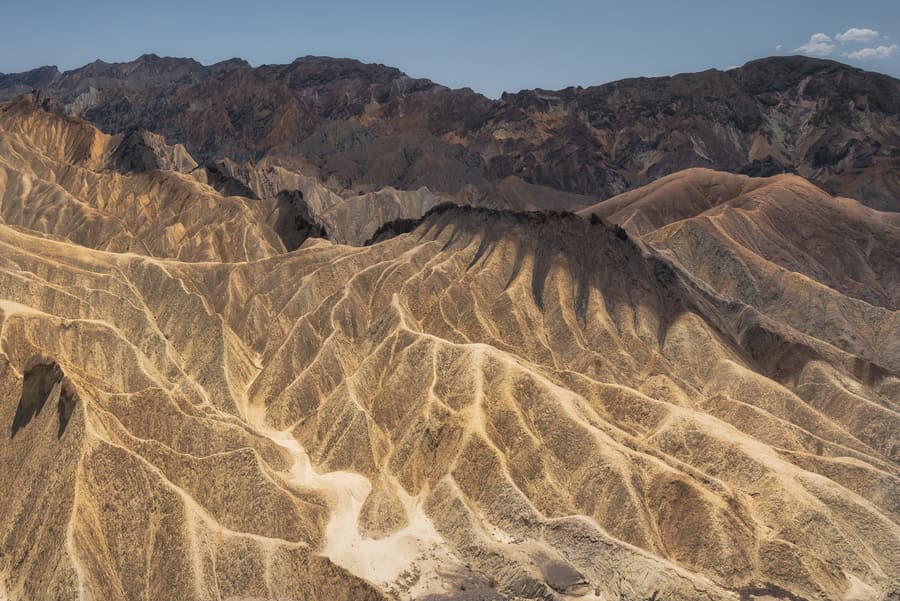
Before going deeply into some of them, here are the top 10 attractions of Death Valley:
TOP 10 THINGS TO DO IN DEATH VALLEY
- Mesquite Flat
- Badwater Basin
- Dante’s view
- Zabriskie Point
- Artist’s Palette
- Racetrack Playa
- Devils Golf Course
- Golden Canyon Trail
- Rhyolite Ghost Town
Temperatures in Death Valley are extreme throughout the year. Therefore, it is important to pay attention to our list of tips for visiting Death Valley if you don’t want to end up with a bad experience. We will provide all the information you need for a safe and enjoyable trip through Death Valley National Park .
WHAT IS DEATH VALLEY?
Death Valley National Park is one of the four national parks located in the Mojave Desert, which we covered in this article.
Death Valley is located in southeastern California, about 186 miles north of Los Angeles and about 149 miles west of Las Vegas. Actually, it is the closest National Park to Las Vegas. The valley extends over 124 miles from north to south and approximately 12 miles from east to west.

We can find some of the highest temperatures of America here in Death Valley, especially in an area known as Badwater basin located at 279 feet below sea level. It is famous for being the lowest point in the United States.
The extremely high temperatures have claimed hundreds of lives throughout history, mainly during the eighteenth, nineteenth, and twentieth centuries. The majority of deaths in Death Valley were immigrants trying to reach the coast of California for better living conditions and pay, unknowingly entering into the area.
Thirsty and dying of heat, they couldn’t leave Death Valley alive, thus the name of this driest desert of the United States.
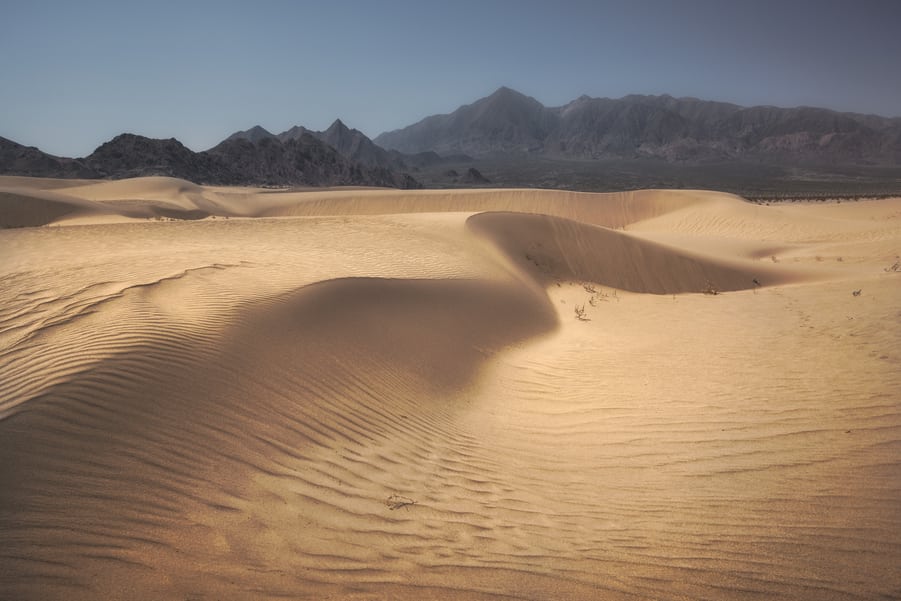
Other visitors who risked their lives coming to Death Valley in the past were the borax and gold miners, although the gold rush in Death Valley was short.
Today, it is much easier to visit Death Valley National Park. You won’t run into any risks in Death Valley as long as you stay near the main attractions and follow a good guide to Death Valley. This way, it would be easy to find help if your car breaks down or run out of gas. In short, although there are certain risks, these are minimal and visiting Death Valley is completely worth it.
HOW TO VISIT DEATH VALLEY
There are only a few tours to Death Valley from Las Vegas. However, these usually run quickly, and it is necessary to book them in advance. If you are going to stay in Las Vegas for a short time and you don’t have a car, taking a guided day trip to Death Valley might be a good option. In fact, it is one of the best things to do in LV. If you don’t want to drive, my recommendation is to book a 1-day tour to Death Valley here (this is one of the best day trips from Las Vegas ).
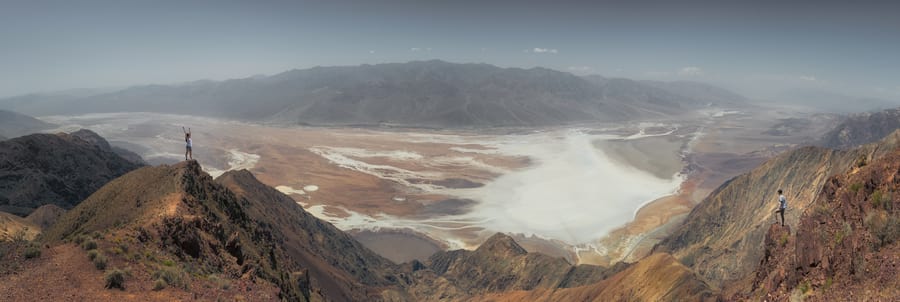
In our case, we visited Death Valley as part of our road trip. Driving across Highway 190 was at the top of our bucket list and visiting Death Valley by car resulted in an unforgettable experience. You will be surrounded by landscapes taken from another planet as you approach the Death Valley National Park entrance – and believe me, the best is yet to come!
FIND CHEAP RENTAL CARS IN THE US
Other adventurers risk crossing the Death Valley by bicycle, although this option is only for you if you are trained for extreme cycling. There are also Death Valley Bike Tours if you are interested in visiting in this alternative way.
The following topics will be discussed in our guide to Death Valley by car:
- How to get to Death Valley
- Best things to see in Death Valley
- Death Valley entrance fee
- Death Valley opening hours & seasons
- Best time to visit Death Valley: Weather in Death Valley
- How many days you need to visit Death Valley
- Facts about Death Valley
- Where to sleep in Death Valley
- Death Valley Map
HOW TO GET TO DEATH VALLEY
In this section, you will find the different directions to get to Death Valley by car. You can also check our trick to get cheap rental cars or the best RV rental companies in the USA here.
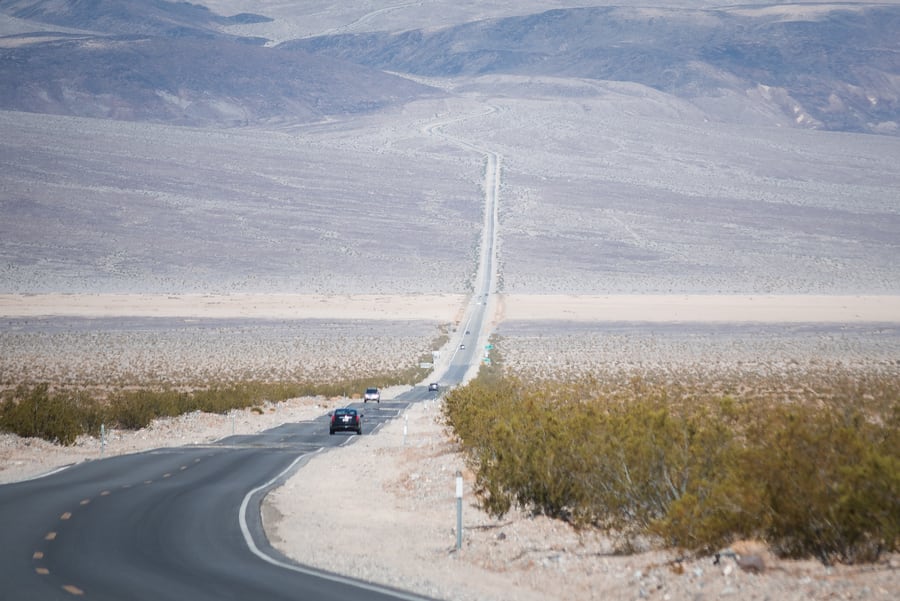
There are two entrances to Death Valley National Park if we take Highway 190 (the road that crosses the National Park from east to west). We will enter through Panamint Springs to the west and Death Valley Junction to the east.
HOW TO GET TO DEATH VALLEY FROM LAS VEGAS
It only takes two hours to get to Death Valley from Las Vegas (the distance between Death Valley and Las Vegas is 110 miles). From here, we will access the park through the east entrance.
Here you can check our guide on how to rent a car in Las Vegas. If you don’t want to drive, you can also book a tour to Death Valley from Las Vegas.
HOW TO GET TO DEATH VALLEY FROM THE GRAND CANYON
From Grand Canyon to Death Valley, we will have to cross through Las Vegas, which increase the travel time to 4 hours. Here you can check our guide to the Grand Canyon.
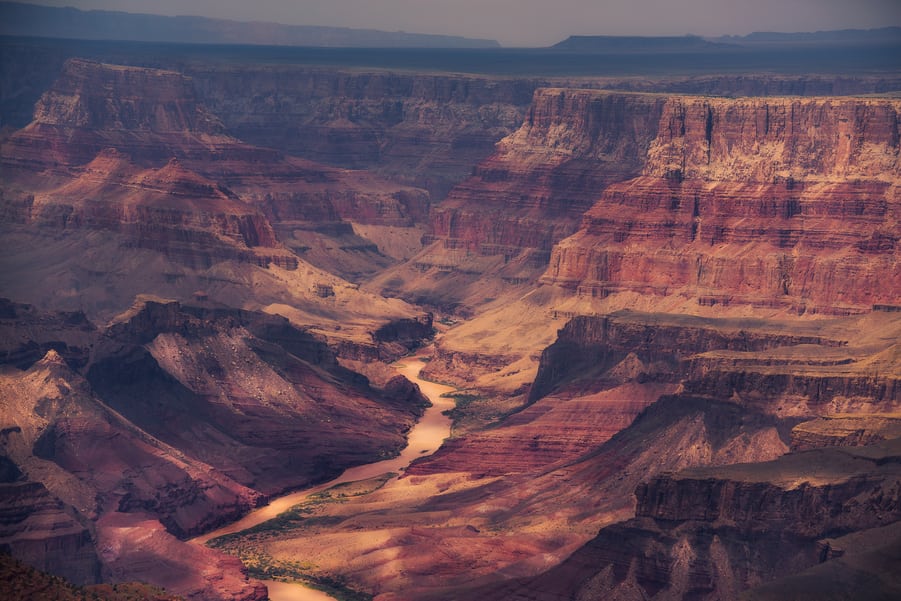
HOW TO GET TO DEATH VALLEY FROM SAN FRANCISCO
The best way to get to Death Valley from San Francisco is to take the Interstate 5 to Bakersfield, then go north toward the western entrance of Death Valley National Park.
In total, it takes 7 and a half hours to travel the distance between Death Valley and San Francisco (460 miles). As this is quite a long trip, I recommend stopping halfway and go to Death Valley from Bakersfield the next day.
If you are coming from this city, check the best things to do in SF and where to stay in San Francisco.
HOW TO GET TO DEATH VALLEY FROM YOSEMITE
Another good option for those who come from San Francisco is to go to Death Valley from Yosemite, so you can visit another incredible National Park on the same trip.

It is a 4.5 hours drive between Death Valley and Yosemite , and you will enter through the west entrance of Panamint Springs.
See our guide of all the things to do in Yosemite National Park
HOW TO GET TO DEATH VALLEY FROM LOS ANGELES
It takes 4 hours to get to Death Valley from Los Angeles through the west entrance. There is a distance of 200 miles between Death Valley and Los Angeles.
If you are coming from this city, check the best things to do in LA and where to stay in Los Angeles.
HOW TO GET FROM DEATH VALLEY TO SEQUOIA PARK
Death Valley and Sequoia National Park are only 3 hours away from each other. We will also access through the west entrance.
BEST THINGS TO SEE IN DEATH VALLEY
In this section, you will learn about the top things to see in Death Valley . Most of these attractions can be visited on the same day, and they are the essence of Death Valley. However, if we want to hike, explore further, or learn more about the flora and fauna of Death Valley, I would recommend spending at least two full days.
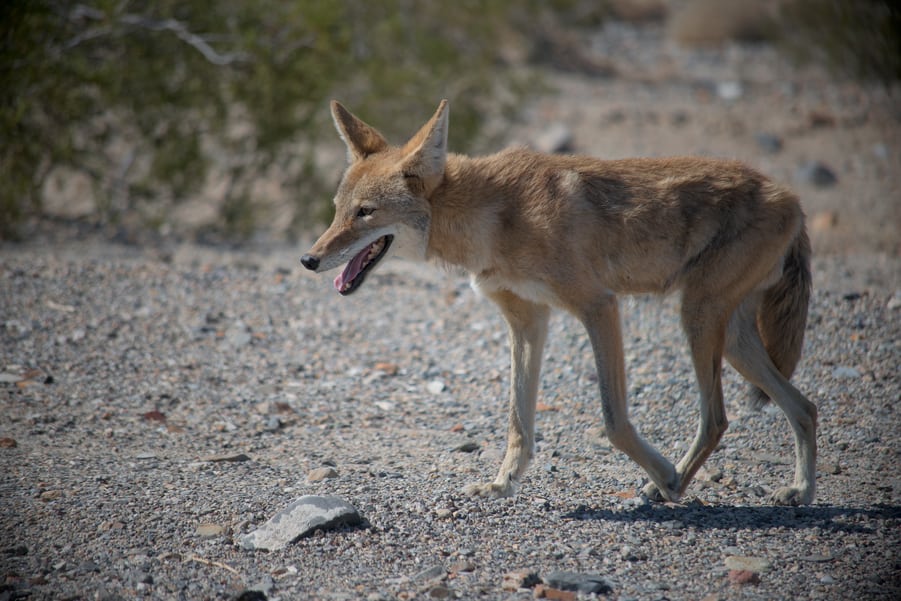
In any case, the first thing to do is make a stop the Death Valley Visitor Center to pay the entrance fee, grab a map, and get the most updated information on weather conditions.
MESQUITE FLAT
Unlike what many people assume, less than 1% of Death Valley is covered with dunes. In addition to sand and wind, you also need the right geological foundation that accumulates sand to form dunes, which does not happen here.
Mesquite Flat, the most popular dunes in Death Valley, is very accessible from the main road. This area of dunes rises to a maximum of 328 feet, covering a large area. They are also the only dunes in Death Valley where Sandboarding is allowed.
With that said, be careful if you decide to enter the dunes. Always have a point of reference as it is easy to get lost and you could die of dehydration if you cannot find your way back to the car.
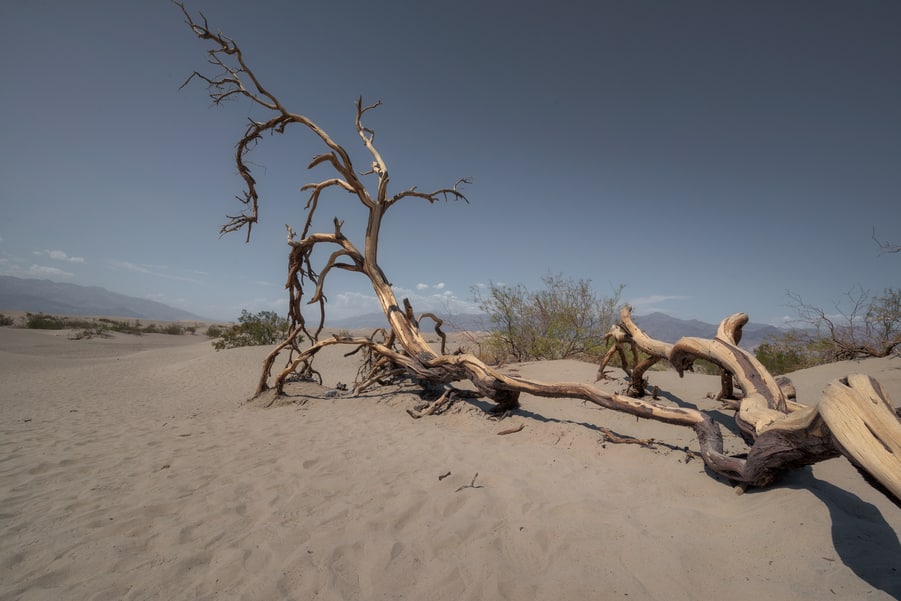
Undoubtedly, Mesquite Flat is the main attraction that you have to see in Death Valley National Park.
BADWATER BASIN
Another thing you have to do in Death Valley is to visit Badwater Basin. This 985 square feet salt flat is one of the largest in the world. It is also famous as the lowest point in the United States at 282 feet below sea level.
Getting to Badwater Basin takes about 20 minutes from the main road, and we were not able to visit as we were just spending half a day in Death Valley.
ZABRISKIE POINT
Zabriskie Point is one of the essential viewpoints to see in Death Valley . Located right by the road, it is an easy stopover to put in your one-day Death Valley travel itinerary.
Here, you will see a panoramic view of sedimentary brown and yellow mountains with beautiful tones.
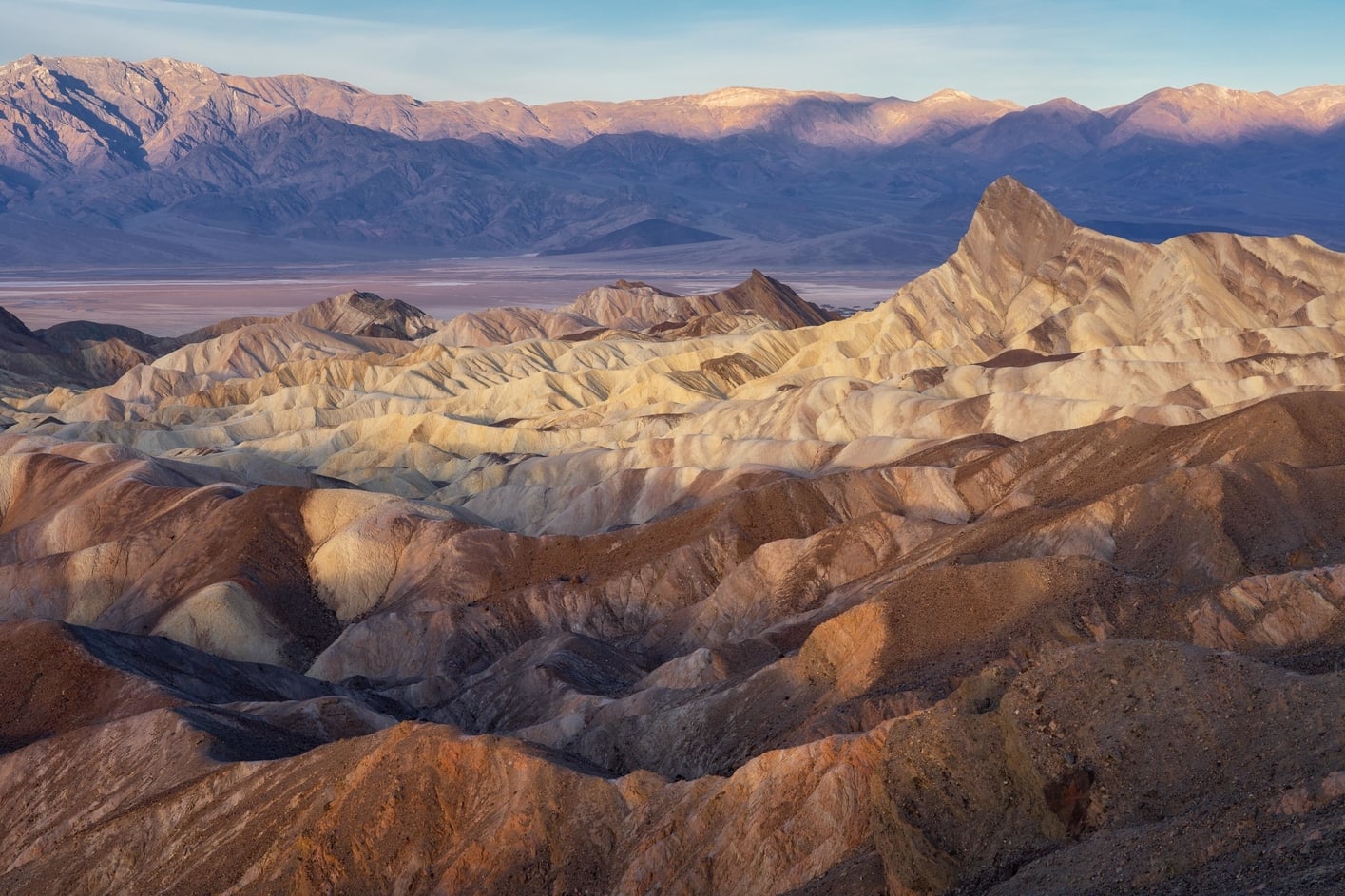
Near Zabriskie Point, we can drive to Twenty Mule Team Canyon, an incredible geological formation. The one-way road that takes you there (going from northwest to southeast) is a dirt road, but an easy one to drive.
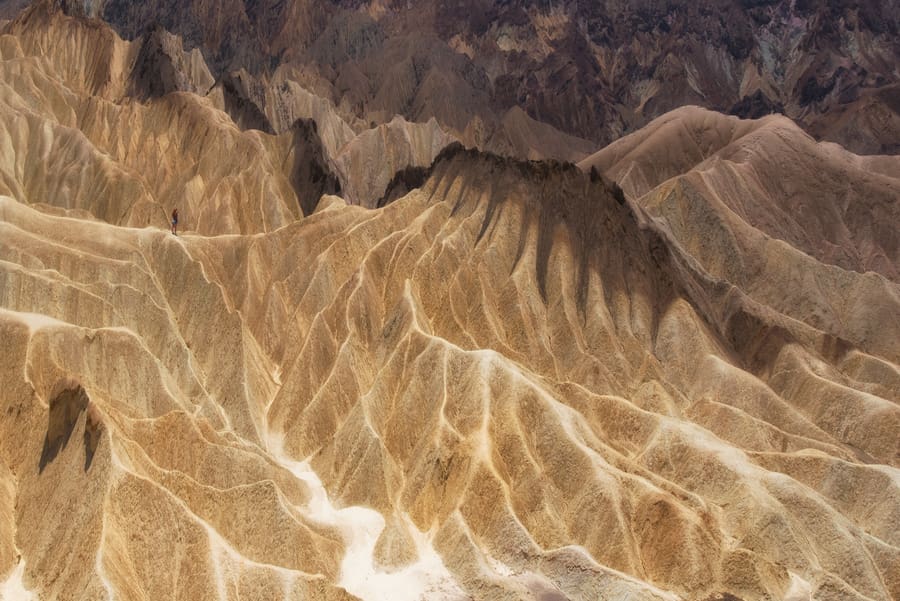
On the other hand, if you want to hike, I recommend Golden Canyon, which starts on the road that leads to Badwater and takes you into the same rugged mountains we saw from Zabriskie Point.
DANTE’S VIEW
To get to Dante’s View, we have to cross a 13-mile road with no exit. It will take more than half an hour, but trust me, it is completely worth it. From this high viewpoint, we get a bird’s eye view of Death Valley and see the pure white color of Badwater Basin, which we could not see from up close.
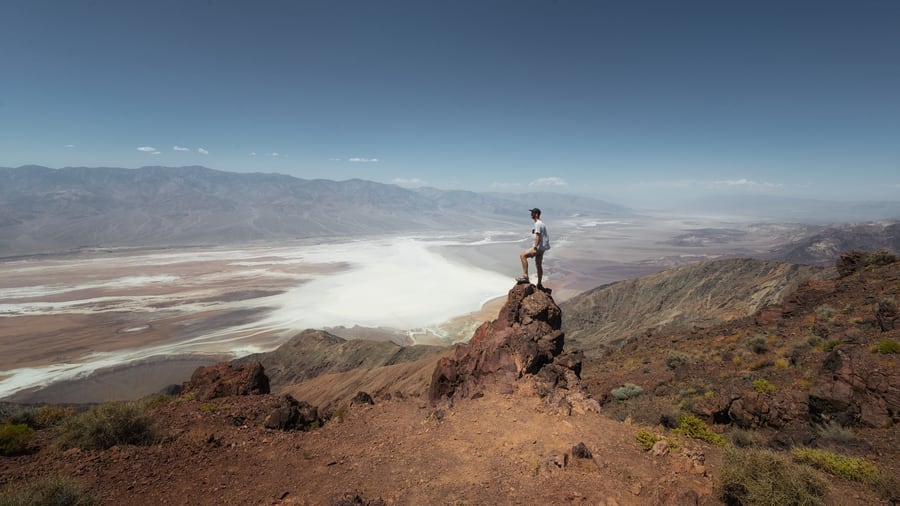
For me, enjoying what can be seen from Dante’s View is one of the essential things to do in Death Valley.
ARTIST’S PALETTE
If you visit Badwater Basin, you should know that there are other exciting things to see on this road.
One of the most important landmarks is Artist’s Palette, an area where the oxidized minerals of the mountain glow in reddish, pink, yellow, green, and gray tones. To get here, we will have to take a 20-minute semicircular route. Artist road is a one-way drive which moves from southeast to northwest, and the views along the whole journey are fascinating.
DEVIL’S GOLF COURSE
The entrance to the sandy road that leads to Devil’s Golf Course is on Badwater Road between the entry and exit of the Artist circular road. If you come from the south to visit the Artist’s Palette, you could unwittingly overlook this location.
The salt pan of Devils Golf Course stands out for its shape, where salt crystals form large holes in the ground (thus its name), an incredible phenomenon that you have to see in Death Valley.
This short interpretive walk on the edge of Salt Creek is another exciting to do for your Death Valley day trip, since it is a short distance from Mesquite Flat.
In spite of high salt content in the stream where you can even see visible salt crystals around the shore, here lives one of the most curious species of Death Valley, the Salt Creek Pupfish.
FURNACE CREEK
Furnace Creek was an Indian village, and today it is one of the few places within Death Valley National Park where you can find lodging, restaurants, and the Furnace Creek Visitor Center.
There is also a gas station, although very expensive – it is better to enter the park with a full tank.
Nearby is The Old Harmony Borax Works , the remains of Death Valley’s main borax mine that was in operation from 1882 to 1889.
RACETRACK PLAYA
One of the most famous mysteries in Death Valley is the sailing stones. These sliding rocks in Death Valley are located in the so-called Racetrack Playa, two and a half hours from Highway 190. In a 1-day route through Death Valley, we would not have enough time to discover the mystery of these rocks. In any case, you can see this video where the secret is unveiled. Fun fact: the mystery of the moving rocks in Death Valley wasn’t solved until 2013.
OTHER DUNES IN DEATH VALLEY
The Mesquite Flat dunes are impressive dunes, but they are so accessible that it will be difficult to find a spot where there aren’t foot tracks in the sand. If you want to take good pictures of the dunes, I suggest visiting any of the following instead and consider spending more than one day in Death Valley.
EUREKA DUNES
Eureka Dunes are the highest dunes in California, at 656 feet tall. It is difficult to reach the top as the sand sink under your feet and hills are very steep, but if you manage to do it, you will be rewarded with incredible views and the so-called “singing sand” phenomenon, a sound created when sand falls off a steep slope.
Also, since these dunes are wholly isolated from the rest, endemic species of wildlife and plants not found in any other dunes in the world live there.
PANAMINT DUNES
The Panamint Dunes are visible in the distance from Highway 190. If you want to get close, you will have to drive 5 miles and then walk another 3 miles. They are not very accessible, and I would not recommend a visit unless you are going to take a 3-day itinerary in Death Valley.
You have to walk half a mile from the road that leads to Saratoga to access the Ibex Dunes. In the east of the dunes, we can see an old talc mine at the base of Saddle Peak Hills. The Mojave tipped lizard lives in these dunes.
DUMONT LITTLE DUNES
Although not within the area designated as Death Valley National Park, the Dumont Little Dunes had to be mentioned in this Guide to Death Valley. They are right at the south entrance, while accessible, they are not very popular. If you have time and want to take beautiful pictures of dunes without foot tracks and people in the frame, this is your best option.
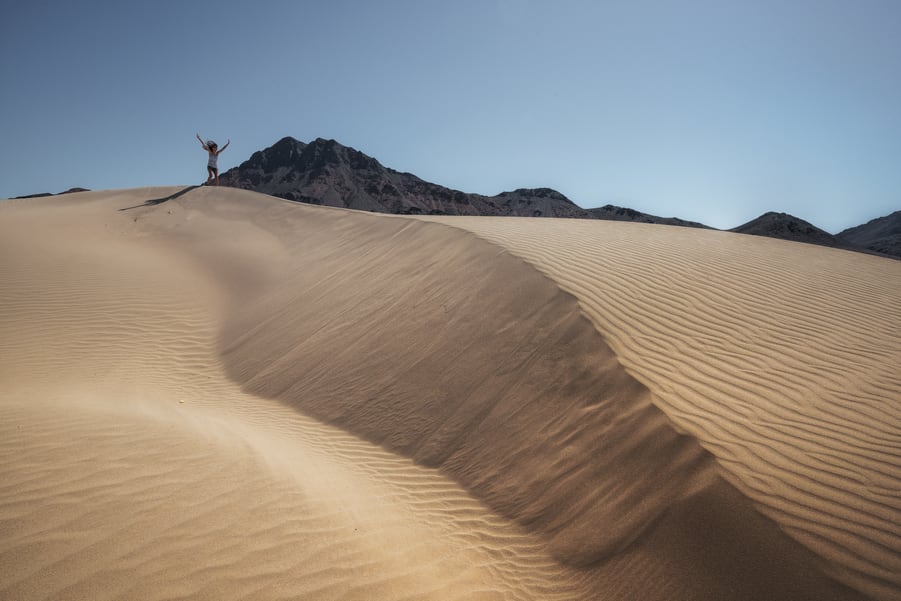
OTHER THINGS TO DO IN DEATH VALLEY
These are other activities to do in Death Valley if you have more time:
TITUS CANYON
Titus Canyon is a one-way car route through a narrow canyon. It starts near Rhyolite Ghost Town , one of the most famous ghost towns with banks, school, jail, and even a train depot, just outside the National Park.
The sandy road that leads to Titus Canyon has a total length of 24 miles and will take approximately 3 hours to cover it. On your way, you will see steep mountains, colorful rock formations, another ghost town called Leadfield, petroglyphs, wildlife, rare plants, and a spectacular canyon that narrows especially in the last section, once inside Death Valley National Park.
The last area, which is also the most striking, can also be visited on foot from the opposite direction for those who do not want to take the complete tour.
UBEHEBE CRATER
If you visit the Eureka Dunes, it may interest you to go to the Ubehebe crater , at 656 feet deep and 2624 feet in diameter.
Parking is on the edge of the crater, and from there, you can see the most interesting sights. However, if we want to explore further and discover other smaller craters such as the Little Hebe , we will have to walk around the rim of the crater.
We can also descend to the interior of the crater. This route may seem simple, but it is complicated when returning uphill to the parking.
Also, another nearby attraction is the Scotty’s Castle, a mansion of a wealthy family during the gold rush that was later used as a visitor center. Nowadays, it remains closed due to a flood that took place in 2015, and its reopening is expected in 2020.
AGUEREBERRY POINT
Aguereberry Point is another lookout that offers something different from Dante’s View. However, those who have seen both of them prefer Dante’s since the views are more panoramic and spectacular.
In addition, going to Aguereberry Point requires a 4×4 vehicle and special driving skills, as it is not an easy road.
In this area, we can also visit the Charcoal Kilns, 10 charcoal kilns located in Wildrose Canyon with a beehive formation, one of the most picturesque in Death Valley.
TIPS FOR VISITING DEATH VALLEY
In this section, you will find all the information you need and best tips to visit Death Valley.
DEATH VALLEY NATIONAL PARK ENTRANCE FEE
The entrance fee to Death Valley is $25 for seven days per vehicle. However, if you are also visiting different national parks, I recommend buying an America the Beautiful annual pass which include access to an extensive list of federal sites.
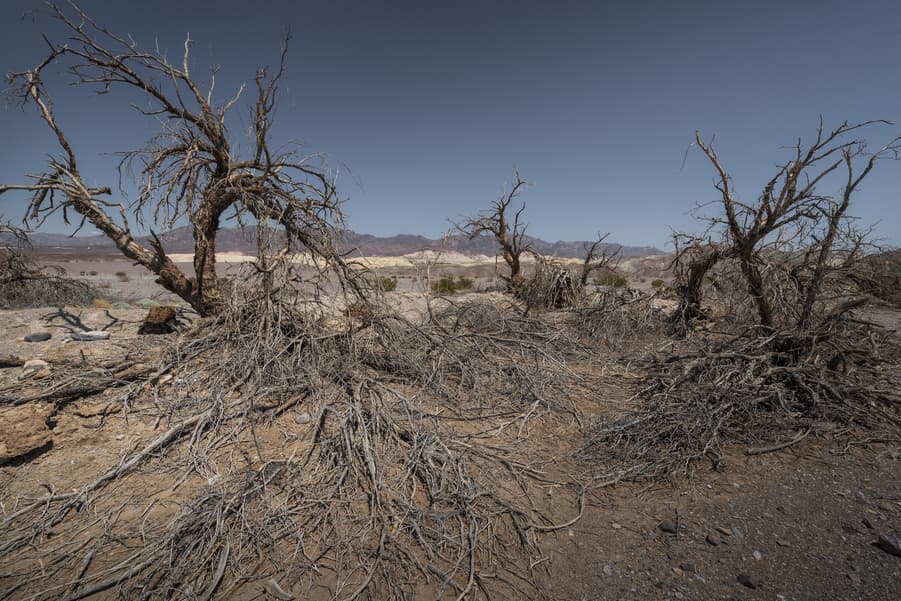
Keep in mind that there are no ranger stalls at the entrance of the park to collect your fees. They rely on the goodwill of visitors to pay at the Furnace Creek Visitor Center . You could be fined if you do not pay the fee.
DEATH VALLEY OPENING TIMES
Death Valley is open 24 hours a day, 365 days a year.
The Death Valley Visitor Center opens from 8 am to 5 pm every day, where you can catch a 20-minute video about the park. During the winter from November to April, we can find other activities such as ranger talks and guided walks. For more information about the planned activities, visit the Death Valley Visitor Center.
BEST TIME TO VISIT DEATH VALLEY: Weather in Death Valley
The weather in Death Valley, California is extremely dry and hot throughout the year, especially in the summer where temperatures easily pass 122 ºF. During the winter, humidity levels range from 32% (day time) to 55% (night time), and 10% to 25% during the summer, respectively.
Therefore, the best time to visit Death Valley is during the coldest months. If you can, try to stay away from visiting Death Valley in summer: end of May, June, July, August, and early September.

However, if you can only visit during these months, do not worry, we visited Death Valley in August, and it was still worth it.
If you can’t bare such extreme climates, it is best to visit Death Valley during winter. For example, temperatures in Death Valley in December usually range between 64 and 70ºF. If you are interested in hiking, winter is also the best time to do so in Death Valley.
If you want to see this desert’s maximum splendors, then you cannot miss the Death Valley bloom during spring. This phenomenon takes place based on the rainfall during the autumn and winter season. If it has been a very humid winter compared to previous years, a super bloom may occur between March and April, since the seeds remain intact for years until the ideal conditions are met.
It is also the best time for photography in Death Valley as you can have the opportunity to capture a desert full of colors.
HOW MANY DAYS Do YOU NEED TO VISIT DEATH VALLEY
Most people take a 1-day route in Death Valley , stopping only at the popular points by Highway 190 (Zabriskie Point, Mesquite flat, Dante’s View…), thus missing everything a bit further from the road.
If you do not have much time, a good 1-day Death Valley itinerary may be the best option. If possible, include the iconic Badwater Basin in addition to the main points that we have discussed.
If you like night photography, then you can’t miss spending a night in Death Valley to enjoy one of the darkest skies in the world.
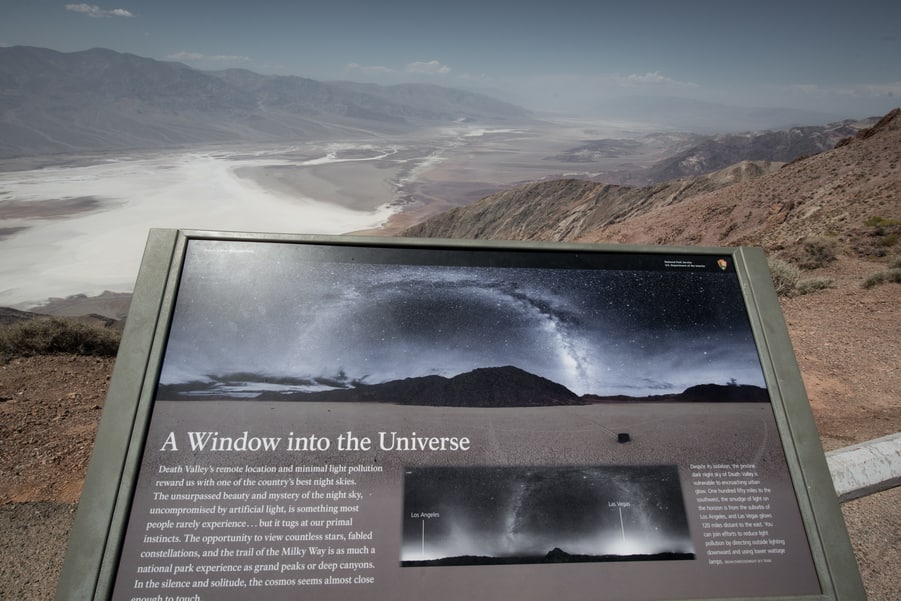
This will turn into a 2-day Death Valley itinerary, where you can discover some more remote dunes or enjoy a hiking trail in one of the driest places on earth.
CURIOSITIES ABOUT DEATH VALLEY
In this section, we will speak about some curiosities of Death Valley.
MAXIMUM TEMPERATURE IN DEATH VALLEY
The highest temperature recorded in Death Valley was 134.1 ° F, in Furnace Creek in 1913. It was the highest temperature recorded on earth, to be precise.
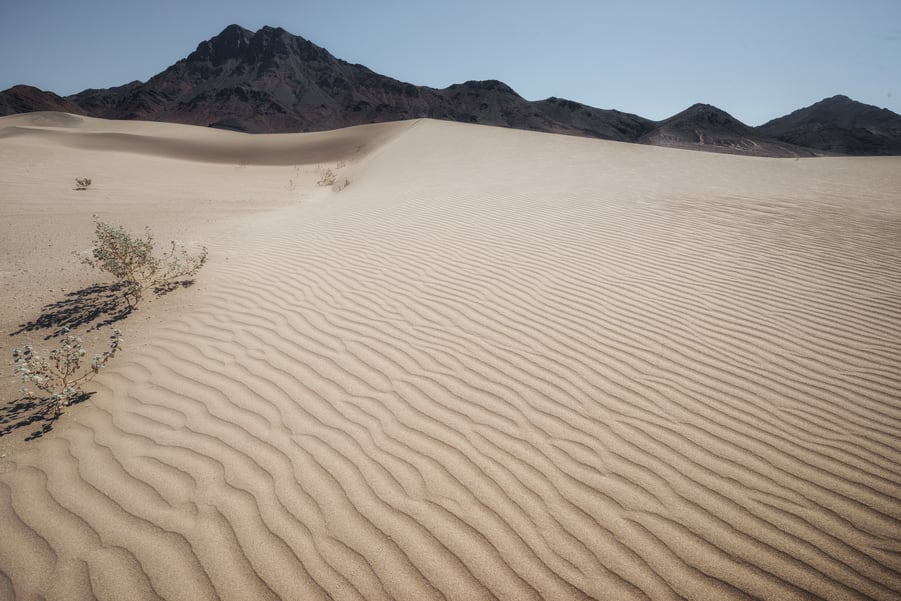
The lowest point of Death Valley is located 282 feet below sea level, and here is where the maximum temperatures were recorded.
Keep in mind that Death Valley is not drier than the Sahara Desert. In fact, the Atacama Desert, in northern Chile, is the driest desert in the world, even more than Death Valley and the Sahara.
DEATHS IN DEATH VALLEY
Currently, deaths in Death Valley are not common and if you pay attention to the safety advice and have bought the best travel insurance , you will not have any problem.
Even so, considering what medical care in the USA cost, I recommend that the coverage of the travel insurance for the USA be more than $300,000. In case you are going to spend a long time in the United States, check the long stay travel insurance option.
5% OFF your travel insurance
All roads are marked and used every day by hundreds of people, so dying in Death Valley today is very rare.
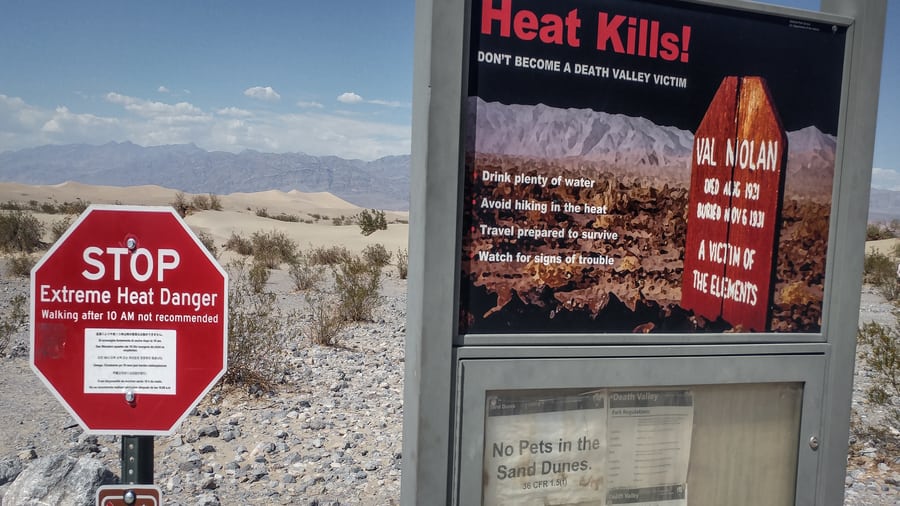
Throughout history, many people had died in Death Valley, especially when this desert was unexplored territory and the mining industry forced men to work in deplorable conditions.
In addition to these cases, there are other stranger deaths in Death Valley which increase the mystery that hides this desert. There have been a number of bodies of missing people found miles from their homes, some with their organ removals. If you are curious, I recommend reading this article for a deeper read.
Where to Stay in Death Valley
There are some lodging inside Death Valley National Park – hotels, resorts, and campsites. Another option is to find a hotel near Death Valley. We talk about all the option you have to stay within Death Valley National Park on this article. However, we will sum up the best options in this article.

ACCOMMODATION IN DEATH VALLEY NATIONAL PARK
Within the area designated as Death Valley National Park, there are four hotels and nine campsites.
HOTELS IN DEATH VALLEY
These are the only accommodation options we can find in Death Valley:
- The Inn at Death Valley: If you’re looking for a luxury hotel to stay in Death Valley, this is the best option. It’s in the best area within Death Valley.
- The Ranch at Death Valley: This newly remodeled hotel, located in the same area as the previous one, is also a good place to stay in Death Valley.
- Panamint Springs Resort: This resort offers both tourist resorts and lodging in tents.
CAMPING IN DEATH VALLEY
There are 9 campsites in Death Valley , marked in red on the map at the end of this article . The main campground in Death Valley is Furnace Creek Campground , which opens throughout the year and is the only one that can be booked in advance.
The rest of the campsites have different dates of operation, and the majority close during the summer. The price also varies from one campsite to another, including some free campgrounds in Death Valley. For more information on camping in the Death Valley, you can visit this website.
ACCOMMODATION NEAR DEATH VALLEY NATIONAL PARK
If you are struggling to find accommodation inside Death Valley National Park, try to search around the areas close to one of the entrances. These are Beatty , Pahrump , Lone Pine , Death Valley Junction and Shoshone .
DEATH VALLEY MAP
To finish this post, we prepared a Death Valley Map below, where we marked the main points of interest to see in Death Valley National Park.
- Download the Mapswithme app on your cell phone.
- Download and save the following KML file in your Dropbox.

- Open the file through Dropbox from your cell phone. You will get a dialog box where you have to select open with the Mapswithme application (Maps.me)
Ready? You have everything you need to start your trip!
SEE YOU IN THE NEXT ARTICLE AND DO NOT HESITATE TO LEAVE US A COMMENT IF YOU NEED MORE INFORMATION ABOUT DEATH VALLEY NATIONAL PARK
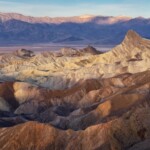
Ascen Aynat
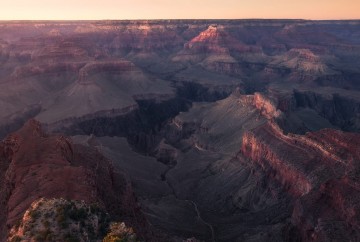
Leave a Reply Cancel reply
Your email address will not be published. Required fields are marked *
This site is protected by reCAPTCHA and the Google Privacy Policy and Terms of Service apply.

Advertiser Disclosure
Many of the credit card offers that appear on this site are from credit card companies from which we receive financial compensation. This compensation may impact how and where products appear on this site (including, for example, the order in which they appear). However, the credit card information that we publish has been written and evaluated by experts who know these products inside out. We only recommend products we either use ourselves or endorse. This site does not include all credit card companies or all available credit card offers that are on the market. See our advertising policy here where we list advertisers that we work with, and how we make money. You can also review our credit card rating methodology .
The Ultimate Guide to Death Valley National Park — Best Things To Do, See & Enjoy!
Amar Hussain
Senior Content Contributor
786 Published Articles
Countries Visited: 63 U.S. States Visited: 9
Editor & Content Contributor
153 Published Articles 761 Edited Articles
Countries Visited: 35 U.S. States Visited: 25
Keri Stooksbury
Editor-in-Chief
35 Published Articles 3198 Edited Articles
Countries Visited: 47 U.S. States Visited: 28
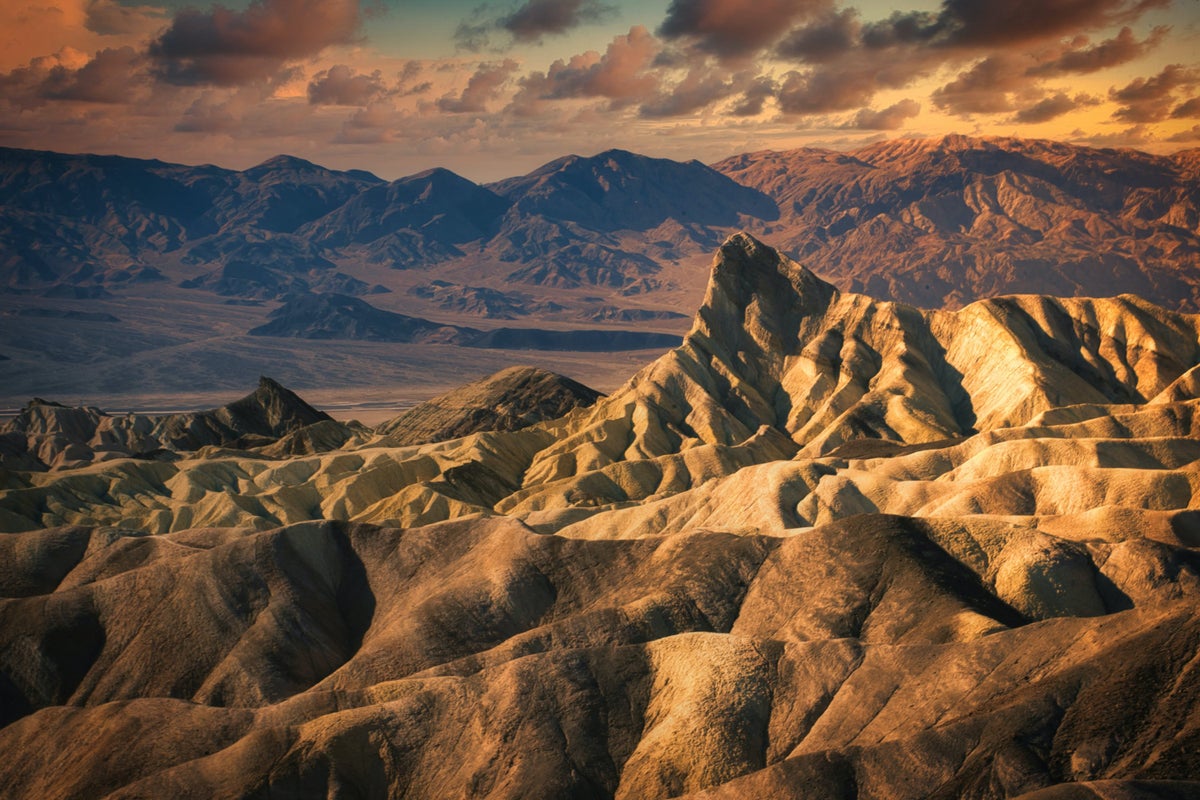
Table of Contents
How to get to death valley national park, getting around death valley national park, what to see and do in death valley national park, best times to visit death valley, where to stay in death valley national park, towns near death valley national park, where to eat in death valley national park, death valley national park facts, final thoughts.
We may be compensated when you click on product links, such as credit cards, from one or more of our advertising partners. Terms apply to the offers below. See our Advertising Policy for more about our partners, how we make money, and our rating methodology. Opinions and recommendations are ours alone.
Death Valley National Park stretches across both California and Nevada. This national park is the hottest, driest, and lowest national park in the United States.
It’s also the largest national park in the lower 48 states and contains nearly 1,000 miles of roads that wind through the park and take visitors to the amazing sites and attractions. Each year over 1 million visitors come to explore this massive, mesmerizing park.
Let’s dive into the best things to see and do in this special place.
Where Is Death Valley National Park?
Death Valley National Park spans 2 states: California and Nevada. This park is located about 4.5 hours from Los Angeles and approximately 2.5 hours from Las Vegas . The park stretches over 3,422,024 acres and features plunging canyons, rugged mountains, and rolling sand dunes.
Nearest Airports to Death Valley National Park
There are 10 airports within 200 miles of Death Valley National Park. However, several are small and only available to privately chartered planes.
Harry Reid International Airport (LAS) , Los Angeles International Airport (LAX) , and San Diego International Airport (SAN) are the 3 closest major airports to Death Valley National Park. Let’s look at these 3 major airports and see what they offer to help you decide which one to utilize.
Harry Reid International Airport (LAS)
Harry Reid International Airport is 111 miles away from Death Valley National Park. This airport is located in Las Vegas.
LAS sees flights from dozens of national and international airlines, including Aeromexico, Allegiant, American, British Airways, Delta, JetBlue, Southwest, United, and more. The extensive mix of airlines provides nonstop flights to many major domestic and international destinations.
Los Angeles International Airport (LAX)
Los Angeles International Airport boasts a seemingly endless list of international and national airlines, including Alaska, American, British Airways, China Airlines, Delta, Southwest, Spirit, United, Volaris, and more. Together, these airlines provide hundreds of flights every day to destinations around the world.
LAX is located 192 miles away from Death Valley National Park . It takes approximately 4.5 hours to drive from the airport to the park.
The airport also offers numerous amenities for travelers, such as dining and shopping opportunities, as well as several shuttles and buses to help travelers get to and from the airport.
San Diego International Airport (SAN)
San Diego International Airport is located 341 miles from Death Valley National Park. It takes a little over 6 hours to complete this journey by car .
SAN has nonstop flights to dozens of destinations around the globe on a long list of domestic and international carriers, including Air Canada, Alaska, British Airways, Frontier, Southwest, Spirit, Sun Country, and more. This airport is a great option as long as you don’t mind spending the extra time in the car to reach Death Valley.
Driving to Death Valley National Park
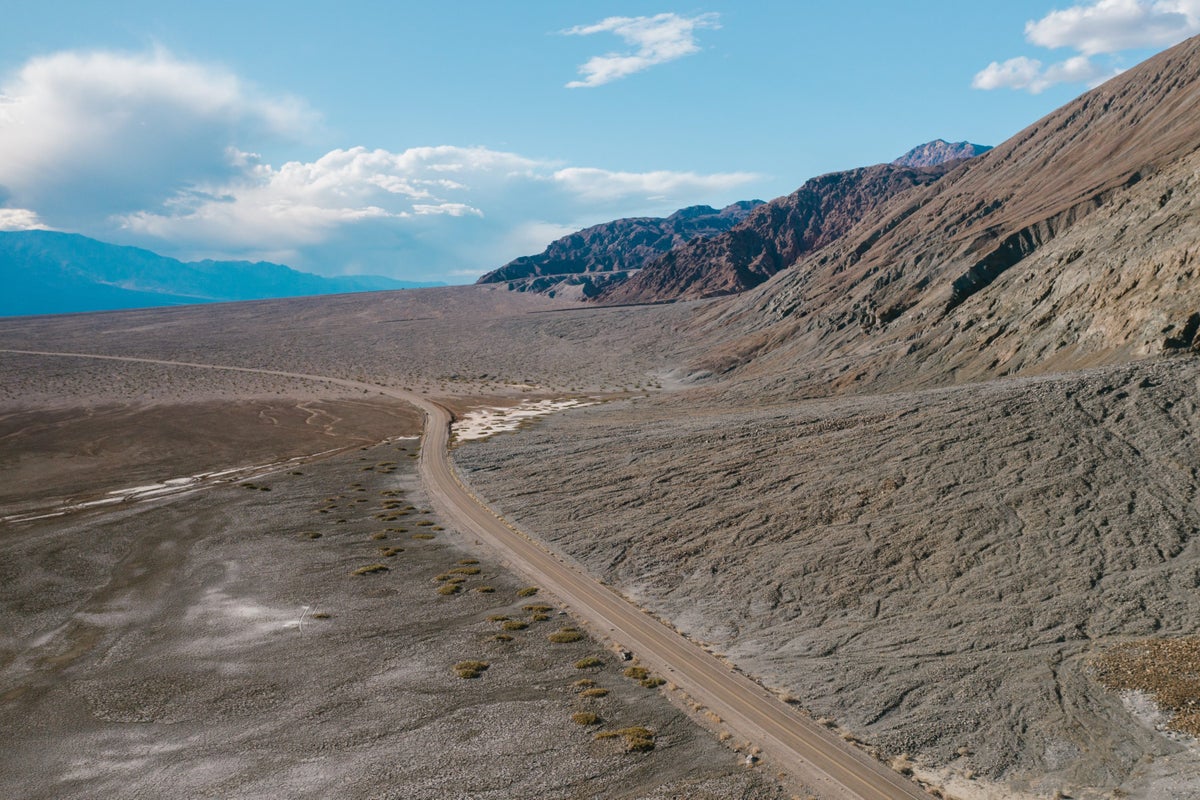
Most travelers who visit Death Valley National Park come from Los Angeles or Las Vegas. There are several ways to get to the park from both of these cities, each providing a one-of-a-kind experience. Let’s look at some of the options.
From Los Angeles
Those traveling from Los Angeles have 2 options for arriving at Death Valley National Park, both of which will take around 4.5 hours . The first option is to take CA-14 north to Cantil, Redrock Ransburg Road to US-395 to CA-178, and then CA-192 to Death Valley.
The other option for those coming from Los Angeles is to take US-10 toward San Bernardino and then follow US-15 until you arrive at Baker. From Baker, you’ll use CA-127 which leads to Death Valley Junction. Finally, take CA-190 to the park’s entrance.
From Las Vegas
There are 4 different routes to Death Valley from Las Vegas that travelers can take. The park calls them the Fastest Route, the Easiest Route, the Ghost Town Route, and the Most Scenic Route.
The so-called Fastest Route follows Interstate 15 South to NV Highway 160 West toward Pahrump, Nevada. From there, follow Bell Vista Road until you reach Death Valley Junction, California. Then, take CA-127 to CA-190 and drive 30 miles to Furnace Creek Center. This route should take about 2 hours.
Taking the Train to Death Valley National Park
Amtrak provides train services to Barstow , California, for those who want to experience traveling by rail. Barstow is 142 miles from Death Valley National Park, and you’ll need to rent a car there and then drive about 2.5 hours to the park.
Bottom Line: Driving from Barstow is about the same as driving from the nearest major airport, making this an excellent option for those who prefer ground travel or who want a break from driving long distances.
The only way to get around in Death Valley National Park is by personal vehicle. There are no forms of public transportation to or in the park .
There are several ways to enter the park. Two entrances are paved, and the rest are on dirt roads. The main road running east to west through the park is CA-190. The main roads running north to south are North Highway and Badwater Road.
The National Park Service website has a wide variety of printable and interactive maps for travelers planning their park adventures.
Death Valley National Park has plenty to experience, see, and do. There’s no shortage of sights and attractions, from hiking trails to fascinating natural wonders. Let’s take a look at the top attractions in this phenomenal park.
Artists Drive
The most scenic drive in Death Valley National Park is Artists Drive . This drive is a 9-mile stretch of paved road that winds through the hills of Death Valley. Driving on this popular road is the perfect way to see many stunning sights in the park without walking too much.
The hills are colorful and are formed by volcanic deposits that have built up over the years. This scenic drive is stunning anytime during the day, but if you’re looking for a memorable experience, driving this route during the afternoon light will provide you with the most dramatic bursts of colors .
This is an excellent area for driving, but it’s also a popular route for people on bicycles. It’s essential to be aware of those sharing the road with you and be on the lookout for bicycles and pedestrians throughout your drive.
Badwater Basin
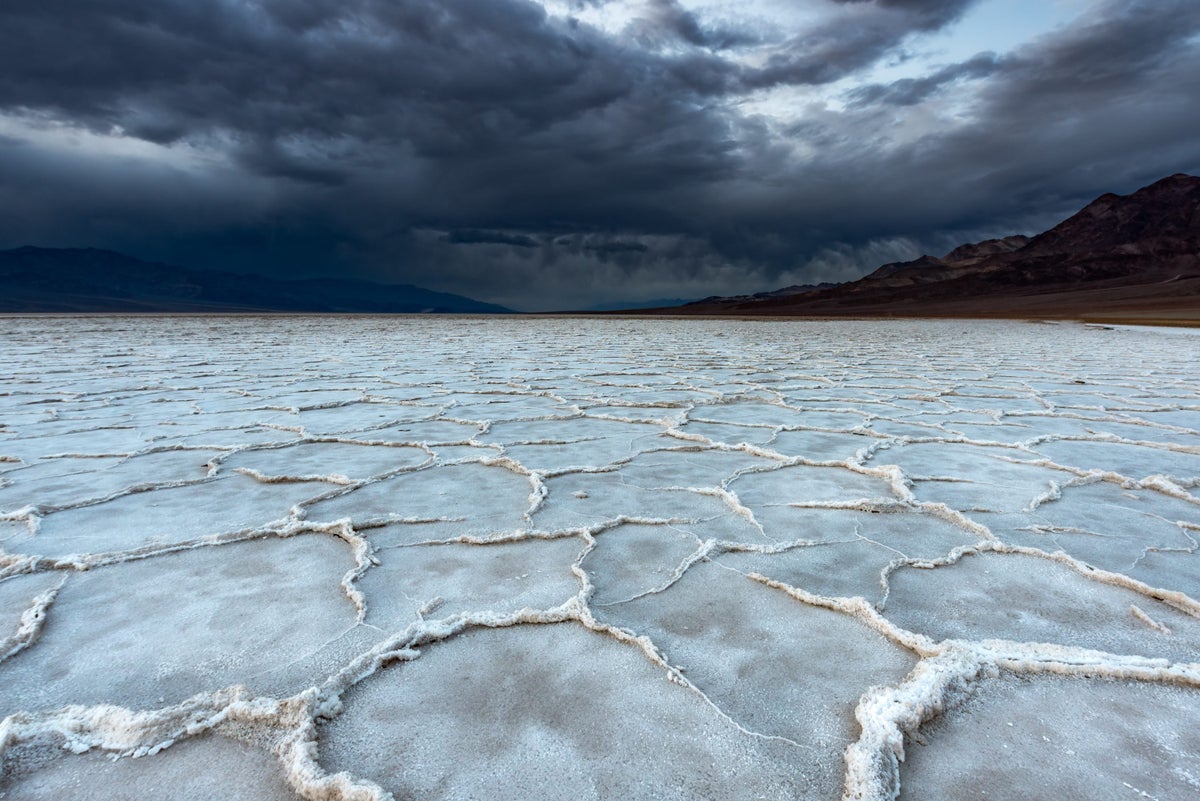
Badwater Basin is a pool of shallow, salty water over 280 feet below sea level. This is the lowest point in North America . The large salt flats cover nearly 200 square miles of land.
Stories from the past suggest that Badwater Basin received its name when a surveyor’s mule refused to drink the water from the spring-fed pool near the boardwalk you see today.
While not exactly hospitable to many creatures, there are plants and animals that thrive in this environment, including the pickleweed plant and a specific type of snail unique to the area.
This popular attraction at Death Valley National Park is an excellent location for taking photographs. This park area features a boardwalk, making it accessible to wheelchairs and strollers.
If you’re looking for the best view, venturing for a quick and easy walk out to the salt flats is where you will get the best views of the breathtaking area . When you’re in the midst of the salt flats, you’re surrounded by the towering Black Mountains and the Panamint Range.

Dante’s View
Dante’s View is one of the most popular sites at Death Valley National Park. This overlook is located off CA-190 and provides sweeping 360-degree views of the southern Death Valley basin.
Dante’s View stands at 1,669 feet tall and is in the Furnace Creek area of the park. Incredible sights that can be seen from this overlook include the Owlshead Mountains, the Funeral Mountains, the Panamint Range, and the Green Water Range.
Darwin Falls
Death Valley National Park is home to Darwin Falls , which stands 18 feet tall and is surrounded by thriving plant life. Many visitors are surprised to learn that a stunning waterfall can be found in the middle of the desert park .
Darwin Falls is a popular hiking area with a nearly 2-mile trail that takes around 45 minutes to hike from start to finish. Standing in awe of this roaring waterfall will create memories that will last a lifetime.
Furnace Creek Visitor Center
Furnace Creek Visitor Center is an excellent place to learn about Death Valley National Park, ask park rangers questions, and purchase permits and national park passes.
There are also numerous exhibits and a 20-minute film that teaches about the natural and cultural history of the park. There is an on-site bookstore where you can shop for souvenirs.
Mesquite Flat Sand Dunes
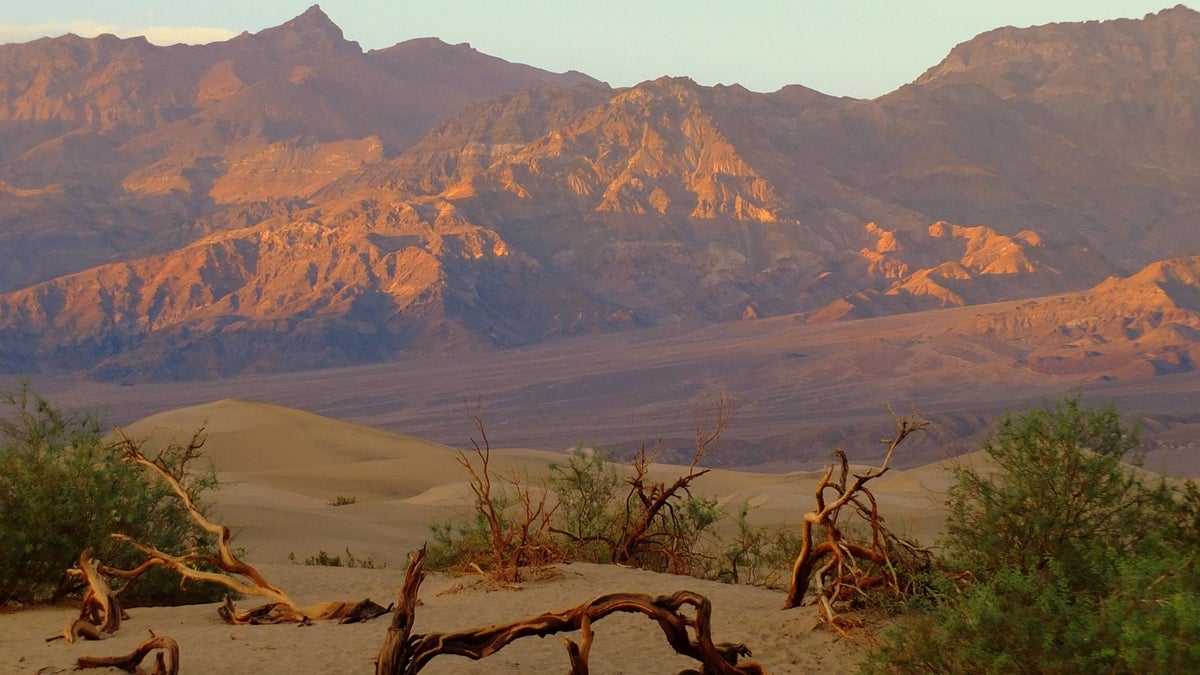
Mesquite Flat Sand Dunes are another must-see attraction in Death Valley National Park. Named after the mesquite tree, the area’s dunes are created by the wind which steadily moves the sand and the mountains, which keep the sand from being blown too far.
Many animals make their home in this park area, including kangaroo rats and sidewinder rattlesnakes .
There’s no official trail in this area, so it’s critical to stay on the lookout while exploring . It’s also important to note that if you see a burrow of one of these animals, it’s best to leave it alone so that the animal can continue living undisturbed.
This area is incredible to visit at sunrise and sunset. It’s also an excellent place to stargaze and enjoy the famous night skies at Death Valley.
Mosaic Canyon
Mosaic Canyon is a favorite of many visitors to Death Valley National Park. It boasts numerous slot canyons and offers the opportunity to get up close and personal with the incredible geology found in Death Valley.
One of the most remarkable features of this area of the park is the primary rock found in this area of the park. Mosaic Canyon Breccia is a type of natural cement that holds pieces of many other kinds of stones together and gives the appearance of a tile mosaic.
This trail is a great site for climbing — perfect for enthusiasts and adventurers who love a challenge . The hike through Mosaic Canyon starts off easy, but many sections and side trails are rigorous.
Bottom Line: There are tight squeezes, massive boulders, and other types of obstacles that will be encountered along the way. If you’re up for the challenge, this trail won’t disappoint.
The Racetrack
The Racetrack is located between the Cottonwood and Last Chance Mountain ranges. This area of the park is a remarkable mixture of beauty and mystery.
This attraction is a “playa,” or a dry lake bed, and is notorious for its sliding rocks. In the past, people believed that the natural phenomenon of sliding rocks was caused by playful spirits and extraterrestrial activity . However, science has proven that a combination of high winds and winter ice causes the stones to move across the playa.
This is an exciting sight to behold that will leave you mesmerized. If you plan to visit this area, it’s imperative to protect the surface of the playa as it is very fragile. It’s vital to only drive in marked areas and to leave the rocks alone . When it has been raining and the playa is wet, it’s critical to stay out of muddy areas and refrain from leaving footprints.
Ubehebe Crater
Ubehebe Crater is a massive crater formed by a volcanic eruption. It is thought that the crater was created by an explosion that happened about 2,100 years ago. This crater is 600 feet deep and half a mile across.
Ubehebe Crater is easy to view from the parking area near its rim, but most park visitors enjoy hiking to get a closer look. The rim trail is relatively easy and about 1.5 miles round-trip. This rim route also showcases several smaller craters, including Little Hebe.
Visitors can also walk to the bottom of the main crater. The walk to the bottom of this enormous crater is easy, but the trip back up can be quite strenuous.
Wildrose Charcoal Kilns
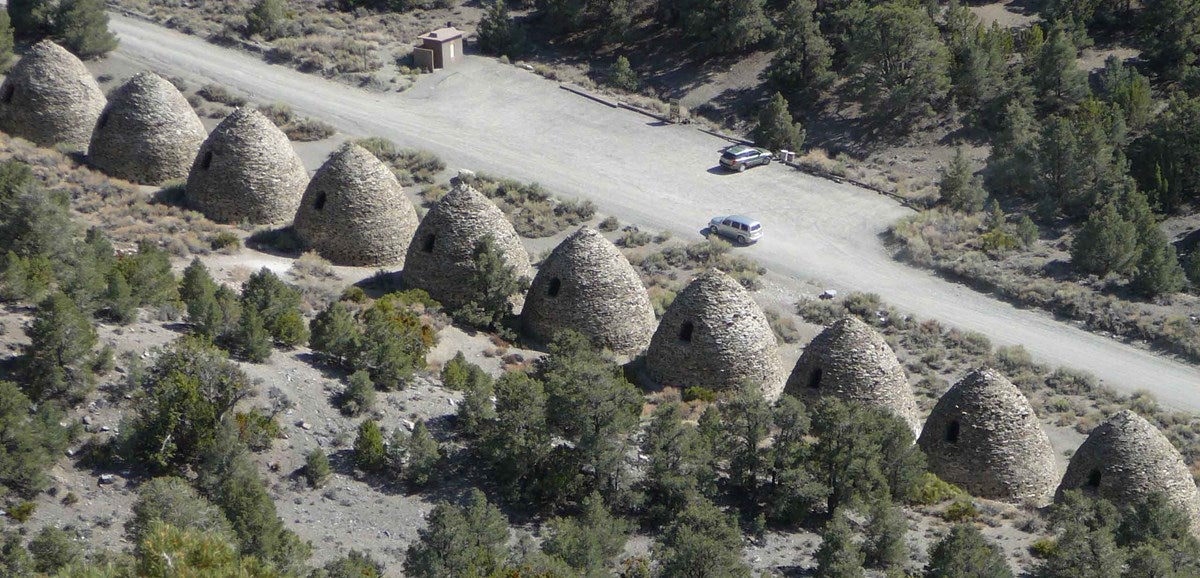
A major attraction at Death Valley National Park is the Wildrose Charcoal Kilns . These beehive-shaped historic structures were built and used starting in 1877 by a mining company that produced charcoal and turned Death Valley ore into silver .
These kilns were only used for a few years, which is why they remain in such good condition today. These structures stand 25 feet high and are said to be some of the best examples of historic kilns in the western U.S.
A trip to Death Valley National Park will be one to remember for the rest of your life, no matter when you visit. However, there are better times to visit than others if you are hoping to experience specific activities. Below are the best times to plan a Death Valley National Park trip.
Best Time To Visit Death Valley National Park in the Winter
February is the best winter month to visit Death Valley National Park. The temperatures are warmer, with lows in the upper 40s and highs in the mid-70s. Not only is the weather ideal during February, but the crowds are much lighter . However, there is a greater chance of rain.
Best Time To Visit Death Valley National Park To Avoid Crowds
December is the best month to visit if you’re looking for the fewest crowds. Temperatures range from the low 40s to the 70s, making it an ideal time to visit with few crowds and pleasant weather.
There are plenty of activities for adventurers during the winter months, such as snowshoeing to Telescope Peak and being able to explore the dunes without the miserable heat.
Best Time To Visit Death Valley National Park for Wildlife
If you’re hoping to see the wildlife that makes its home in Death Valley National Park, planning a trip in the fall is best. November is an excellent month to visit the park. The crowds start dissipating, so the chance of spotting wildlife is higher . The weather is also agreeable, making it a great time to hike and camp.
Cheapest Time To Visit Death Valley National Park
Planning an early summer trip to Death Valley National Park is a great way to be frugal while traveling. Late May or early June is an optimal time to visit Death Valley. The park is less crowded at this time which makes for a less stressful visit.
Hot Tip: Lodging rates and flight pricing is typically less expensive in the early summer months.
Annual Events in Death Valley National Park
Several annual events take place in Death Valley National Park. There’s an event available for every adventurer, from marathons to astronomy events. Let’s take a look at some of the exciting events that take place in this park each year.
Death Valley ’49ers Annual Encampment
Death Valley ’49ers Annual Encampment happens every November. Volunteers host this event at a non-profit organization that aims to spread awareness and appreciation about the Death Valley area. This event features live music, craft fairs, and presentations that pay tribute to the people and history of the region .
Death Valley Dark Sky Festival
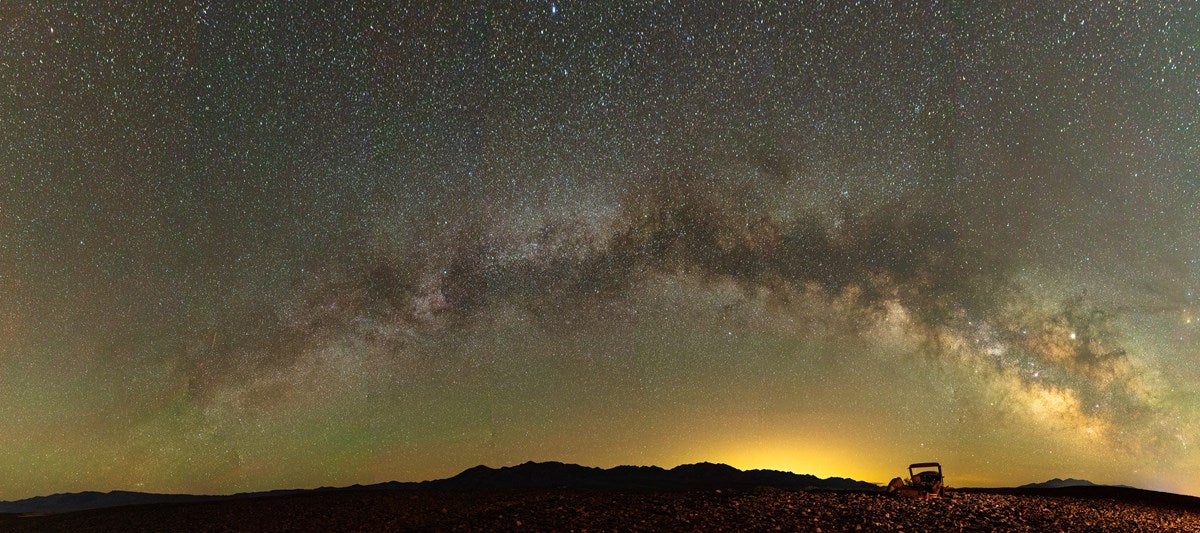
Each year in February, visitors can come to the Death Valley Dark Sky Festival to experience an incredible stargazing event.
Death Valley has received the highest ranking of darkness by the International Dark-Sky Association. It is designated as a Gold Tier Dark Sky Park, and guests can visit during this festival to learn about the night sky and the park’s landscapes.
Death Valley National Park partners with Death Valley Natural History Association and other organizations, including NASA’s Goddard Space Flight Center and California Institute of Technology, to provide this incredible astronomical event each year.
Death Valley Trail Marathon
Death Valley Trail Marathon is a half-marathon and marathon that takes place each year in December. The races begin in the town of Beatty and take runners on a gravel course through the scenic wilderness of Death Valley National Park. This event has been taking place for over 30 years and provides a one-of-a-kind, unforgettable experience at Death Valley National Park.
Lodging won’t be a problem when visiting Death Valley National Park. Options are abundant both in and near the park . Whether you prefer camping, staying in a lodge, or being pampered in a luxury resort, you can find exactly what you’re looking for.
Let’s check out the different accommodations found in and around Death Valley National Park.
Inside the Park
Death Valley National Park has a variety of campgrounds and 4 different areas where visitors can lodge during their park visit. These lodging areas include Stovepipe Wells Village, The Oasis at Death Valley, The Ranch at Death Valley, and Panamint Springs Resort . Here’s a look at the lodging options available inside the park.
Camping at Death Valley
There are 4 types of campgrounds available at Death Valley National Park, including developed campgrounds , primitive campgrounds , private campgrounds , and backcountry campgrounds .
There are 7 developed campgrounds throughout the park. Each of these campgrounds is accessible by a paved road . These campgrounds also have water, toilets, and trash services provided.
The primitive campgrounds are accessed by unpaved roads and have no services available for campers. There are 5 such campgrounds available. The National Park Service does not run the private campgrounds within the park.
These campgrounds include Stovepipe Wells RV Park, Panamint Spring Resort, and The Ranch at Death Valley. Camping in one of the private campgrounds requires a reservation in advance.
Hot Tip: Backcountry camping is available in many parts of the park as long as you camp a mile or further from any paved or dirt roads. Free permits are available and required for several areas for backcountry camping.
The Inn at Death Valley
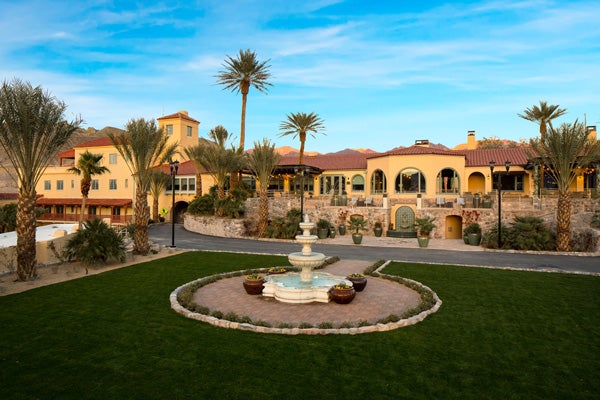
The Inn at Death Valley is a historic inn offering luxury accommodations. It’s located in the Furnace Creek area of the park. Known as the crown jewel of Death Valley, this historic inn has been providing incredible accommodations since 1927 .
The Inn at Death Valley is an AAA-rated 4-Diamond Resort with superior amenities such as brand-new guest rooms and a spring-fed pool, and you can even get massages on site.
Panamint Springs Resort
Panamint Springs Resort is located in the Panamint Springs area of the park. This resort is small and rustic and gives guests a western-style experience.
This resort features 14 historic motel rooms, a cottage, 9 brand-new cabin-style motel rooms, and tent cabins . Camping services are available in this resort area. There are full hook-up sites and sites for tent camping as well. Another draw to the Panamint Springs Resort area is the local restaurant, bar, and gas station in a general store.
The Ranch at Death Valley
The Ranch at Death Valley has been serving visitors since 1933. This hotel has 275 rooms and is well known for its lively atmosphere and for providing exciting activities in Death Valley.
This facility is located next to the visitor center. It has incredible facilities, such as a brand-new restaurant, an ice cream and coffee bar, a general store, and a saloon that feels like it’s been pulled from a western movie.
The Ranch at Death Valley used to be a working ranch but has transformed into a family-friendly lodging option. This ranch offers activities such as horseback riding, carriage rides, Jeep rentals, and an 18-hole golf course . The Ranch at Death Valley is a perfect place to unwind and relax while exploring this incredible national park.
Stovetop Wells Village
Stovepipe Wells Village offers resort-style accommodations and a few sites for RV camping. This area features a 90-year-old historic hotel that is a visitor favorite. This park area provides a tribute to the American West Gold Rush era.
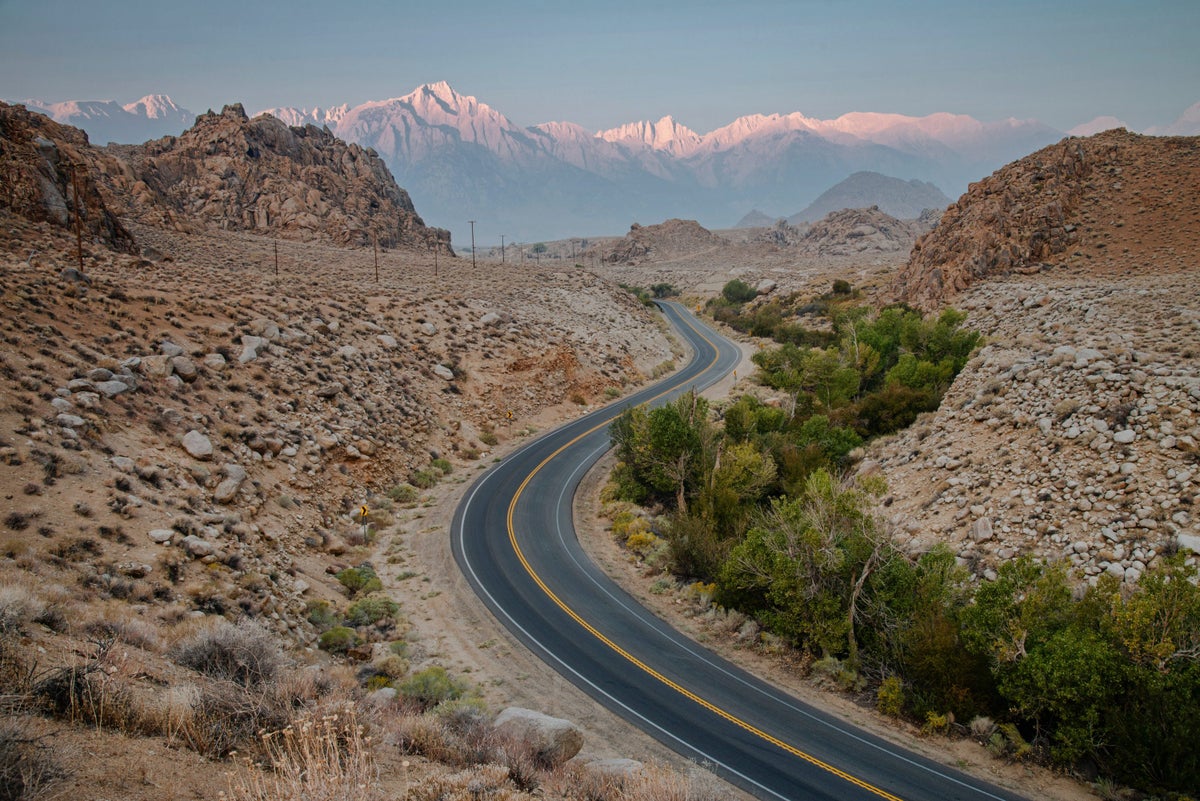
There are several towns near Death Valley National Park that are perfect for those who prefer lodging nearby. Three well-known cities that are great places for setting up a base camp include Beatty, Lone Pine, and Shoshone . From historic motels to RV campgrounds, there’s something for every traveler near Death Valley National Park.
Beatty, California
The town of Beatty is known as the gateway to Death Valley . This small town is just 20 minutes from the park’s Hell’s Gate entrance. Beatty is a former mining town with many sights and activities on offer, including museums, living historians that reenact life during the 19th century, and more.
Beatty has unique lodging opportunities, including a hotel for extraterrestrial enthusiasts (the Atomic Inn) and several small motels and RV parks. Beatty also has an incredible array of unique restaurants, from classic hometown diners to cafes to Wild West saloons.
Lone Pine, California
Lone Pine is 2 hours from Death Valley National Park and an ideal destination for those who seek adventure. Located between the Inyo and Sierra Nevada mountain ranges, this town is brimming with history and adventure .
There are plenty of lodging options in town, and plenty of dining options, including gourmet restaurants, pizza parlors, Mexican restaurants, saloons, and cafes.
This town is known for its adventure opportunities, such as exploring the surrounding mountains, hiking, climbing, and visiting museums, such as the Museum of Western Film History , and shopping in the historic downtown area.
Shoshone, California
Shoshone is a desert town an hour away from Death Valley National Park. Historically, this town was a railroad center and a place for local miners to rest and relax. Since then, Shoshone has become a gateway town for those visiting the park.
This town has many lodging opportunities, such as retreats, historic cabins, and RV parks. Shoshone has several dining options, with the Crowbar Café and Saloon being a visitor favorite.
The opera house has a variety of exciting programming to offer visitors throughout the year, and there are many opportunities for outdoor adventures, such as hiking, golfing, and horseback riding.
There is a great number of dining options in Death Valley National Park. Every lodging area has at least 1 restaurant on offer. From saloons and watering holes to fancy dining rooms, there’s something for every palate at Death Valley National Park. Let’s look at 3 popular places to get a bite to eat.
Badwater Saloon
Badwater Saloon is open daily for lunch and dinner. This restaurant is located in the Stovepipe Wells area. Badwater Saloon serves an outstanding menu of American cuisine , featuring burgers, salads, and sandwiches.
This saloon also offers an impressive selection of wine, specialty cocktails, and Western spirits. This is the perfect place for park guests to enjoy a good meal and company and refuel from their park outings.
The Inn at Death Valley Dining Room
The Inn at Death Valley Dining Room is another incredible option in the Oasis resort area of the park. This dining room serves a menu featuring classic dishes with the exciting flavors of cactus, date, pomegranate, and citrus sprinkled throughout many dishes on the menu.
This dining room is open for breakfast and dinner daily and is a more formal establishment. Reservations are required in advance, and the dress code is resort attire.
Toll Road Restaurant
Toll Road Restaurant provides visitors with a unique culinary experience. This restaurant is one of the finest restaurants in Death Valley National Park.
The restaurant is open daily for breakfast, lunch, and dinner . With generous portions of delicious food and exceptional service, Toll Road Restaurant should be at the top of your list of things to do while visiting Death Valley National Park.
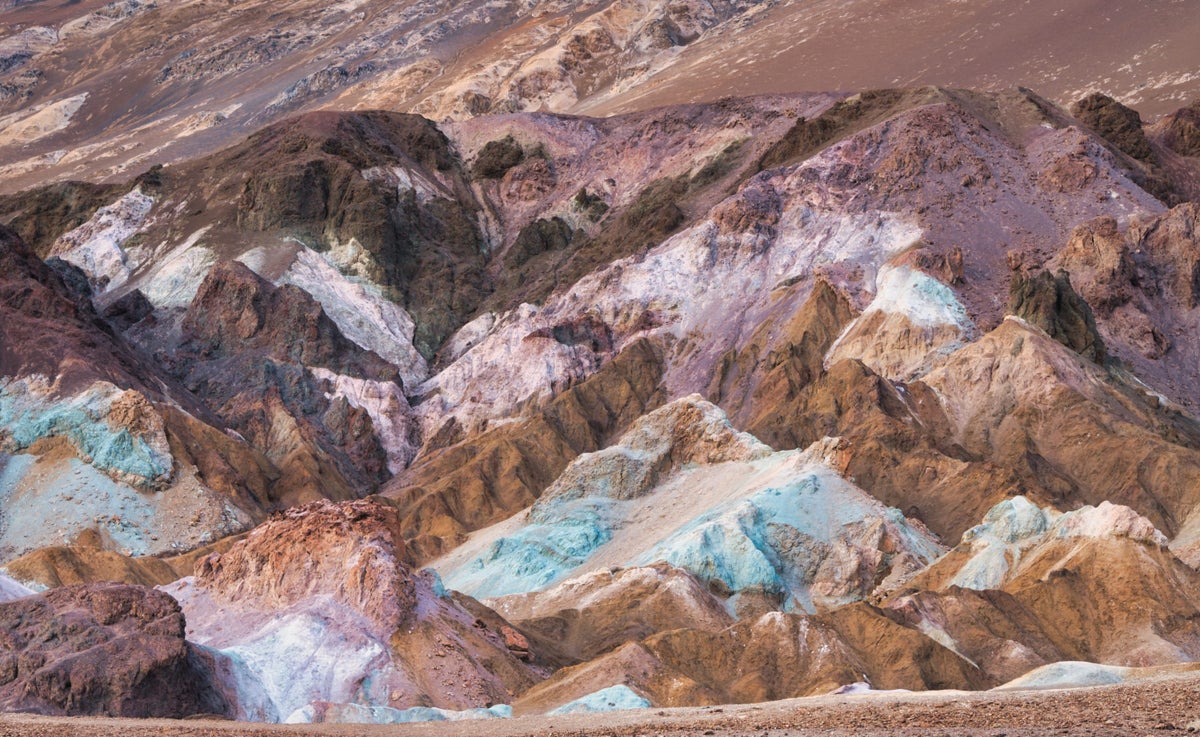
1. A New Park Is Born
Before Death Valley was established as a national park, it was a national monument. Death Valley was designated a national monument in 1933, and decades later, in 1994, Congress declared it a U.S. national park.
2. Largest Park in the Lower 48 States
Death Valley National Park is the largest national park found in the lower 48 states. This park is located in California and Nevada and spreads over 3.4 million acres across the desert landscape.
3. Original Inhabitants
The Timbisha Shoshone Tribe originally inhabited Death Valley. They were hunters and gatherers who believed all their needs could be met by living off the land. They gathered the pinyon pine nuts and mesquite beans found in the area. Because the land was so special to this group, they had many sacred places throughout the park. These areas are still considered sacred today.
4. A Miner’s Paradise
Death Valley National Park has been an ideal location for mining for over a century. An abundance of minerals has been found in this area , including silver, gold, tungsten, ore, copper, lead, zinc, borax, and antimony. In 2005, the last mining operation closed its doors.
5. The History of the Name
In the winter of 1849 to 1850, a group of pioneers became lost in the Death Valley area. One group member died during this time, and the others felt the same would happen to them. The men assumed their location would be their grave.
Fortunately, the rest of the lost pioneers were rescued by 2 Good Samaritans. Once they found their way and headed for home, 1 man said, “Goodbye, Death Valley.” The nickname stuck, and so became Death Valley.
6. Lights, Camera, Action
Death Valley National Park has been a popular location for dozens of movies and television shows over the years. Some of the most popular movies filmed in the park include “Star Wars: Episode IV – A New Hope” and “Star Wars: Episode VI – Return of the Jedi.”
7. A Hidden Castle
A castle can be found in Death Valley National Park. Grapevine Canyon is home to a hidden castle called Death Valley Ranch, nicknamed Scotty’s Castle.
This castle was built as a vacation getaway by a man named Albert Mussey Johnson. Walter Scott, a local cowboy and friend of Albert’s, convinced everyone that Johnson built his home with money from secret mines in the area. This dream home can still be visited and toured today. It gives a glimpse into what life was like during the 1920s and 1930s.
8. Hottest Place on Earth
Furnace Creek, located in Death Valley National Park, is the hottest place on earth . The highest recorded temperature in this location was documented in July of 1913 when the thermometer hit 134.1 degrees.
9. A Rare Fish
Death Valley National Park is home to a rare fish called the Devil’s Hole Pupfish. These fish are iridescent blue and can be seen in Devil’s Hole, which is a geothermal, water-filled cave system in Death Valley. These native fish are at risk of becoming extinct, with the most recent count finding just 175 fish.
10. “Death Valley Days” TV Series
“Death Valley Days” was a television series based on and filmed in Death Valley National Park. The episodes would tell stories of key people and events in Death Valley and had some famous hosts, including President Ronald Reagan.
Death Valley National Park is a part of the U.S. you won’t want to miss. Don’t be fooled by its name because Death Valley pulses with life, wonder, mystery, and beauty. Explore Death Valley National Park and discover the adventure, history, and stunning natural beauty that awaits you.
Frequently Asked Questions
Are there fees for visiting death valley national park.
A pass must be purchased upon entering the park. A pass costs $30 per vehicle and provides access to the park for 7 days.
How long should I plan my trip to Death Valley National Park?
This park is massive and has many different areas to explore. Much of the park can be explored in 2 to 3 days, but an ideal trip would be 4 to 7 days. An extended trip provides a less rushed experience and more time to explore various sites.
What is the weather like in Death Valley National Park?
Winter temperatures can get as low as 15 degrees, and summertime highs typically reach up to around 120 degrees. The highest recorded temperature has been 134.1 degrees. It is very dry in the park, so you don’t have to worry about experiencing much rain on your trip to Death Valley.
Can I bring my dog to Death Valley National Park?
The National Park Service does not recommend guests bring their dogs to Death Valley National Park due to the heat and natural dangers. While there are some areas where dogs are permitted, most park areas do not allow dogs.
Was this page helpful?
About Amar Hussain
Amar is an avid traveler and tester of products. He has spent the last 13 years traveling all 7 continents and has put the products to the test on each of them. He has contributed to publications including Forbes, the Huffington Post, and more.
INSIDERS ONLY: UP PULSE ™

Get the latest travel tips, crucial news, flight & hotel deal alerts...
Plus — expert strategies to maximize your points & miles by joining our (free) newsletter.
We respect your privacy . This site is protected by reCAPTCHA. Google's privacy policy and terms of service apply.
Related Posts
![tourism death valley Virtual Tours of the 63 Iconic U.S. National Parks [2024]](https://upgradedpoints.com/wp-content/uploads/2022/11/Arches-National-Park-View.jpg?auto=webp&disable=upscale&width=1200)
UP's Bonus Valuation
This bonus value is an estimated valuation calculated by UP after analyzing redemption options, transfer partners, award availability and how much UP would pay to buy these points.

6 Must-See Places & Best Things to Do in Death Valley (+Map & Tips)
By Author Jurga
Posted on Last updated: October 25, 2023

Death Valley at the border of California and Nevada is one of the most visited National Parks in the USA . You may have heard that it’s the hottest and driest National Park and that the lowest point of North America can be found here. But there’s so much more to Death Valley than that. And there is more to see and do in Death Valley than it looks at first sight!
In this article, we share some of the most beautiful places to see in Death Valley and the best things to do for first-time visitors.
We only focus on the VERY BEST sites that are worth your time the most if you only have a few hours or a day in Death Valley. If you plan well and – depending on the season – you can easily see them all in a day. Although, spending at least one night here can be a special experience too!
Good to know: All these Death Valley must-sees are accessible in a regular car (so no 4WD is needed). However, some are not accessible for larger vehicles (RVs, motorhomes).
At the bottom of this article, we also included a few additional suggestions for places to visit and things to do in Death Valley if you have more time .
But if you are visiting for the first time and want to see the best that Death Valley has to offer, then this list will help you do just that. Despite covering just 6 sites and a rather small area, you’ll see a big variety of landscapes and jaw-dropping sceneries that will make a long drive to Death Valley more than worth it!
To help you plan your time, we also include a map and practical info , as well as some useful tips for your first visit to Death Valley. Take a look!
Important update for spring 2024: While most of the main landmarks are accessible, some secondary roads in Death Valley NP are still closed due to last year’s flooding. If you are planning a trip soon, be sure to check the official website for up-to-date conditions.
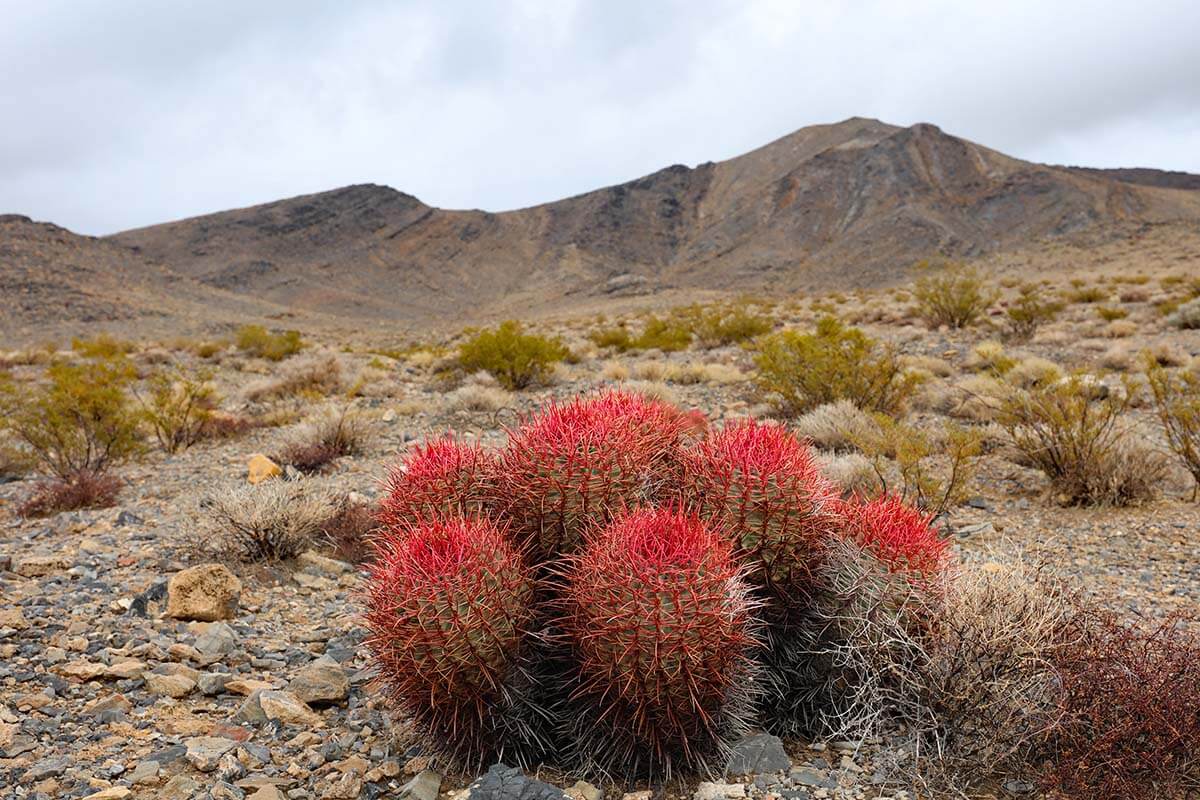
These are the best places to see and things to do in Death Valley:
1. Zabriskie Point
No matter how much time you have in Death Valley – just passing by, visiting on a day trip from Las Vegas, or staying for a few days – Zabriskie Point is not to be missed! This is one of the most beautiful places in Death Valley, with stunning views of multi-colored badlands all around you.
The scenery here is absolutely breathtaking and you can enjoy wide panoramic views of a very large area. This is a desolate and somewhat unearthly landscape, but it looks magical. Golden-brown mudstone hills have distinct shapes, which are formed by erosion and rare but intense water flows.
No two visits here will be the same because all the different shades and tints of color change depending on the light. If you are staying in Death Valley for a few days, consider coming here at different times of the day. Zabriskie Point is one of the nicest places for both – sunrise and sunset in Death Valley.
But there is one more reason why we list Zabriskie Point as number one among the best places to see in Death Valley, and that’s its convenient location and ease of visiting. Located just next to the main road (I-190), the viewpoint is just a short walk from the car. Even though it’s an uphill walk, it’s really not strenuous and takes just a few minutes.
However, if you are visiting Death Valley in the hottest summer months, even this short walk can feel exhausting. Be sure to use sun protection and take some water with you! We once stopped here in July and the moment you step out of the car, it feels like walking into an oven…
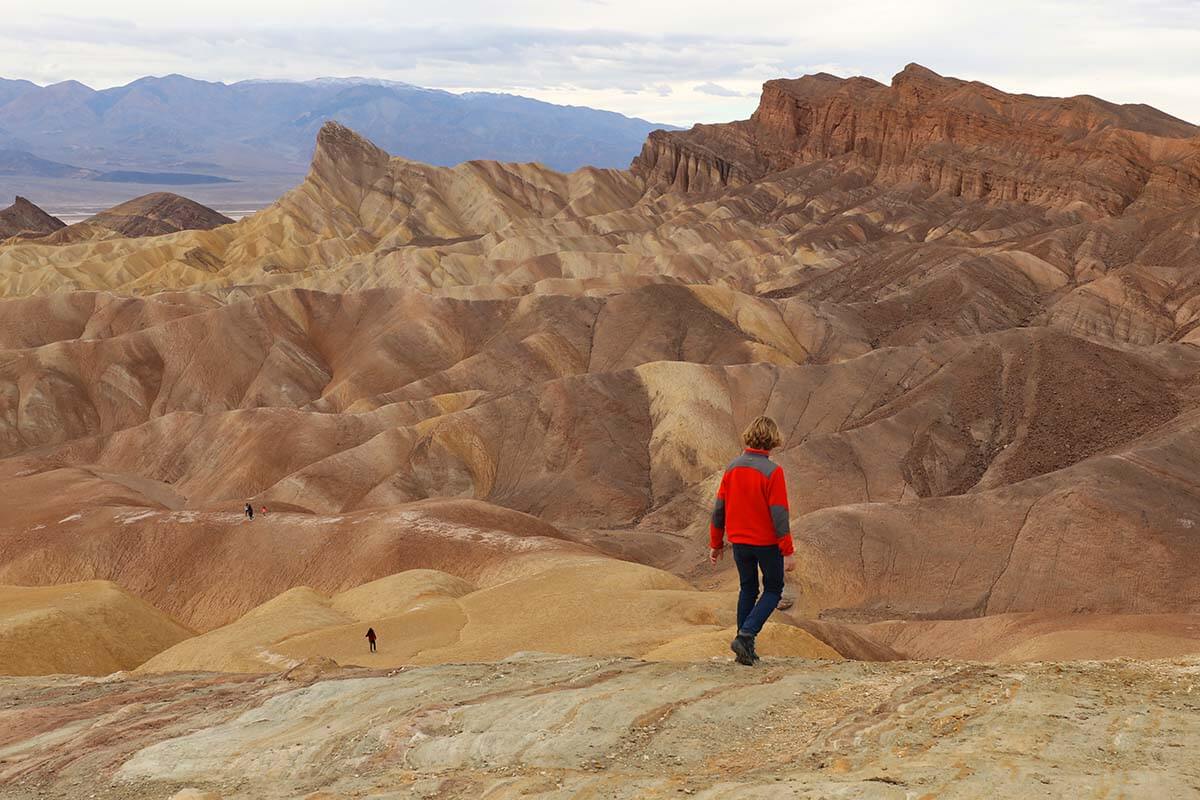
Good to know: Zabriskie Point is one of the most popular places to see in Death Valley. In the peak season (winter months), it can get really busy here.
That being said, we recently visited Death Valley on New Year’s day and had no difficulties finding parking. Also, the area is so big that people spread out beyond the main viewing terrace and it doesn’t feel crowded.
How much time do you need: You can spend as little as 10 minutes here, or you can stay much longer, hike around a bit, etc. The kids love walking up and down these ‘strange’ hills.

2. Badwater Basin
At 282 feet (85.5 meters) below Sea Level, Badwater Basin is the lowest point in North America and one of the lowest elevations on earth. This is the place that made Death Valley famous and is one of the most visited sites in the park.
And indeed, Badwater Basin is absolutely worth a visit. Not just to take a picture of the sign and say ‘been there done that’, but for some of the most unique landscapes you’ll ever see in your life!
Just a few thousand years ago, this place was the site of a 30 ft (9 meters) deep lake. As it evaporated, it left a thick layer of salt. This is what you see here today – a vast salt pan stretching for several miles.
Interesting to know: Badwater Basin gets its name from a surveyor mapping the area. He was glad to find a water pool where his mule could drink, but the animal refused to because the water was too salty. So he wrote on his map “bad water” and the name stuck.
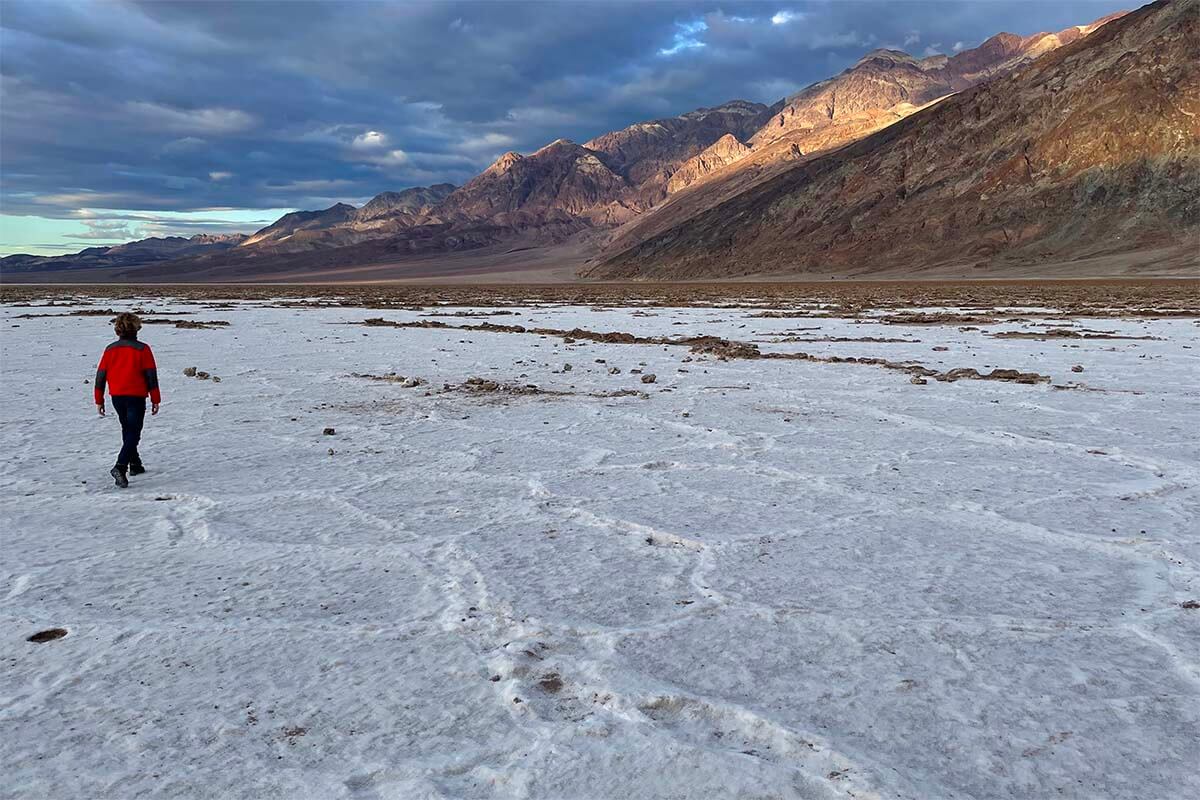
Good to know: Badwater Basin is large, but you shouldn’t just walk anywhere you like. There is a designated parking area (I indicated it on our map). Here, you will find a few boardwalks and a nice straight path leading you to the saltpan.
How much time do you need: If you just want to take a picture of the sign and look around a bit, 10-15 minutes will be enough. However, keep in mind that you have to walk about half a mile in order to reach the main salt pan. If you walk really fast and it’s not too hot, you need about 15 minutes to get there from the car parking. More realistically, you will need 20-30 minutes just to reach it. If you also count the time to look around, take pictures, and walk back, you need about 1 hour for a visit here.
This can be really daunting if it’s hot and I don’t think I would attempt this walk during the day in the summer months… Remember, this is the hottest place in the U.S.!
The good thing is that even if you don’t go all the way, you can see plenty of salt crust closer to the car parking area.
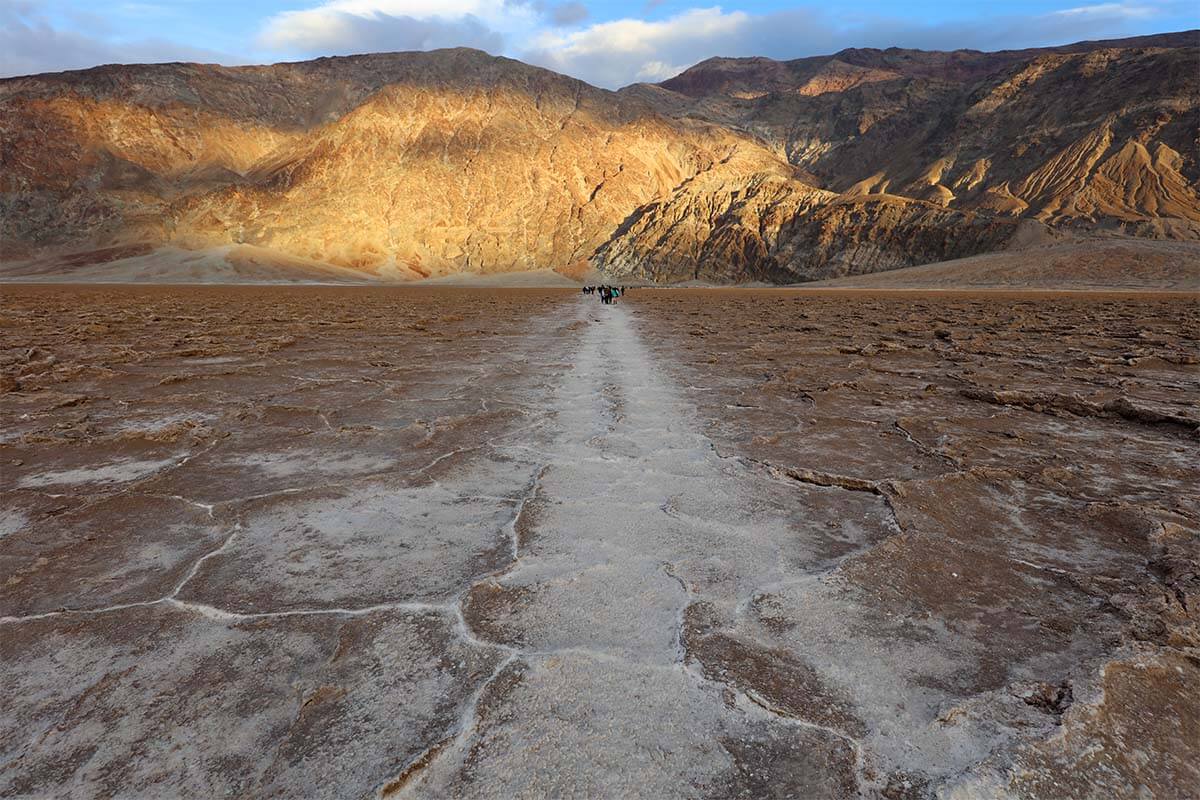
3. Artists Drive & Artists Palette
Artists Drive is another must-see in Death Valley. This is a scenic one-way drive just off Badwater Road. This road is about 9 miles (14 km) long and takes about 20-25 minutes to drive without any stops.
There are a few places where you can stop along the way, but it’s really more about the surreal scenery and the thrill of the drive itself than about the stops. But since you are here anyway, be sure to stop at all the main viewing areas where you can get out of the car and enjoy the colorful scenery around you.
The nicest place here (and one of the must-sees in Death Valley) is Artists Palette , which is the second bigger stop that you’ll come across. Parking is quite limited so you may need some patience.
But the reason why we list Artists Drive so high on this list of top sights in Death Valley is the road itself. With twists, turns, ups and downs, and narrow passages cut out between the rocks, driving here makes you feel like you are part of the unearthly scenery around you.

TIP: Take it slow – not just to enjoy the surroundings, but also for your safety. Also, don’t stop on the road because there are some places where visibility is really limited as you emerge from a sharp corner or drive over a steep hill.
Good to know: Because you don’t even have to get out of the car (or just for a quick photo stop), this is one of the very best things to do in Death Valley in any season. Also in the summer when it’s too hot for anything else, Artists Drive is a great place to visit because you can enjoy it from the comfort of your car.
Important! Please note that cars over 25 feet (7.6 meters) are not allowed on Artists Drive. Even though the road looks perfectly wide at first, there is a good reason for this. The second half of the drive is really not suitable for longer vehicles.
How much time do you need: Count 30-45 minutes for Artists Drive with a few photo stops. Of course, you will need more time if you decide to go for a walk and explore more.
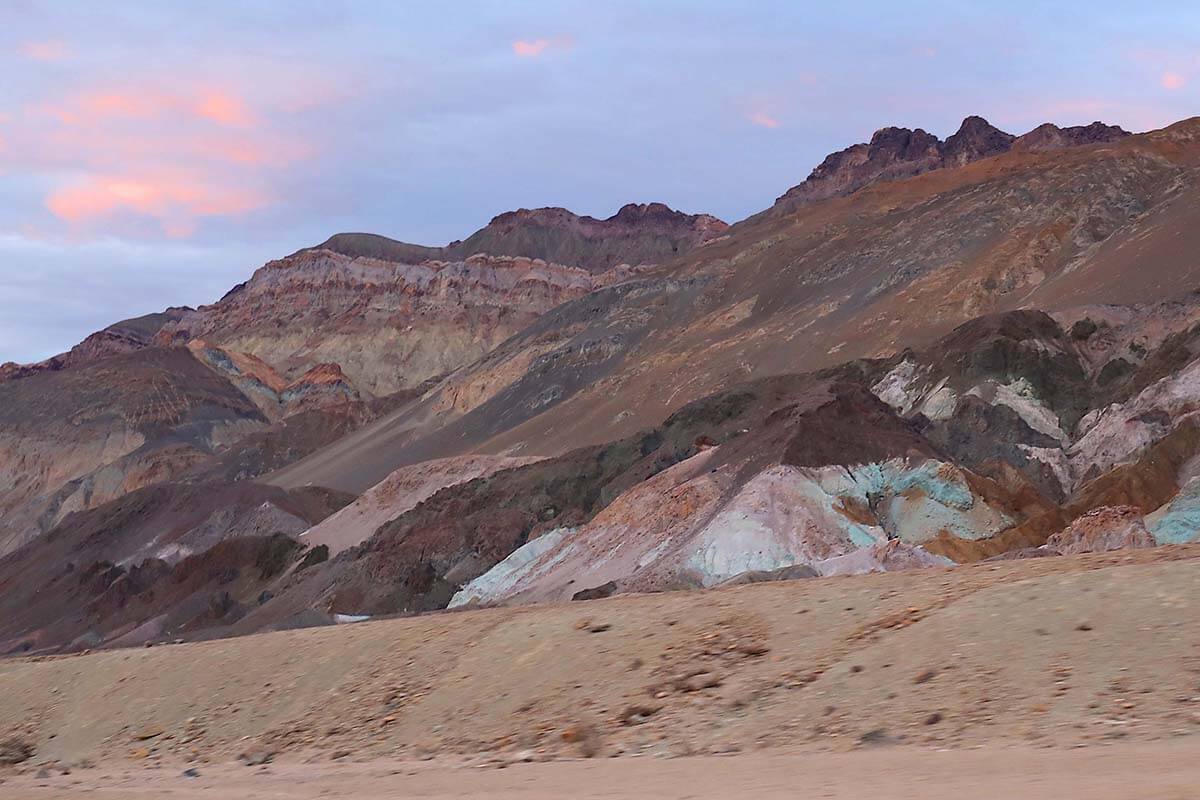
4. Mesquite Flat Sand Dunes
No visit to Death Valley would be complete without at least a quick stop at Mesquite Flat Dunes . Surrounded by mountains on all sides, some of these sand dunes are up to 150 ft (46 m) high.
This is yet another must-see place in Death Valley showing you yet another facet of the incredible diversity of landscapes in this desert park.
Also here, there is a designated parking area, from which you can walk straight into the dunes. The highest dune is about 1 mile from here, but you have to cross lots of sand and smaller dunes to get there, so it’s not a quick walk. Even if it’s not too warm, you should count at least 2 hours round-trip.
But you really don’t have to go that far in order to enjoy the scenery. Even if you just walk 5-10 minutes from the car, it’s a really nice stop on any Death Valley itinerary!
Keep in mind that the sand dunes will look quite different depending on the light. The white sand can turn bright orange with the rising or setting sun.
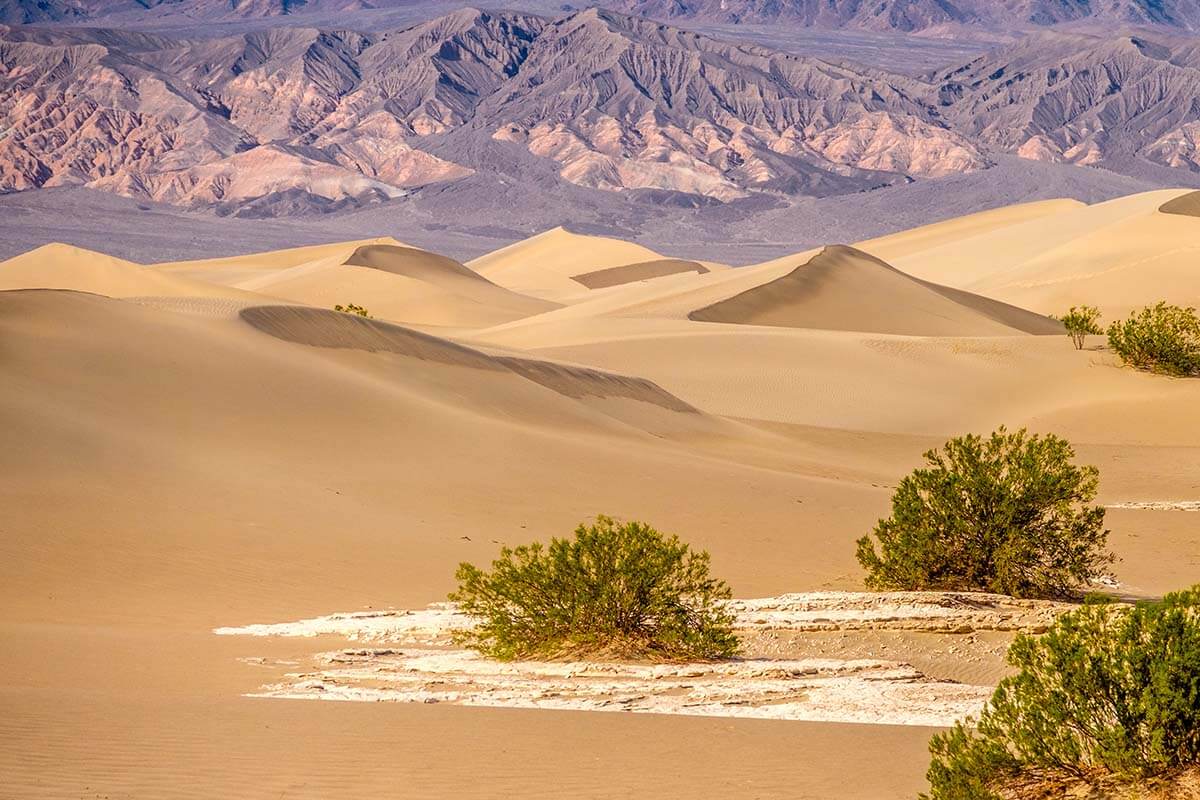
TIP: Sand dunes are spectacular at sunrise and at sunset. These are also the best times of the day to walk around here. It can be very dangerous when it’s hot! If you hike, be sure to do it during the coolest times of the day and carry lots and lots of water.
You can also visit here at night and the dunes are a popular place for Full Moon hikes or stargazing when it’s New Moon. However, be aware that desert wildlife is active at night, so watch out for sidewinder rattlesnakes.
How much time do you need: You can spend 10 minutes here or 2-3 hours – it’s really up to you. Mesquite Flat Dunes are located just next to the main road near Stovepipe Village in the heart of Death Valley, so at least you don’t need much extra time in order to drive here from all the other main sights in Death Valley.

5. Mosaic Canyon
Mosaic Canyon , just near Stovepipe Wells and Mesquite Sand Dunes, is another place that should be high on your Death Valley bucket list. This canyon is a geologic wonder and walking inside it is a really special experience.
While the Mosaic Canyon hiking trail is about 2 miles one-way, you only need to hike about half a mile in order to see the most impressive part of the canyon. And because there is lots of shade from the rocks all around you, this short walk is even doable when it’s warm (but avoid doing any hiking in Death Valley on summer days!).
Good to know: The first part of the trail is rather easy with a few knee-high stones/rocks to climb on the way. However, if you decide to walk beyond the narrow part of the canyon and all the way to the end, be prepared for some serious scrambling (you really need good hiking shoes!).
Because the trail goes a bit uphill, it takes more time to get there than to come back. We explored just the narrow part of the canyon and stopped where it got really wide. We walked for 20 minutes to get there and just 10 minutes to get back.
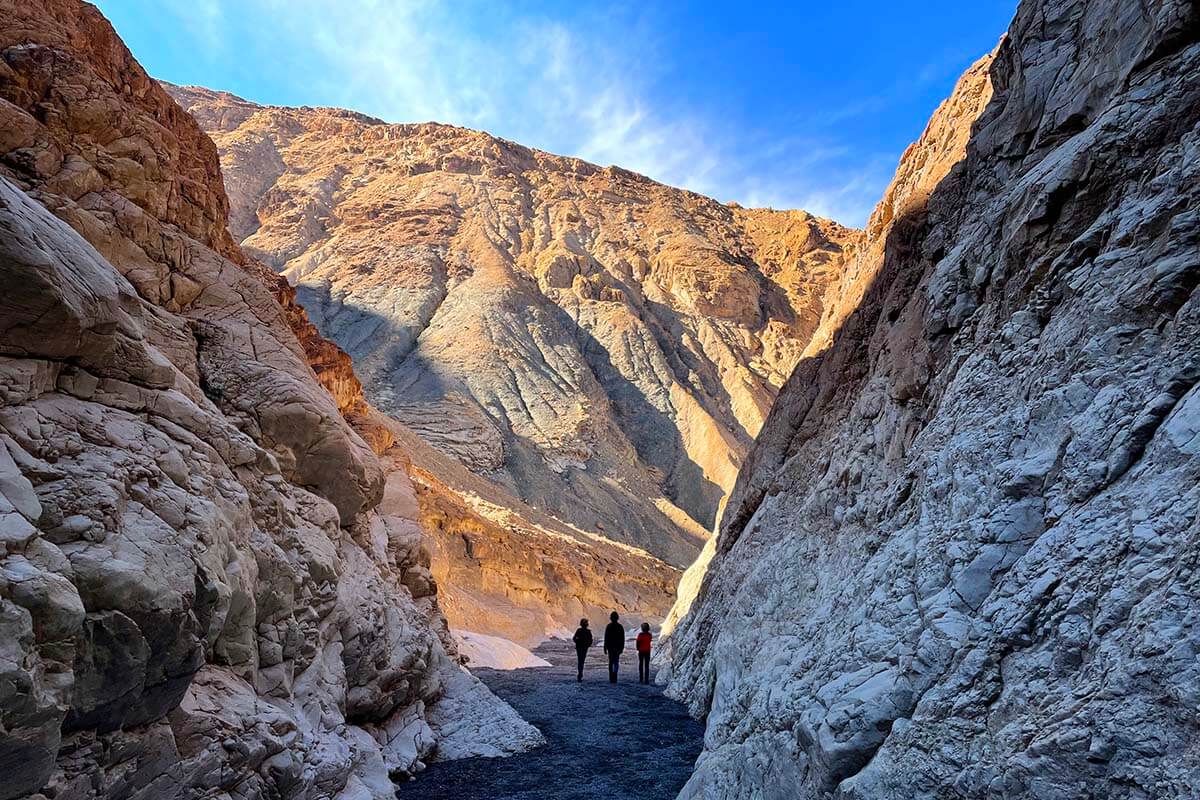
How much time do you need: If you only walk about half a mile, you need about 30 minutes for a visit here. If you decide to hike the entire trail (only recommended in winter), it can easily take 3 hours or even longer depending on the temperatures and your condition. Also here, be sure to pack plenty of water!
It’s important to note that you have to drive the 2-mile Mosaic Canyon Road in order to reach the trailhead. This is a pretty rough gravel road. We saw a few regular cars here, but an SUV or a 4×4 would be better here.
Also, don’t count on GPS or Google Maps for guiding you here. But Mosaic Canyon Road is really easy to find – it’s just southwest of Stovepipe Wells. I indicated this road on our map below to help you find it.
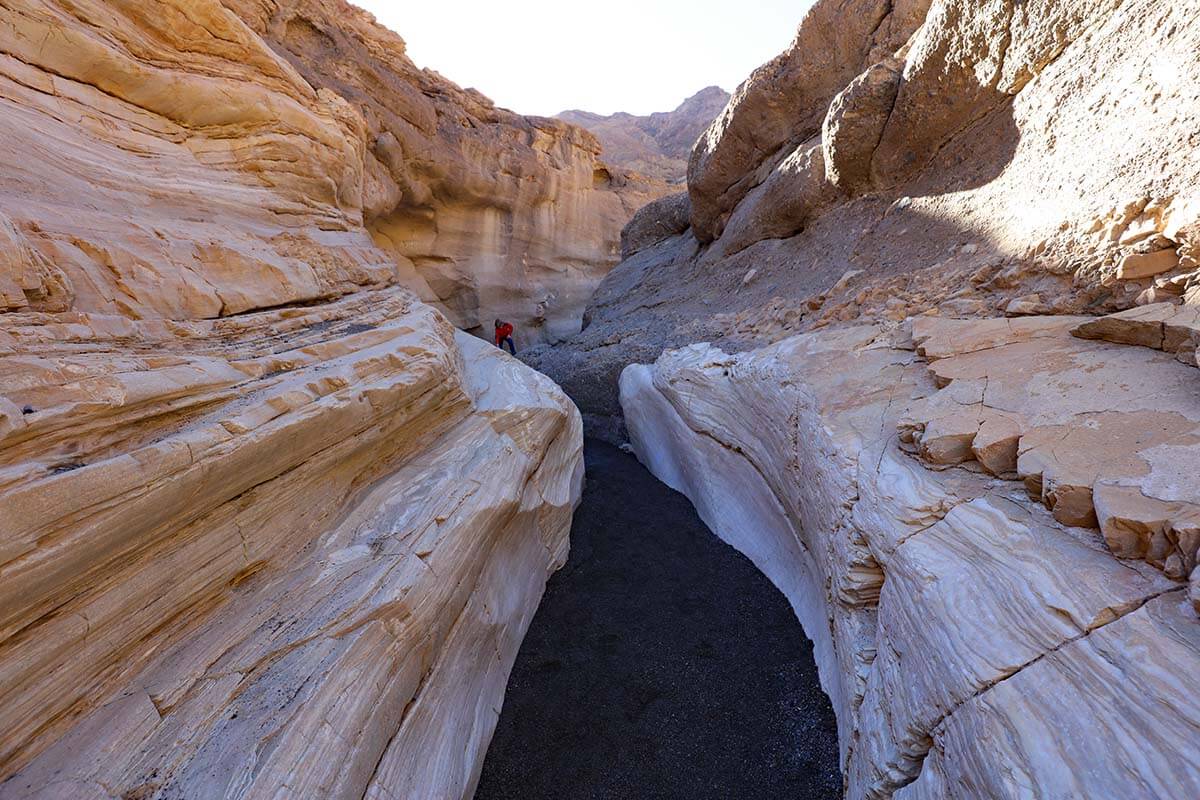
6. Dante’s View
One of the highest easily-reachable viewpoints in the park, Dante’s View is a lookout point offering stunning aerial views of Death Valley. From here, you can see mountain ranges and flat desert valleys stretching for over 110 miles.
The scenery here is truly impressive, giving you an even better appreciation of how much diversity there is in Death Valley.
There is a large car parking and viewing area, so you can see great views without having to walk much at all. However, if it’s not too hot (or too cold and too windy as it was when we visited), you can also climb Dante’s Peak, to the right of the parking. It’s about 10-15 minutes hike to the top and the views should make up for it.
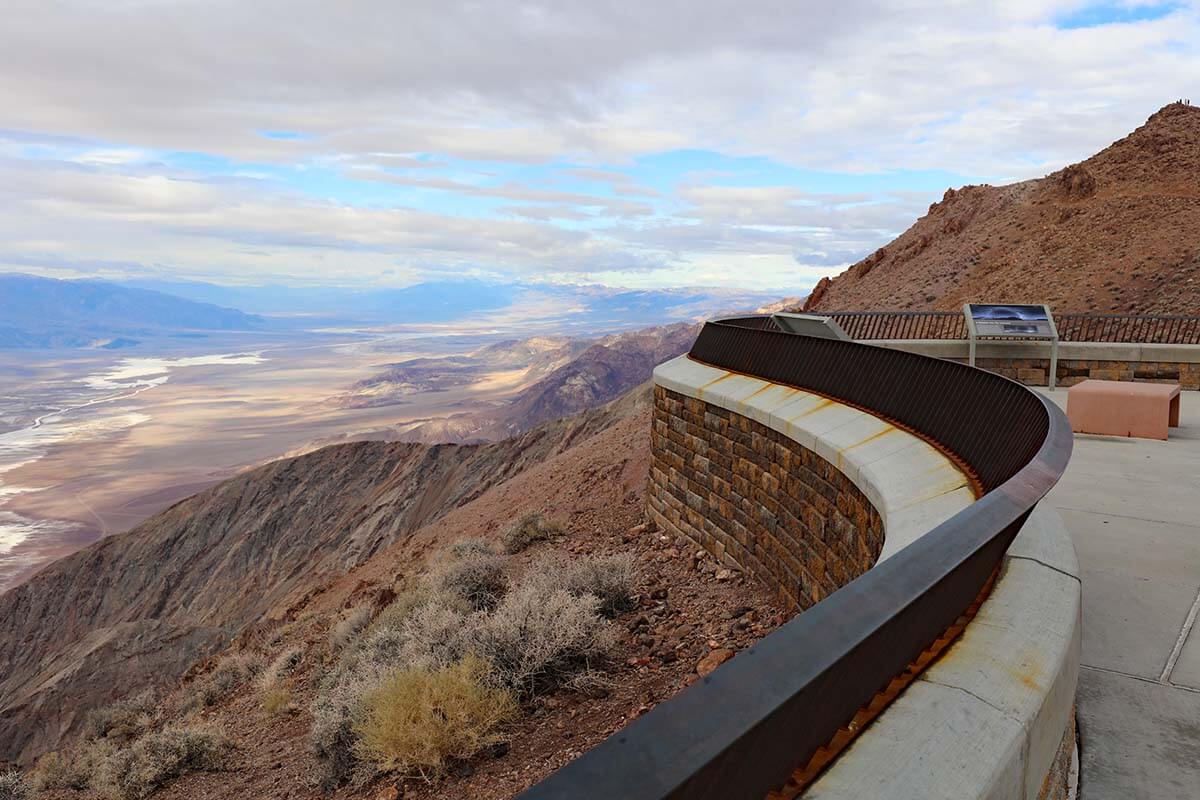
Interesting to know: Towering just above the Badwater Basin, Dante’s View is 5,000 feet higher than the valley floor. That’s a huge difference, not just in terms of elevation or scenery, but also in terms of temperature!
When we were here in January, it was FREEZING cold at Dante’s View with temperatures of just 39 F (4°C) and such a strong wind that we could hardly stand on our feet. We needed winter jackets, gloves, and hats just to walk around at the viewpoint, not even to mention attempting a hike to the peak. In the meantime, it was 65 F (18°C) at Badwater Basin and we ended up in t-shirts after a walk…
How much time do you need: Dante’s Peak is located 13 miles south of Hwy 190. It’s quite a big detour to get here, and driving alone will take you at least 20 minutes one-way. In addition, if you just stop at the viewpoint, you should add about 10 minutes. If you also hike to the lookout on top of the hill, add at least 20-30 minutes extra. Obviously, you will need more time if you decide to do even more hiking in the area.
So realistically, you need at least 1 hour for a visit here. But it’s totally worth it!
Good to know: Also here, the last part of the road is prohibited for vehicles over 25 ft (7.6 m). You can leave your RV/motorhome at the parking lot and walk the last bit, but whether you would want to do this, depends on the temperatures.
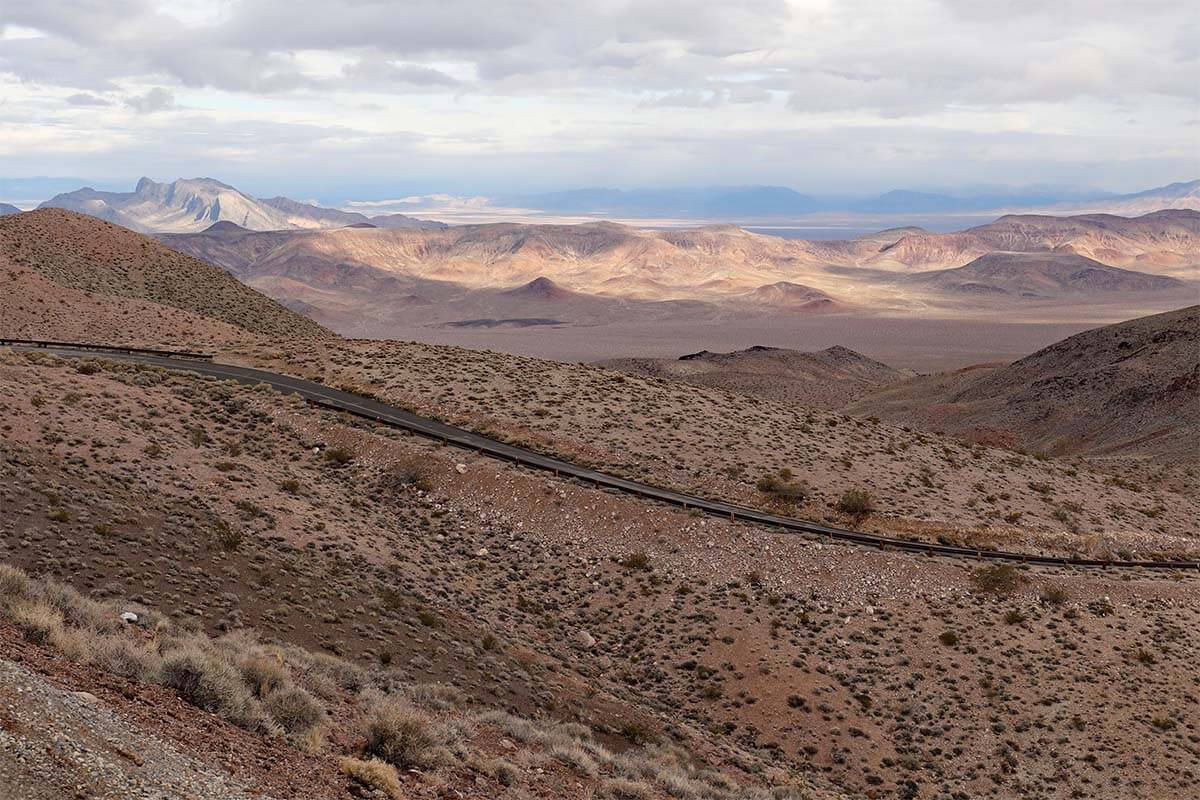
Now that we covered the must-sees in Death Valley, here are a few additional recommendations for places to see and things to do if you have more time.
More Places to See & Things to Do in Death Valley
Stretching over 3.4 million acres (almost 14,000 sq km), you can imagine that there is a lot more to see and do in Death Valley National Park than just the 6 top places mentioned above.
There are countless hiking trails, ghost towns, gold and borax mines (it’s not the best idea to visit them inside though), sliding rocks, and even hot springs and golf (!)…
However, most visitors don’t have the time to explore more, and often it’s simply too hot as well.
Anyway, if you have more time and are looking for more things to do in Death Valley , here are a few additional suggestions.
Ghost towns, machinery, and the remains of the old mining operations
- Harmony Borax Works. This is an old mining operation where you can still see some remains of machinery and buildings from over 100 years ago. It’s a short interpretive trail close to the highway and makes a nice stop just a short drive north of Furnace Creek.
- Furnace Creek. At Furnace Creek, just behind the general store, you can also find some old machinery and interesting objects from the mining days at Death Valley. There is an old train, carts, etc.
- Wildrose Charcoal Kilns. These are old ‘ovens’ used to produce charcoal. They look like cute little houses and make for some nice photo opportunities. However, it’s quite a bit of a detour. Also, the last few miles of the road are a bit rough. When we visited in the winter, we had to skip this because rangers told us that snow chains were needed because of recent snowfall (yes, also this is Death Valley!).
- Ghost towns. In the past, Death Valley had lots of mining sites with small towns built around the mining activity. Today, you can visit some of these ghost towns (Ballarat, Leadfield, Panamint City, Rhyolite), but their conditions vary. Some of them have old dwellings and machinery, but there are also a few where there’s hardly anything left…
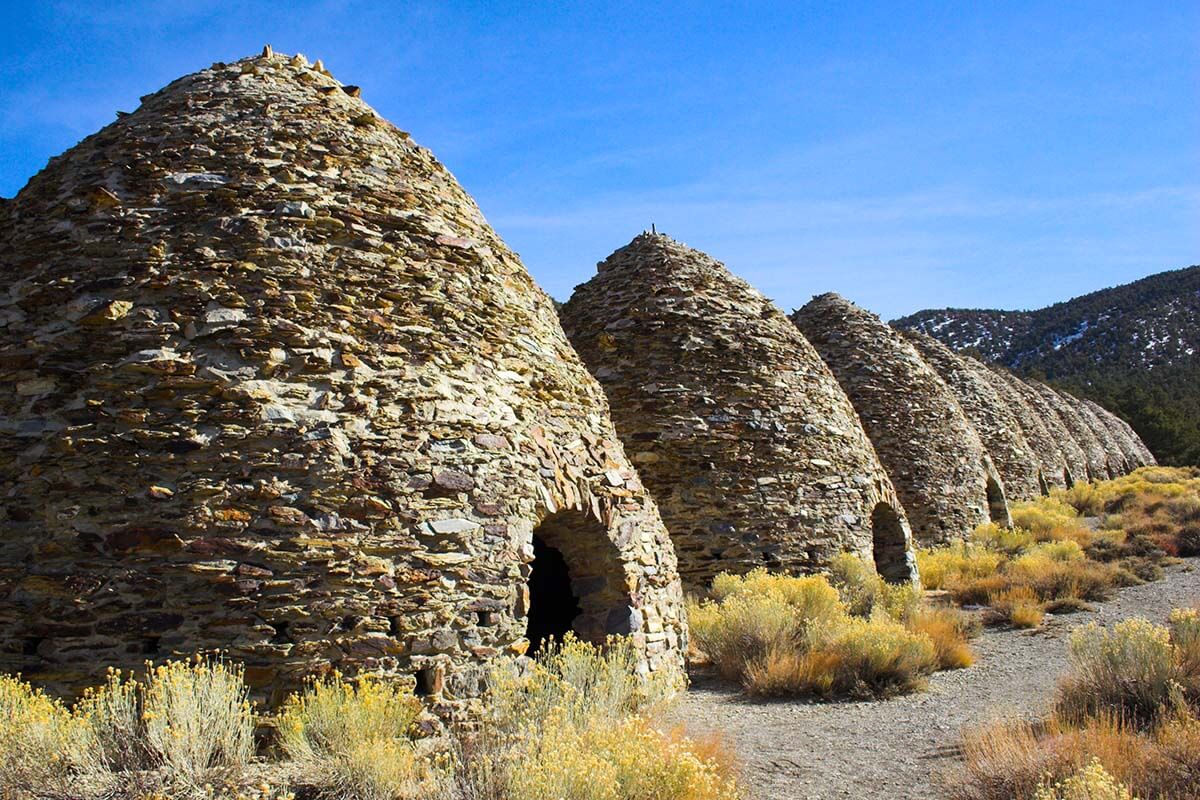
Scenic Views
- Devil’s Golf Course. Crystalized salts have formed some very strange jagged formations, sort of small salt spires. If you want to see some more unique scenery in Death Valley, this can be a nice quick detour on your way to Badwater Basin.
- 20 Mule Team Canyon. This scenic area is located right on I-190 just before you reach Zabriskie Point. There is a short gravel road that takes you into the canyon, which is quite nice (a high-clearance vehicle is recommended, but some people seem to do it in a regular car too). Since it’s a loop road, you get back on the main road again soon. Most people just park next to the main road and walk around a bit.
- Ubehebe Crater. This is a really impressive crater and you can see it straight from the parking area. However, it’s located in the northern part of Death Valley, quite a bit out of the way from the main attractions.
- Father Crowley Vista Point- Rainbow Canyon. This is a nice viewpoint to check out if you find yourself on the western side of Death Valley (e.g. if driving to/from Los Angeles or Sequoia NP).
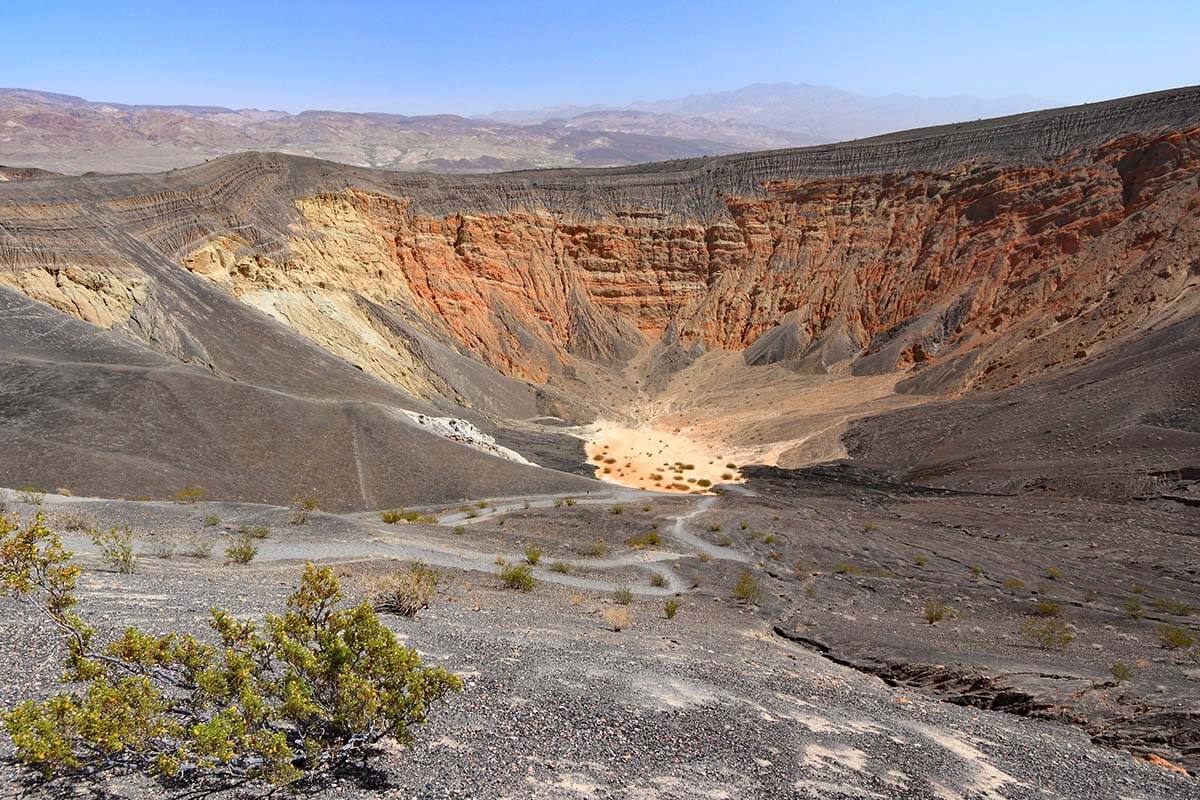
Active things to do at Death Valley National Park
- Horseback riding. There are several places where you can go horseback riding in Death Valley. Especially in the winter months, this can be a great experience and a nice, easy way to explore more surreal landscapes. One of the best centrally-located horse stables can be found at Furnace Creek (next to The Ranch/Oasis Resort ). They offer 1 or 2-hour rides.
- Biking. If you like slow travel, you can also explore Death Valley by bike. Among several other places, rental bikes are available at the above-mentioned resort at Furnace Creek. You can choose between regular road bikes or e-bikes and rent them for half a day, a day, or even a few days. I’d only recommend this if you are visiting in the winter and have plenty of time. There are also bike tours available – you would have to do some additional research on that if interested.
- Swimming. Death Valley has several hot springs. However, most of them are located further away from the main area with the most interesting sights. Anyway, the best places to go for a swim are The Inn At Death Valley and The Oasis/The Ranch Resort at Furnace Creek. Their pools are filled with spring-fed warm water. We were here at New Year and the outdoor pool was warm enough for a swim. It’s not hot though, so perfectly enjoyable in the warmest months as well. However, the pools are only accessible to hotel guests. Another (very simple) accommodation with hot springs is Delight’s Hot Springs Resort in Tecopa, just outside the southeast corner of the park, close to Shoshone.
- Golf. In addition to Devil’s Golf Course (which is obviously not a golf course at all), there is an actual golf course in Death Valley as well. You can find it at Furnace Creek. It’s a bit surreal to see green grass in the desert, but avid golfers will enjoy playing golf on the lowest-elevation course in the world. In the summer, you have to start at 6-7 am or it gets too hot!
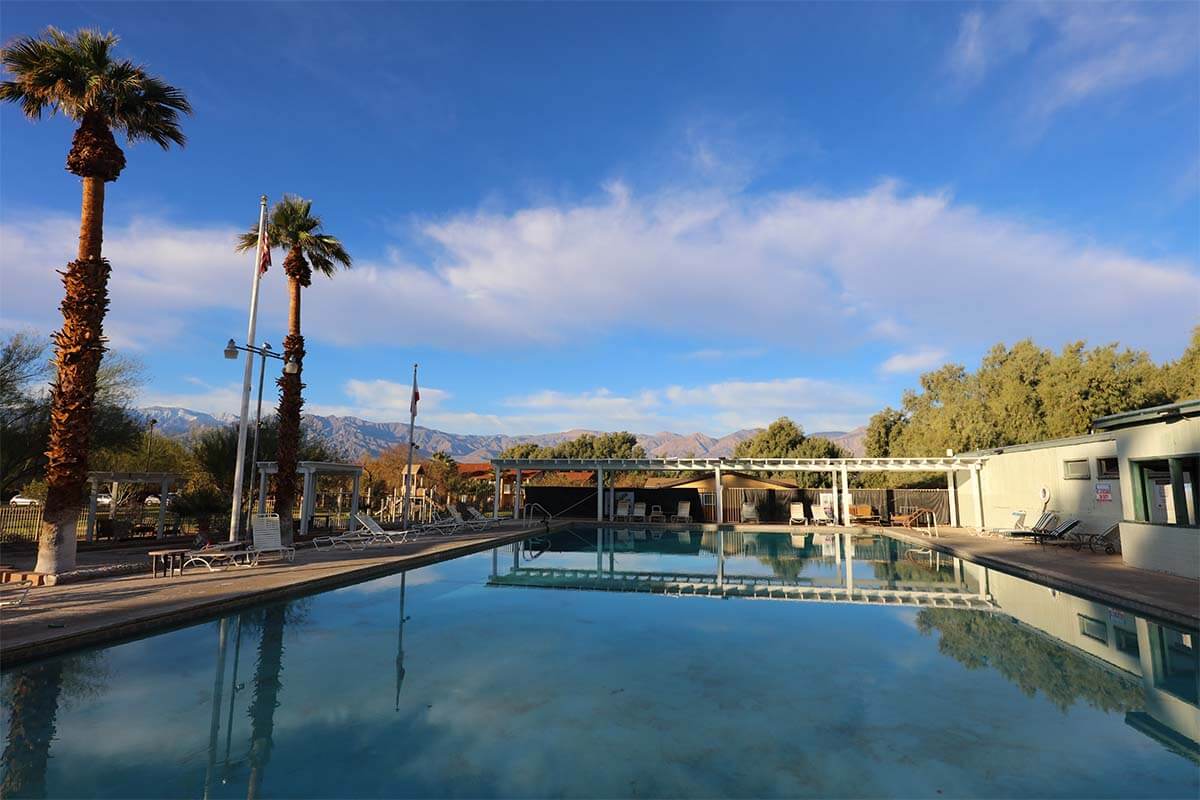
To help you get a better idea of where everything is located, we created this map indicating all the sites mentioned in our article.
As you can see, all the very best places to visit in Death Valley are located rather close to Furnace Creek, in the center of the park.
This area is just a bit over 2 hours away from Las Vegas and so it’s possible to see these top sights in a day (by car or with an organized tour ). In fact, this is one of the best day trips you can do from Vegas !
How to use this map: Use your computer mouse (or fingers) to zoom in or out. Click on the icons to get more information about each place. Click the arrow on the top left corner for the index. Click the star next to the map’s title to add it to your Google Maps account. To view the saved map on your smartphone or PC, open Google Maps, click the menu and go to ‘Your Places’/’Maps’. If you want to print the map or see it in a bigger window, click on ‘View larger map’ in the top right corner.
Practical Information
- Death Valley is the dryest and hottest place in the USA. If you are visiting in the summer, your feet can literally start to burn through your shoes! So adjust your expectations and itinerary based on the season when you visit and don’t do stupid things like hiking in the middle of the day in the summer. Also, always carry plenty of water !
- There is a fee to visit Death Valley and you can get a pass at the visitor center (so not at the entrance of the park). If you have the annual National Parks Pass ( America the Beautiful Pass ), it’s also valid here.
- Death Valley has limited facilities , but you can find fuel and food stores here too. However, everything is very expensive here. It’s best to fill up your tank before you arrive, and you may also want to bring your own snacks/picnic. This will save you money, but also time.
- Because of its size and limited facilities, you need a car (or a motorcycle/RV, etc.) in order to visit Death Valley.
- While the main roads in Death Valley are really good, many side roads are unpaved and in varying conditions. It’s always a good idea to check if your rental car insurance covers gravel roads (most don’t) and it’s even more important to ask park rangers for up-to-date information about the specific places you plan to visit! Also, driving off-road is forbidden!
- When planning your sightseeing at Death Valley, keep in mind that in summer it’s very hot during the day and you won’t be able to do much after 10-11 am. And in winter, the days are short and it gets dark very early (it’s pitch dark from +- 5 pm around New Year).
- You can visit Death Valley in 1 day from Las Vegas , but it’s a long drive (and lots to see when you get there). So be sure to leave early so that you can make the most of your time. If you are only coming for a day from Vegas, consider booking an organized tour . They will bring you to all the top spots in the most efficient way and you’ll be able to rest on your way there and back.
- If you want to, you can spend a night here (or a few, depending on what you want to do). The most conveniently located hotels are The Oasis Resort (aka The Ranch) and The Inn At Death Valley (former Furnace Creek Inn). They are both beautiful resorts with all the amenities you might need. But – like everything else in Death Valley – quite pricey. We stayed at The Oasis/The Ranch when road-tripping between Las Vegas and LA and it allowed us to explore everything at a slower pace.
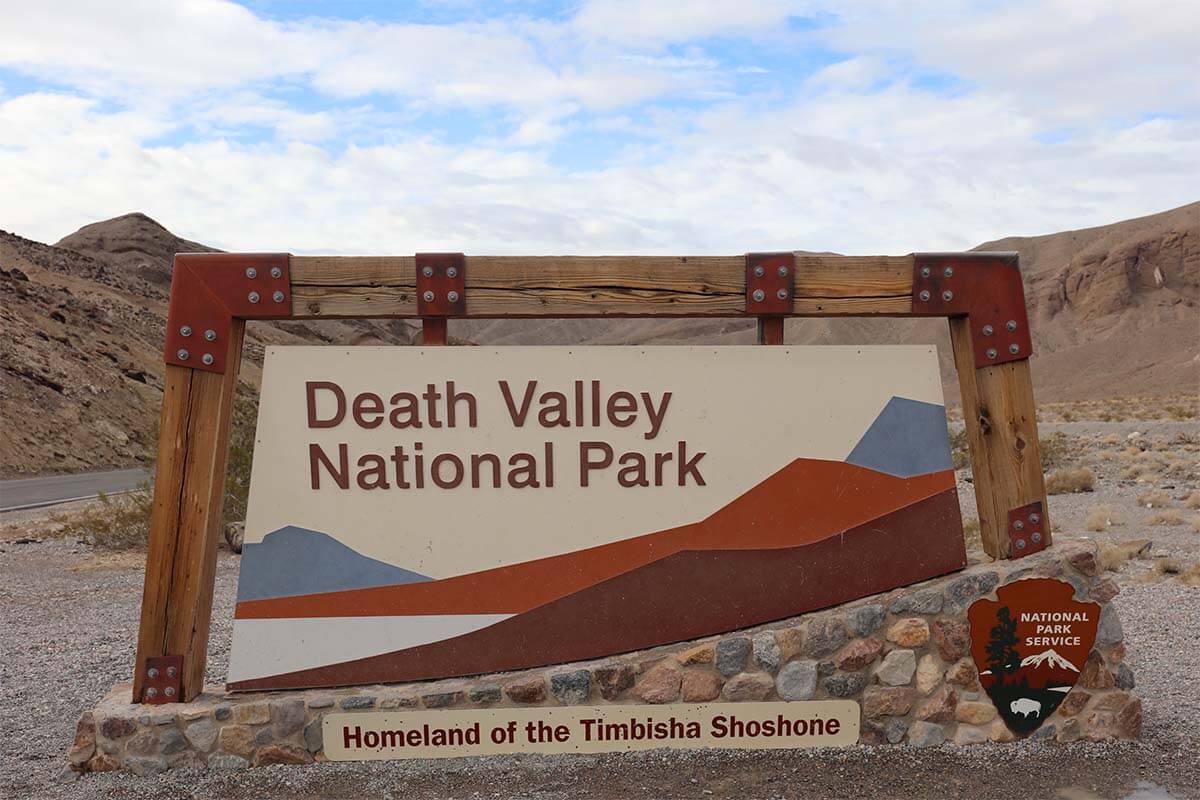
I hope that this guide gives you a better idea of what to expect and what to see in Death Valley National Park. Have a great trip!
TIP: If you are road-tripping in Southwestern USA , you may want to check our other travel guides to a big variety of destinations in the region. Take a look via the links below!
- Best things to do in Las Vegas
- One day in Las Vegas itinerary
- Las Vegas travel tips
- Best day trips from Las Vegas
- One day in Grand Canyon
- Where to stay in Grand Canyon
- Grand Canyon South Entrance
- Grand Canyon in Winter
- Top places to see in Arizona
- Best things to do in Sedona
- Sedona day trip from Phoenix
- Monument Valley
- Grand Canyon – Antelope Canyon – Horseshoe Bend itinerary
- Arches and Canyonlands National Park 1-day itinerary
- Moab itinerary
- Zion – Bryce Canyon itinerary
- Phoenix – Scottsdale Itinerary
- LA Itinerary
- San Diego Itinerary
- Best things to do in Arches National Park
- Best things to do in Canyonlands National Park
- Best hikes in Zion National Park
- Where to stay in Zion National Park
If you found this post useful, don’t forget to bookmark it and share it with your friends. Are you on Pinterest? Pin these images!
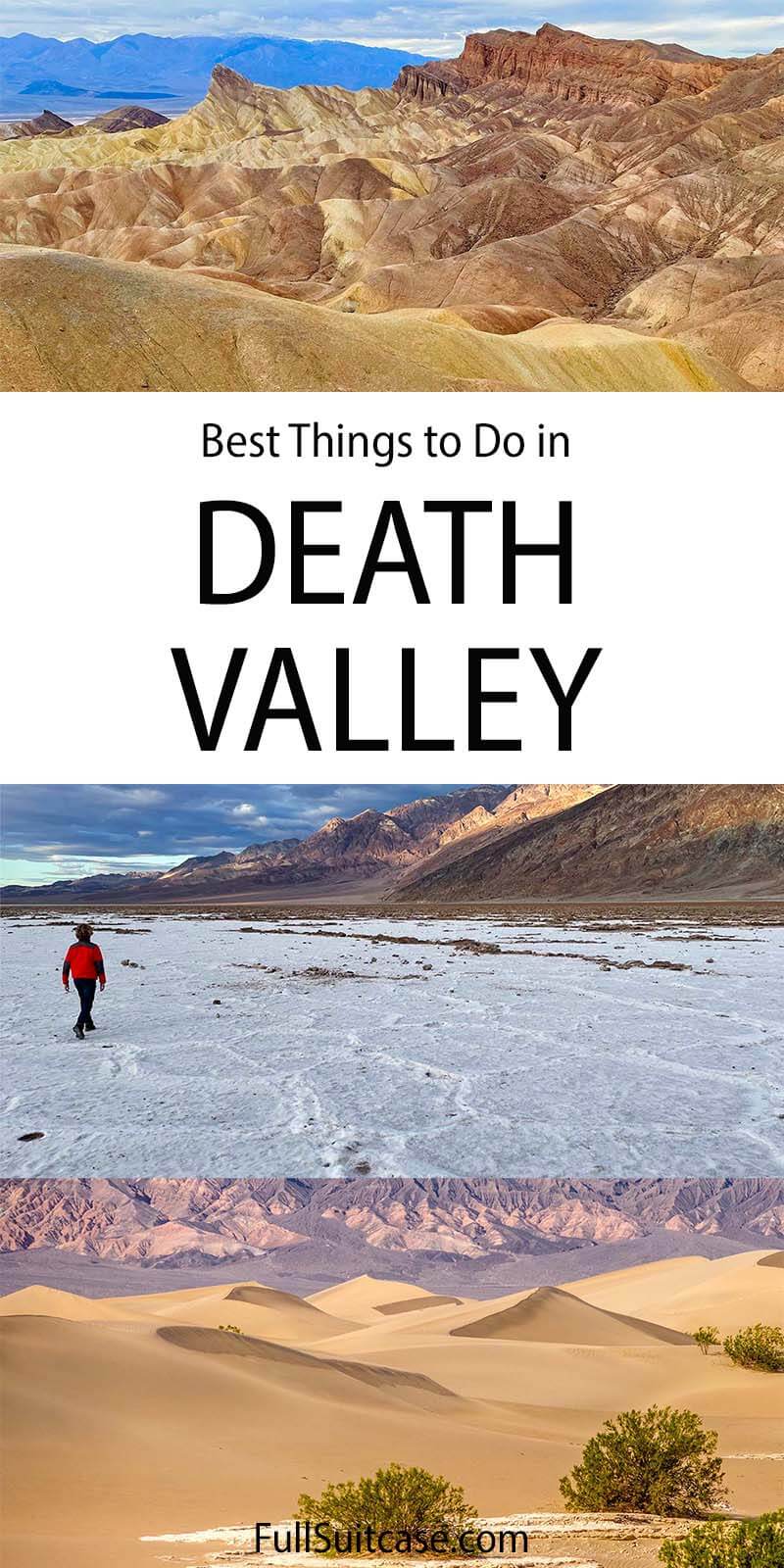
More travel inspiration for USA National Parks:
- Best Things to Do in Yellowstone
- Grand Teton – Yellowstone Itinerary
- Yosemite Travel Tips
- Glacier National Park Itinerary
- Rocky Mountain National Park Itinerary
- Olympic National Park Itinerary
- Acadia National Park Itinerary
- Yellowstone National Park Itinerary
- North Cascades National Park
Seasonal guides:
- National Parks to Visit in January
- National Parks to Visit in February
- National Parks to Visit in March
- National Parks to See in April
- National Parks to See in May
- National Parks to Visit in June
- National Parks to Visit in September
- National Parks to Visit in October
- National Parks to Visit in November
- National Parks to Visit in December
This site uses Akismet to reduce spam. Learn how your comment data is processed .
Home > USA Parks > Death Valley > All The Beautiful Places You Must See in Death Valley
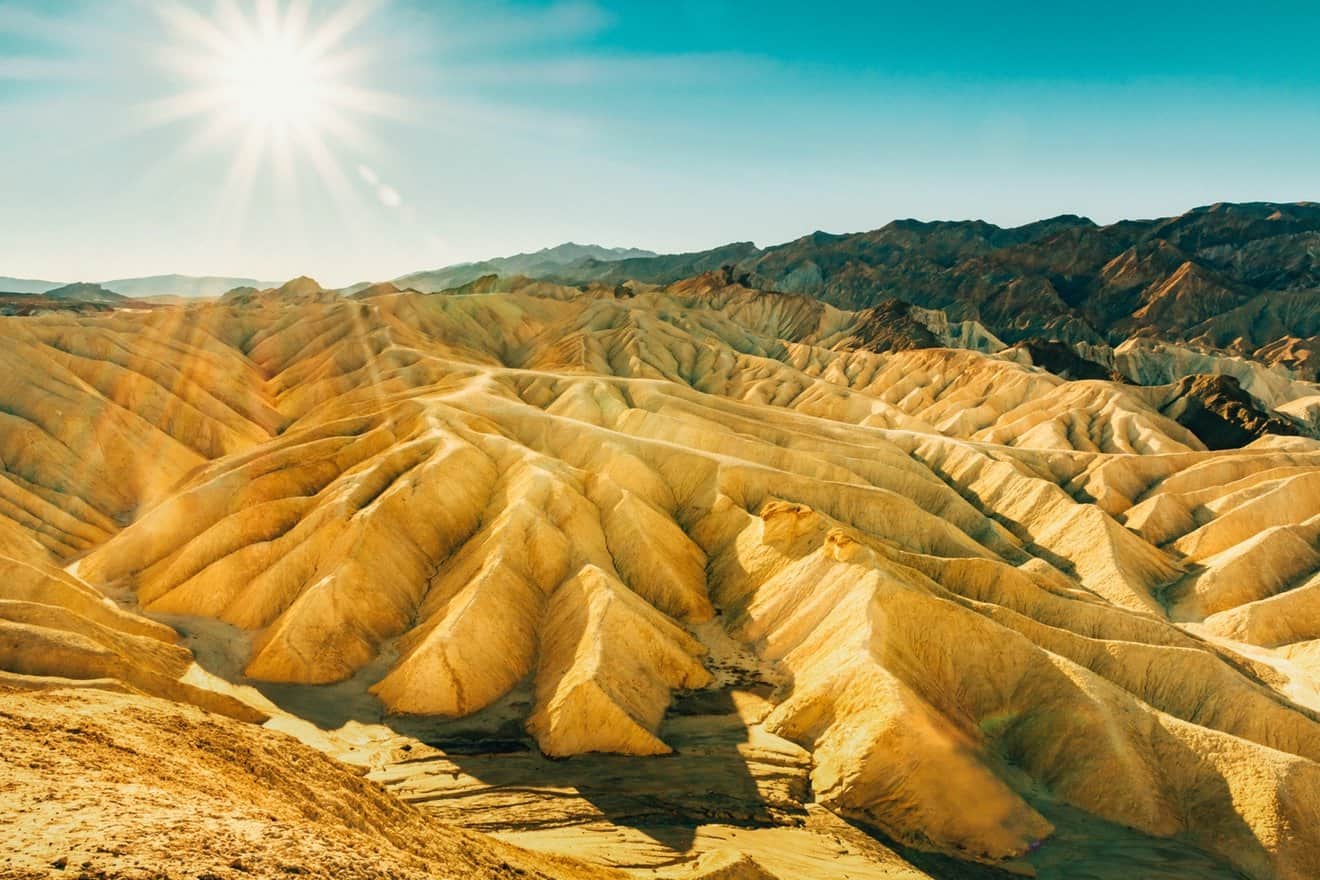
All The Beautiful Places You Must See in Death Valley
This site may contain affiliate links. We may receive a commission for purchases made through these links.
Warning : Due to a flood, there are currently access issues to the park. To stay updated on the situation's developments, we recommend monitoring the NPS updates .
The name itself can be disheartening. “D eath Valley ” doesn’t sound like a very good place for a vacation, yet every year many tourists who visit California decide to go to Death Valley , one of the most incredible and evocative American national parks .
This amazing park in California is one of the natural wonders found in the United States, with its arid and desert landscape that is so surreal that it appears out of this world, with its ancient lakes, now evaporated, which often reflect iridescent rainbows, with its sea of mountains, patterns, shapes and remarkable rock layers.
Death Valley is vast; it is the largest national park in the United States (excluding Alaska ) and for this reason it is not uncommon for some people to book Death Valley tours from Las Vegas or Los Angeles. Often, when you visit it, you have the impression of being on another planet or of looking at lunar landscape. But first let’s start with tips and information, because when you visit Death Valley you will need to take some precaution and prepare well.
Preparations: 4 Important Things To Remember When Visiting Death Valley
From the east (las vegas to death valley), from the west (yosemite to death valley), from the north, from the south (los angeles to death valley), entrance fee information, 1. badwater salt flats, 2. artist’s palette, 3. zabriskie point, 4. dante’s view, 5. the sand dunes of mesquite flat, 6. scotty’s castle, 7. rhyolite, near badwater basin, stovepipe wells area, ubehebe/scotty’s castle area, beatty area, death valley map attractions, where can i stay overnight when visiting death valley.
Most of Death Valley is accessible by car, but you should know that it is the hottest place in the United States; usually the temperature is around 113 degrees Fahrenheit and the highest recorded temperature, measured on July 10, 1913, is 133 degrees Fahrenheit. If you don’t believe me, look at the picture below. The temperature displayed on the dashboard of my car during the visit to Death Valley in August was 118 degrees F.
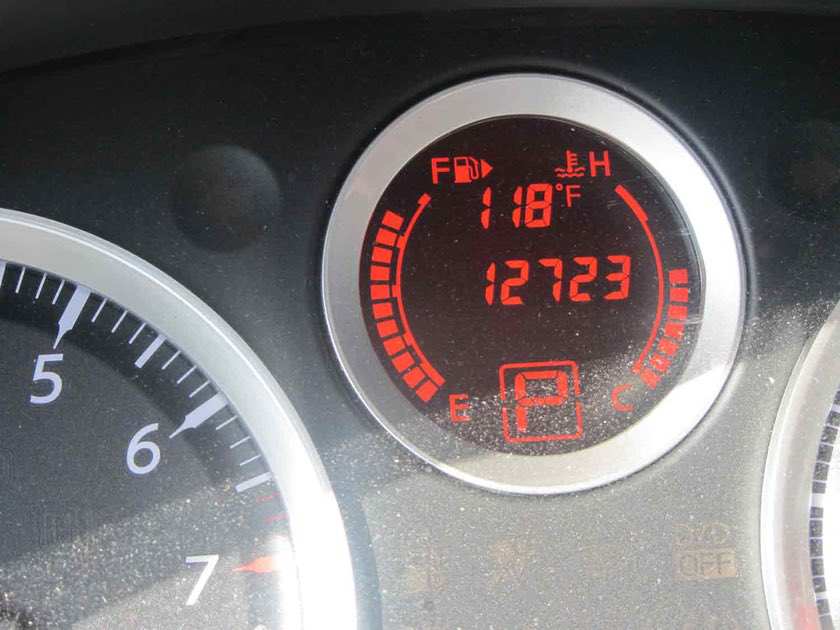
Therefore, to be ready for the climate of Death Valley , I highly recommended the following precautions:
- Does the air conditioning work well?
- Bring a good supply of water.
- It’s better fill the tank beforehand. There are only 2 gas stations in Furnace Creek and Stovepipe Wells.
- Check the fluids in the car. Excessive heat can mess up your car.
As you read in our article about when is the best time to go to Death Valley , a good season to visit Death Valley is spring , when temperatures are not so high and the wildflowers are in full bloom.
One last bit of advice about finding accommodations . If you want to spend the night inside the park you will have to book well in advance, but you can also find a place to stay (more easily) in the small towns outside the park, whic was already explained in a previous post about searching for hotels in Death Valley .
Where is Death Valley? How to get there?
Death Valley is located in California , on the border with Nevada, and Hwy 190 cuts right through the middle of it. The park, as mentioned above, is very large, so when speaking of distances we will use as a reference point the Visitor Center, which is the Furnace Creek Visitor Center , centrally located within Death Valley. This is the main information area of the whole park, located in a sort of small oasis in the desert, with accommodations, a food court, exhibits and a gas station, a highly prized commodity.
The distance from Las Vegas – the “nearest” big city – is about 140 miles, which will take just over 2 hours to travel. There are actually two ways to reach Death Valley from Las Vegas :
- The shortest road (124 miles): From Las Vegas you must deviate from the main artery (the I-15) to the NV-160 W, a road not far from Red Rock Canyon State Park . At Pahrump turn left towards Bell Vista Ave (follow the brown signs), that leads to Death Valley Junction . From this junction follow the Hwy 190 for 31 miles to Furnace Creek.
- The fastest road (143 miles: from Las Vegas you go north along the US-95 N to Amargosa Valley , another desolate place we mentioned in our article about the oddities of Southern Nevada . In Amargosa take the NV-373 S to Death Valley Junction, and from there follow the same directions provided above. In both cases you can consider including a stop at Dante’s View in the itinerary, which is reached by deviating from Hwy 190. Since it is basically on the way, those who do not want to miss this phenomenal viewpoint should take advantage of it, because when coming from Yosemite (Eastern Sierra ) it is less likely to be included in the itinerary it due to tiredness from traveling, logistics or lack of time. All the main attractions are in fact in other areas of Death Valley, to the west and to the north.
Another classic drive is from the west (from Yosemite Park ), in the months when the Tioga Road is open, or from Reno/ Lake Tahoe , even further north, throughout the year. In each of these cases, however, it is necessary to travel the long stretch on US-395 to Lone Pine . CA-136 E begins here, which soon flows into the aforementioned Hwy 190 and arrives at the park past Panamint Springs and the pseudo-western village of Stovepipe Wells. Entering the park from this side you will immediately pass the Mesquite Flats Dunes , which deserves to be your first stop.
Those coming from the north , for example, following this route from Tonopah , will access the park from Beatty in Nevada, a northern gateway often designed as an overnight stop for those visiting the park. Follow NV-374 S until the junction with Highway 190. Again, you may decide to take a short detour to the Rhyolite ghost town before continuing on to the actual Death Valley.
As you will see, there is also a more fascinating entrance the park, the Titus Canyon Road , but it is reserved to those who have a lot of time and above all an off-road vehicle.
Lastly, this section concerns those coming from the south (Los Angeles, or Barstow for those who have visited for example the Joshua Tree ) and specifically, those traveling from the south-west, who after going to Sequoia National Park want to reach Death Valley via Bakersfield . This last scenario occurs more often than you would expect. In fact, all those coming from San Francisco, who cannot access the Tioga Road for the seasonal closure in winter, are therefore forced to bypass the Sierra Nevada from the south to go towards Death Valley and Nevada. If you want to know more, read our article Los Angeles to Death Valley Itinerary .
- Coming from Los Angeles : the distance is 267 miles, which can be covered in 4.5 hours. As soon as you leave San Fernando (north of Los Angeles) and get on the I-5 N, take the CA-14 N and follow it all the way (it will become Panamint Road) until the junction with Hwy 190 at Panamint Springs. From there, turn right towards the Visitor Center.
- Coming from Barstow: Take I-15 north-east to Baker , on the edge of the Mojave National Preserve . From there drive on CA-127 N to the Death Valley Junction and then take Hwy 190 by following to the directions given earlier.
- For those coming from Bakersfield (Sequoia): Take CA-58 E to Exit 167 towards Bishop . This will take you to CA-14 N, so just follow the directions given above. Usually, since the journey from Sequoia is long, Ridgecrest is used as a halfway stop for overnight stay, also because Trona Pinnacles , a true gem, is found nearby.
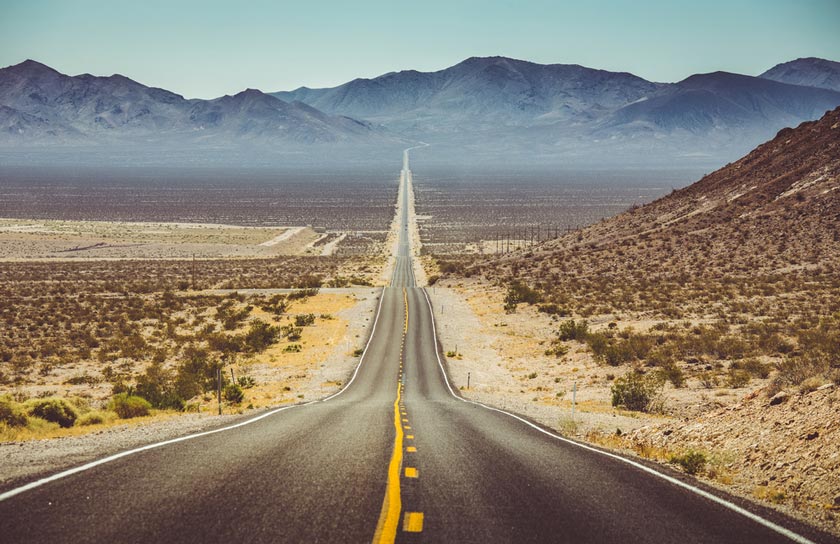
- Furnace Creek Visitor Center
- Scotty’s Castle Visitor Center (closed until further notice)
- Stovepipe Wells Ranger Station (the most convenient for those coming from the west)
- Lone Pine Interagency Visitor Center (as soon as you leave the Eastern Sierra and enter Inyo County)
- Furnace Creek Campground Kiosk
It is very likely that you won’t find the rangers in one of these spots. If this happens, there are the vending machines here:
- Stovepipe Wells Ranger Station
- Grapevine Ranger Station
- Zabriskie Point
- Hell’s Gate (Daylight Pass Road)
- Furnace Creek Campground (April 16 to October 14)
- Sunset Campground (when open)
- Texas Springs Campground (when open)
- Stovepipe Wells Campground (when open)
- Mesquite Springs Campground
Things To Do in Death Valley: 7 Beautiful Places You Must See
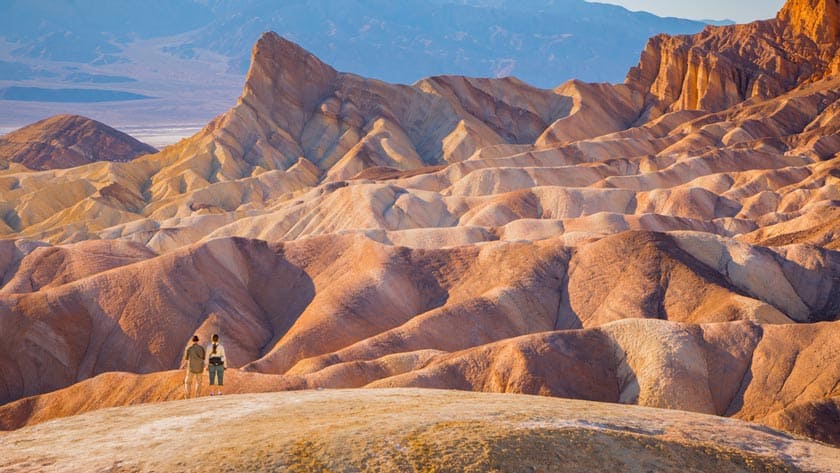
Below we would like to propose those that impressed us the most and that usually can be visited all (or almost all) in a whole day.
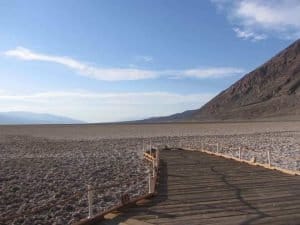
A depression 282 ft below sea level. How is that possible? In fact, you won’t believe your eyes, but as soon as you park your car you will see – behind the expanse of salt – high up in the mountains, a sign indicating sea level. This scorching depression in Death Valley Park is called Badwater Basin, and it’s nothing more than the large bed of the prehistoric lake called Manly Lake, now completely drained. This is the lowest point not only in Death Valley, but in all of North America.
At the end of the Badwater Road, you will find a landscape of surreal and otherworldly beauty. The Badwater Salt Flats , which resembles a lunar landscape, is a place where you will experience a unique atmosphere and a mysterious silence. The parking lot is very close to the observation point, but if you can stand the heat and don’t want to miss the chance to take an incredible photo, you can also go and explore the terrain. To find out more, read our in-depth guide on Badwater Basin .
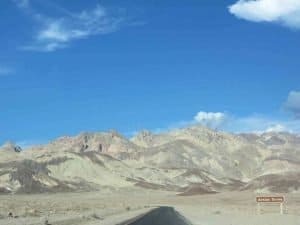
There are some mountains in Death Valley that are so distinctive that it seems that nature itself has begun to paint them, infusing its most extravagant colors on the various rock layers. The result is Artist’s Palette (or Painter’s Palette), a very unusual phenomenon, which has counterparts in the Painted Desert in Arizona and the Painted Hills of Oregon (to name a couple). This area was also used by George Lucas as the location for some scenes from the Star Wars saga .
To get there, drive along Artist Drive, a very strange scenic road that branches off from Badwater Road. The duration of the loop is about 25 minutes, and in the middle of the road there is an observation point of the “rock painting”. You can also get closer by going on the path that starts at the parking lot of the observation point, but we recommend you do this only when the weather is mild.
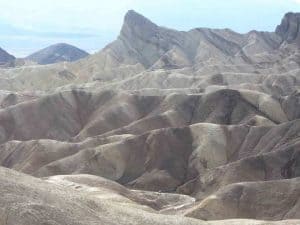
This place was the inspiration for the director Antonioni’s famous film of the same name. Park your car in the parking lot at the base of the hill, grab your bottle of water and take a short walk for a few minutes (trust me… you’ll need water for such a short distance!) to admire the beautiful striped mountains of Zabriskie Point , which soar more than 4900 ft above the bottom of the valley. Actually, as you will read later in the article, you can also venture into the maze of pale badlands , but under certain conditions. To learn more about how to get to the viewpoint read our article Zabriskie Point Death Valley.

Near Stovepipe Wells are almost 15 square miles of undulating sand dunes with constantly shifting shapes. They are the most famous among the 7 different areas dunes in the park. You will find there a view to look upon in peace and quiet, if you can resist the heat. As mentioned above, they are located in the vicinity of Stovepipe Wells, one of the first “oases” you will find as you travel from the west along Hwy 190. During the best times of year for hiking you can also reach the top of the highest dune (over 1.86 miles roundtrip), but you have to take into account that of course there is no marked trail on the sand.
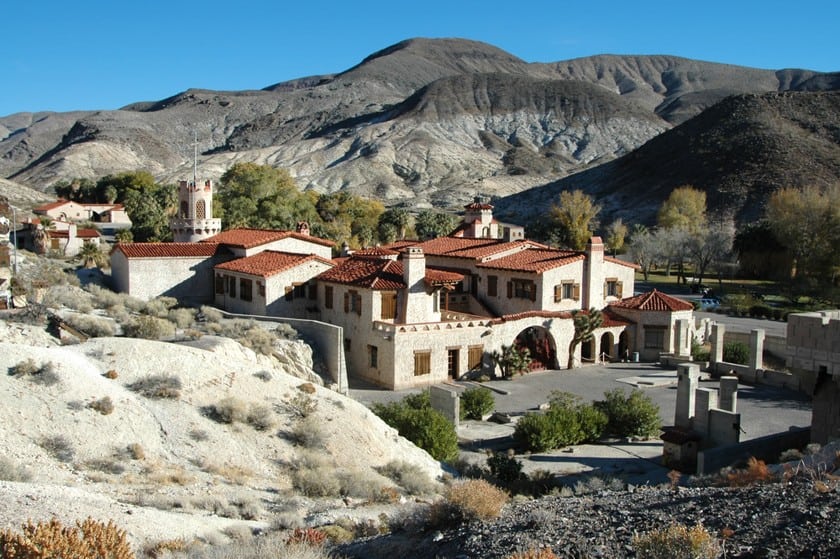
— Warning –: Scotty’s Castle is closed until further notice for maintenance. Violent thunderstorms have severely damaged both the road and the castle’s architectural complex. You can still access Racetrack Road, Ubehebe Crater, and Mesquite Spring Campground.
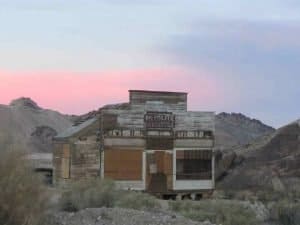
If you are staying near Beatty overnight stay or if you have chosen this entrance to enter the park, you can make a short exploratory stop in the ghost town called Rhyolite , an abandoned mining town. You can walk around this small town which has some buildings that are both interesting and spooky. The feel of this town is not the same as that in other ghost towns in the area (think Bodie ) but there are also other strange things to see in the immediate surroundings, such as a house completely made of glass bottles and the Goldwell Open Air Museum, in which, among all the artwork displayed, the one that stands out is an art installation by Belgian artist Albert Szukalski: The Last Supper , a ghostly version of the work of Leonardo da Vinci.
If there’s a little time left…
Death Valley is full of hidden treasures, and it would take several days to see them all! Our selection is aimed to optimize your time , but I also want to point out 8 other attractions / routes that you could include in your tour if you have a couple of days (or more) and especially if you still have energy after being under the Death Valley sun. Remember that the ideal time of year to go on trails that take even 30 minutes to walk is from November to March .

- Devil’s Golf Course: An immense, haunting expanse of petrified salt that gives the impression of being on another planet , especially at sunset. The salt crystals that make up the lumpy terrain of Devil’s Golf Course have peculiar shapes. You can try to explore, but paying attention to the less stable holes and rocks (as the name of the place suggests). You can reach it by taking a turn off of Badwater Road, via a short stretch of dirt road in good condition. If you don’t have a 4×4, proceed with caution.
- Natural Bridge: Death Valley is not as famous for arches and rock bridges as Arches National Park or Bryce , but going to Natural Bridge is a good idea for those who have some time and want to see a beautiful rock formation that is unique to the Badwater desert environment. Yes, the road that takes you to the start of the trail is off of Badwater Road, about 14 miles from the start of the road. There is a short stretch of gravel road that is also generally accessible for sedans. From the parking lot, the trail is about 2 miles round trip to reach this narrow rock bridge between the narrow walls of a canyon. Obviously, given the length of the trail, you must be prepared for the heat and in any case it is better to go during the less muggy periods of the year.
- Golden Canyon / Badlands Loop: It’s not one of the best known hikes in the park, because there’s so much to do and the stifling heat of Death Valley makes you want to give up after a short time (this happened to us in the hot month of September). But with if you have good weather, the time and energy, the Golden Canyon Trail has the advantage of taking you right into the badlands of Zabriskie Point , the white and golden ravines that can be seen from the overlook mentioned earlier. The trailhead is 2 miles from the start of the Badwater Road, and is well marked on the side of the road. There are several sections of the trail, which are doable for those with less time or less experience, such as the Badlands Loop (2.7 miles in all, but you can turn back after half a mile), which actually starts at the opposite end of the trail, the Zabriskie Point parking lot . This loop allows you to get right into the heart of the white hills without having to walk the entire canyon (7.8 miles) from Badwater Road.
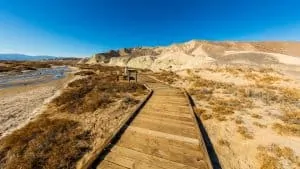
- Mosaic Canyon : This is another recommended hike especially in winter or in cooler seasons (see here ), as you have to venture along a path inside a canyon. If you can stand the heat, you can enjoy seeing the wonderful walls of a thousand colors, smoothed by the work of natural elements. The geology here may remind you of the sparkling rocks of Artist’s Palette, only in this case you can walk through them and touch them! The trail is located at Stovepipe Wells. Before reaching the village (coming from the west) you will see a dirt road on the right. Follow it and you will reach the parking lot next to the mouth of the canyon.
- Salt Creek Interpretive Trail: This is an easy, short trail on a footbridge along the salty river called the Salt Creek . The salt water is only present between November and May, and in springtime you can also see the unusual desert fish species (pupfish).

- Ubehebe Crater: Just like Devil’s Golf Course, Ubehebe Crater is overlooked by visitors to Death Valley, who prefer to spend their time visiting the most famous places. The reason perhaps is the fact the the crater is located on the outskirts of Death Valley, in the northwest portion of the park, not far from Scotty’s Castle (closed until further notice), more than an hour from Furnace Creek. The parking area at the end of the Ubehebe Crater Road is located just above the volcanic crater and you can see the crater from various perspectives thanks to the trails on site.
- Racetrack Playa : In this remote area of Death Valley there is an incredible phenomenon. The rocks, although it is hard to perceive, move by themselves ! To get to the Racetrack Playa you will need a 4×4, since the road is very bumpy. Also don’t expect to see a rock rolling, because the rocks move very slow… but you will notice the trace that it has left in time. If you want to know more read this particular West Coast route , where we have provided more details.
Titus Canyon Road is the experience that all off-road enthusiasts would like to have, so much so that over time it has become quite popular. If you don’t intend to rent a 4×4, skip this area, because this long route is a bumpy canyon road that goes through bottlenecks, steep unprotected declines, gorges and mountain passes, ruins of ancient towns (Leadfield Ghost Town) and unimaginable desert expanses with a variety of local fauna and flora. The best thing about this long route is that it is an alternative way to get from Beatty/Rhyolite through the heart of the valley, i.e. over the rugged Grapevine Mountains. Titus Canyon Road takes a right turn off the NV-374, 6.2 miles south of Beatty, which takes about 2-3 hours to cover all 26 miles of the road.
Below is a video to show you what awaits you.
Here is a map of the main attractions of Death Valley covered in this article:
The solutions for overnight stay are different and vary depending on the direction from which you arrive. We have dedicated an entire article to this topic. Click on the link below to read our tips on how to find accommodations when you visit Death Valley.
Tips on Where to Stay in Death Valley
Want to see more photos of Death Valley? Look at the complete album of pictures on our Facebook page!
What about you? Have you been to Death Valley? What would you add to that list?
Warning: Operating hours can change and closures for extraordinary events can occur, so we strongly suggest to check the venues official websites.

lorenzo puliti
I am fascinated by the wonders of the world I never tire of going in search of them.
Related posts
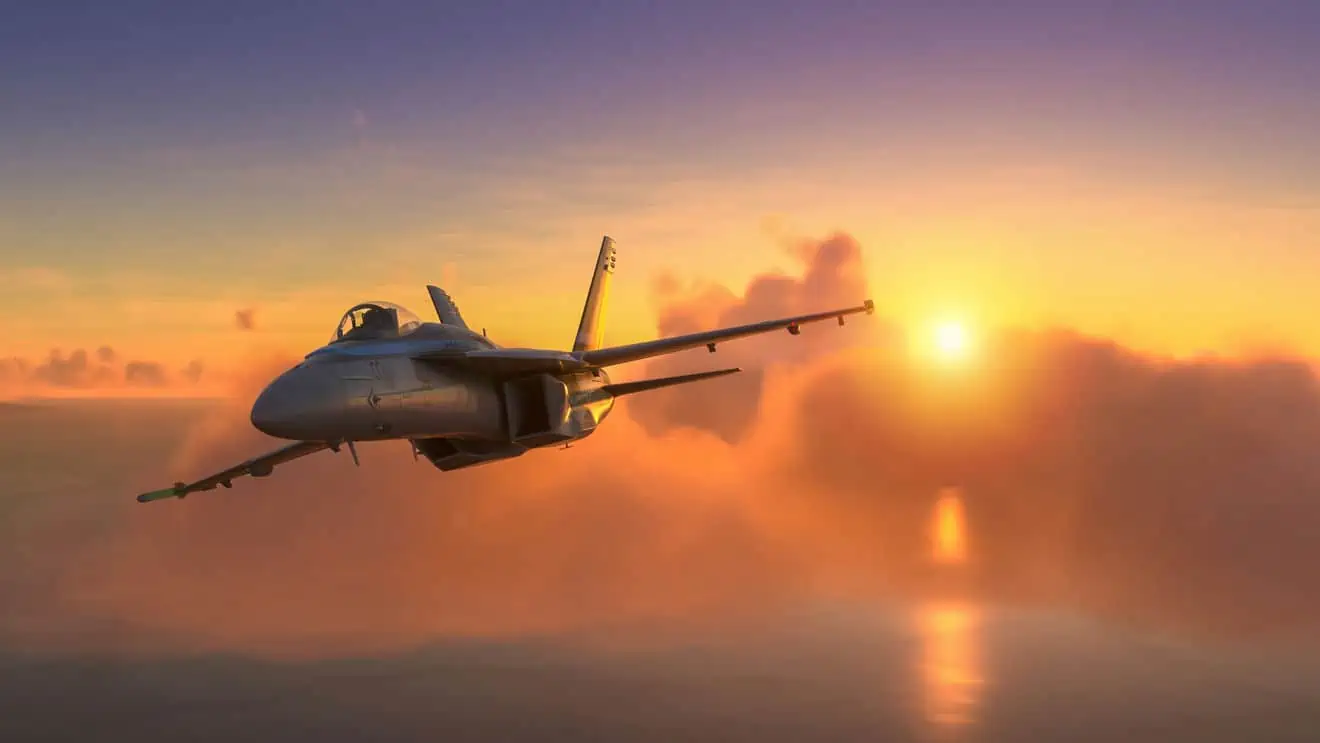
Discover the Main Filming Locations of Top Gun and Maverick!
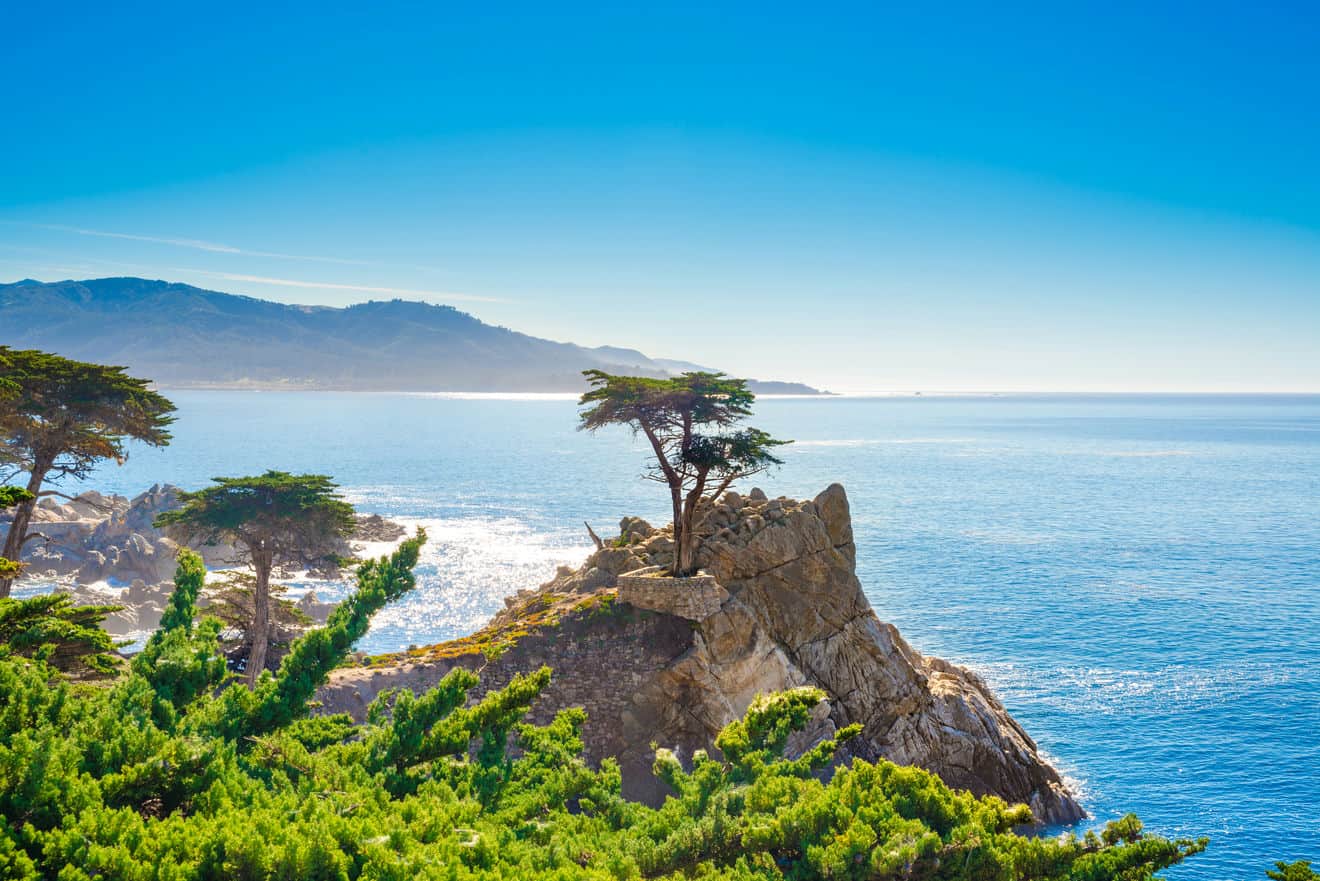
17-Mile Drive: Pebble Beach’s scenic road in California
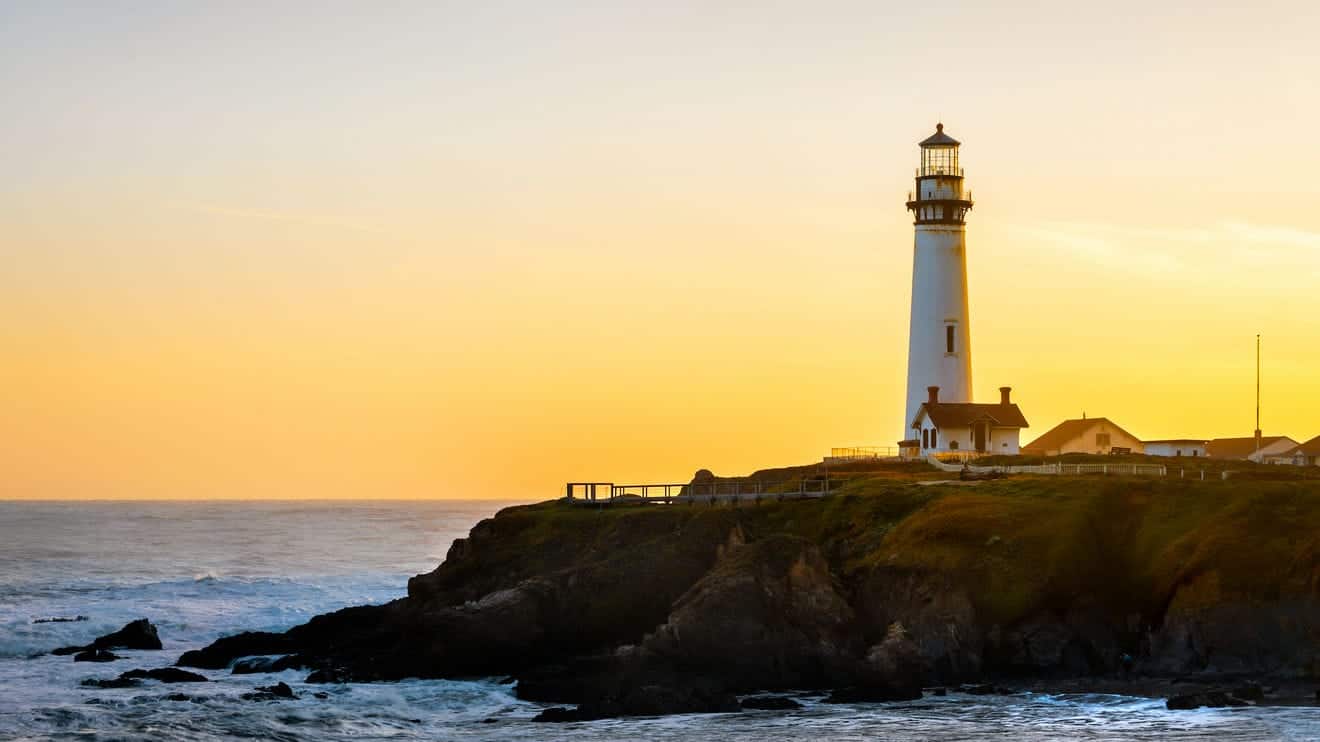
Pigeon Point Light Station State Park, a fascinating lighthouse on the California Coast
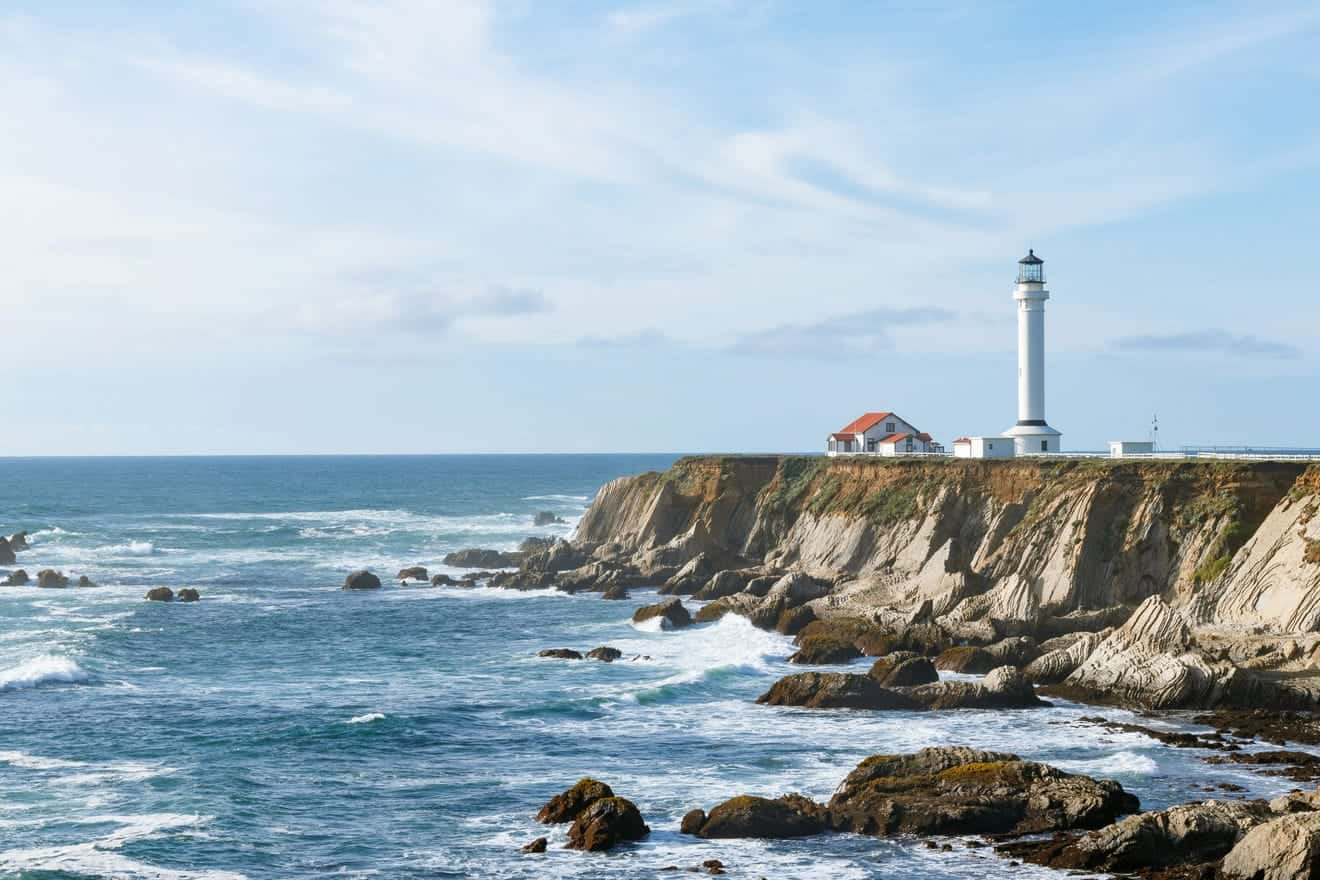
How to Plan a Visit to the Historic Point Arena Lighthouse in Mendocino, California
Leave a comment cancel reply.
This site uses Akismet to reduce spam. Learn how your comment data is processed .

National Parks Traveler
Climate change and the parks
National Park Travel
Help power the National Parks Traveler’s coverage of national parks and protected areas.
You are here
Salt tram tower toppled in death valley national park.
Saline Valley Salt Tram tower #1 on March 5, 2024/NPS
A historic tram tower built more than a century ago to haul salt out of Death Valley was recently toppled in Death Valley National Park , possibly by a motorist who attached a winch to the tower to pull a vehicle out of the muck, according to park staff.
The 113-year-old tower was found upright in early March, but then discovered uprooted on April 27.
“I have hiked along sections of this tramway and am amazed by the tenacity it took to build,” said Superintendent Mike Reynolds. “I hope the person responsible for this damage will contact us so we can discuss restitution.”
The Saline Valley Salt Company built the 13-mile aerial tram to transport salt from Saline Valley to Owens Valley in 1911. The tramway climbed more than 7,000 vertical feet at steep vertical grades up to 40 degrees. The Saline Valley Salt Tram is listed on the National Register of Historic Places. It is considered nationally significant because of its age, length, steepness, preservation, and scenic setting.
Only the first four towers are within Death Valley National Park. Most of the tramway crosses lands managed by the Bureau of Land Management.
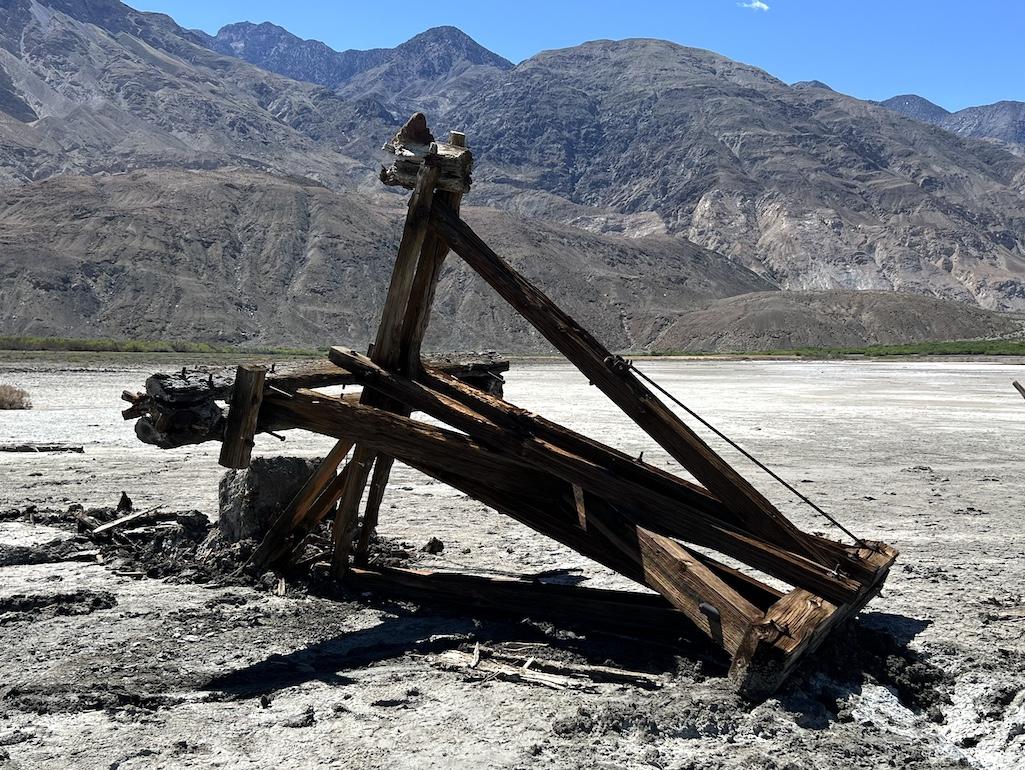
Salt Tram Tower #1 on April 27, 2024/NPS
Tram tower #1 is the tower closest to Saline Valley lakebed. Nearby tracks show that a vehicle drove a short distance off the legal roadway and got stuck in mud, a park release said Monday. Park rangers believe that someone used the nearby tower as an anchor to pull their vehicle out of the mud. The tower toppled over, pulling its concrete footings out of the ground.
The Park Service already had a salt tram stabilization project planned before this damage happened, funded by the Inflation Reduction Act. The project manager has not determined if that funding can be used to re-anchor tower #1.
Park rangers ask that anyone with information on this incident contact the NPS-wide tip line at 888-653-0009 or go.nps.gov/SubmitATip .
- Death Valley National Park
- Parks in the News
- Add new comment
"...a salt tram stabilization project...funded by the Inflation Reduction Act."
Less than .05% of Death Valley visitors know these exist. Of those that know about them less than 10% can get to them, or want to drive that far, due to the long un-maintained dirt road that you need to take to get there. Death Valley Management at it's finest.
What would you rather have them do with the money? Upgrade high visitation areas? Improve campgrounds? Hire sufficient staff?
Add comment
This question is for testing whether or not you are a human visitor and to prevent automated spam submissions.
Support Journalism about National Parks!
National parks traveler is a 501(c)(3) nonprofit..
Donate Now!
The Essential RVing Guide

The National Parks RVing Guide , aka the Essential RVing Guide To The National Parks , is the definitive guide for RVers seeking information on campgrounds in the National Park System where they can park their rigs. It's available for free for both iPhones and Android models.
This app is packed with RVing specific details on more than 250 campgrounds in more than 70 parks. You'll also find stories about RVing in the parks, some tips if you've just recently turned into an RVer, and some planning suggestions. A bonus that wasn't in the previous eBook or PDF versions of this guide are feeds of Traveler content: you'll find our latest stories as well as our most recent podcasts just a click away. So whether you have an iPhone or an Android , download this app and start exploring the campgrounds in the National Park System where you can park your rig.
- Skip to global NPS navigation
- Skip to this park navigation
- Skip to the main content
- Skip to this park information section
- Skip to the footer section

Exiting nps.gov
Alerts in effect, sightseeing- park highlights.
Last updated: June 27, 2021
Park footer
Contact info, mailing address:.
P.O. Box 579 Death Valley, CA 92328
760 786-3200
Stay Connected
- Today's news
- Reviews and deals
- Climate change
- 2024 election
- Fall allergies
- Health news
- Mental health
- Sexual health
- Family health
- So mini ways
- Unapologetically
- Buying guides
Entertainment
- How to Watch
- My watchlist
- Stock market
- Biden economy
- Personal finance
- Stocks: most active
- Stocks: gainers
- Stocks: losers
- Trending tickers
- World indices
- US Treasury bonds
- Top mutual funds
- Highest open interest
- Highest implied volatility
- Currency converter
- Basic materials
- Communication services
- Consumer cyclical
- Consumer defensive
- Financial services
- Industrials
- Real estate
- Mutual funds
- Credit cards
- Balance transfer cards
- Cash back cards
- Rewards cards
- Travel cards
- Online checking
- High-yield savings
- Money market
- Home equity loan
- Personal loans
- Student loans
- Options pit
- Fantasy football
- Pro Pick 'Em
- College Pick 'Em
- Fantasy baseball
- Fantasy hockey
- Fantasy basketball
- Download the app
- Daily fantasy
- Scores and schedules
- GameChannel
- World Baseball Classic
- Premier League
- CONCACAF League
- Champions League
- Motorsports
- Horse racing
- Newsletters
New on Yahoo
- Privacy Dashboard
Historic Death Valley tower topples over as driver uses it to free vehicle, rangers say
A historic Death Valley tower toppled as a driver used it to free their stuck vehicle, rangers say.
Sometime between April 1 and April 23, the tower, part of the Saline Valley Salt Tram , “was pulled over while a person used a winch to extract their vehicle out of deep mud,” the National Park Service said in a May 13 news release.
“I hope the person responsible for this damage will contact us so we can discuss restitution,” Superintendent Mike Reynolds said in the release.
Tracks showed that a vehicle drove off the legal roadway shortly before getting stuck, rangers said.
“Park rangers believe that someone used the nearby tower as an anchor to pull their vehicle out of the mud,” rangers said.
In doing so, rangers said the tower toppled, “pulling its concrete footings out of the ground.”
“I have hiked along sections of this tramway, and am amazed by the tenacity it took to build,” Reynolds said.
The 13-mile long aerial tram was constructed in 1911 “to transport salt from Saline Valley to Owens Valley,” rangers said.
“The tramway climbed over 7,000 vertical feet at steep vertical grades up to 40 degrees,” rangers said.
The tram’s construction required “1 million board feet of lumber and 600 tons of iron,” according to NPS.
“Considered nationally significant because of its age, length, steepness, preservation, and scenic setting,” the tram is listed among the National Register of Historic Places, according to rangers.
Only four of the tram’s towers sit within the national park, rangers said, while the majority of the tramway sits on Bureau of Land Management territory.
The damaged tower is the closest of the four to the Saline Valley lakebed, rangers said.
Prior to this incident, a salt tram stabilization project was planned using funding from the Biden administration’s Inflation Reduction Act, rangers said.
However, rangers said they are unsure if the funds can be used to re-anchor the tower.
Rangers asked for anyone with information to contact them at 888-653-0009 or go.nps.gov/SubmitATip.
Saline Valley is about 110 miles east of Fresno.
Driver gets stuck in mud on closed Death Valley road, photo shows. Rangers warn others
Iridescent creature’s population dropped to 35 in Death Valley. Now there’s good news
Stunning satellite images show just how big Death Valley’s lake really was. See them
Recommended Stories
Why biden's tariffs on chinese evs will have little immediate impact on the us auto market.
President Biden quadrupled tariffs on Chinese-made EVs. The catch? Hardly any Americans are buying these cars anyway.
Used car prices held flat in April 2024 while payments increased
CarGurus found that interest rates helped drive the average payment up in April 2024 while overall pricing remained steady.
Warm weather's back — and with it, reminders to prevent hot car deaths
The National Highway Traffic Safety Administration says that on average, 37 children in cars die each year of heatstroke after being left in vehicles or trapped in them — a child dies this way somewhere in America about every 10 days.
NASCAR needs to think bigger than a $1 million prize for the All-Star Race and in-season tournament
The All-Star Race winner's bonus has been the same since 2003. But $1 million in 2003 is $1.7 million in 2024 after inflation.
Rory McIlroy files for divorce from wife Erica after seven years of marriage
On the eve of the PGA Championship, Rory McIlroy has filed for divorce from his wife, Erica.
Why Biden's quadrupled Chinese EV tariffs will have little immediate impact
The big headline from President Biden’s new tariffs on Chinese goods announced Tuesday was the massive hit to electric vehicles made in China. Of which, there aren't many.
PGA Championship: Tee times for Rounds 1 and 2
Tiger Woods, Rory McIlroy, Scottie Scheffler now know when they'll be playing on Thursday and Friday
'The most transformative product I have ever used': Salma Hayek's go-to ingredient for ageless skin is in this $14 cream
The bark of the 'Mexican skin tree' is known for its regenerative properties.
Threat actor scraped Dell support tickets, including customer phone numbers
The person who claimed to have stolen the physical addresses of 49 million Dell customers appears to have taken more data from a different Dell portal, TechCrunch has learned. The newly compromised data includes names, phone numbers and email addresses of Dell customers. This personal data is contained in customer “service reports,” which also include information on replacement hardware and parts, comments from on-site engineers, dispatch numbers, and in some cases diagnostic logs uploaded from the customer's computer.
Ask Google Photos to help make sense of your gallery
Google unveils Ask Photos to help you more easily get answers out of your camera roll.
Stock market today: Meme rally roars as stocks stay muted in inflation countdown
Meme stocks soared again as US equities more broadly stayed muted in the countdown to fresh inflation data and a Jerome Powell speech.
Inflation expected to tick down in April as Fed officials weigh rate cuts
April's CPI report is one of the most important data points the Federal Reserve will consider in its next interest rate decision.
2025 Genesis GV80 First Drive: It's what's inside that counts
Light updates to the Genesis GV80 keep the luxury SUV a class leader in design and luxury. It's also a good deal versus the competition.
A Tomb Raider series from Phoebe Waller-Bridge is on the way to Prime Video
Amazon has announced that a Tomb Raider series and Madden NFL documentary are coming to Prime Video.
Lucky Mariners fan catches foul balls on consecutive pitches
Some of us have never come close to catching a foul ball at a game. This fan got two in a row.
President Biden unveils a historic wave of tariffs on 'strategic' Chinese imports
President Joe Biden ramps up pressure on China with new targeted tariffs on a range of goods as his rival Donald Trump weighs even more draconian measures should the Republican win in November.
Airlines sue over 'hidden junk fees' rule, Michael Cohen claims Trump approved hush money payments and the WNBA season begins
Get caught up on this morning’s news: Airlines sue over new “junk fees” rule, the WNBA season begins and more in today’s edition of The Yodel newsletter
David Sacks reveals Glue, the AI company he’s been teasing on his All In podcast
If you use Slack at work, you've likely noticed that the number of channels you're invited to proliferates incessantly. David Sacks, one-quarter of the popular All In podcast and a renowned serial entrepreneur whose past companies include Yammer -- an employee chat startup that sold to Microsoft for $1.2 billion in 2012 -- says he can solve this problem. Toward that end, he teamed up with Evan Owen, formerly the VP of engineering at a collaboration app, Zinc, that ServiceMax acquired in 2019.
Paris-based VC firm Blisce launches climate tech fund with a target of $160M
Blisce has become the latest VC firm to launch a fund dedicated to climate tech, for which it plans to raise as much as €150 million (about $162 million). The firm is hiring investor Pierre-Edouard Berion to lead the fund, and Lucie Basch, the co-founder of Too Good To Go, is going to support the fund as a venture partner. If you aren’t familiar with Blisce, the VC firm is based in Paris, has an office in New York, and is better known as the investment vehicle of Alexandre Mars (pictured above).
12 rookie fantasy ranking hot takes heat checked by Matt Harmon
We put a bow on our draft season coverage on the pod with the one and only Dalton Del Don. It's been a minute since we've had our beloved 'Stat Nerd' co-host on the show and boy does he deliver in his glorious return. Del Don shares 12 rookie fantasy ranking hot takes that get heat checked by Matt Harmon. Some takes are thought provoking while others have Harmon's head spinning
- Death Valley National Park Tourism
- Death Valley National Park Hotels
- Flights to Death Valley National Park
- Death Valley National Park Restaurants
- Things to Do in Death Valley National Park
- Death Valley National Park Travel Forum
- Death Valley National Park Photos
- Death Valley National Park Map
- All Death Valley National Park Hotels
- Death Valley National Park Hotel Deals
- Death Valley National Park
- Things to Do
- Restaurants
- Vacation Rentals
- Travel Stories
- Rental Cars
- Add a Place
- Travel Forum
- Travelers' Choice
- Help Center
3 day trip - Death Valley National Park Forum
- United States
- California (CA)
- Inyo County
- Death Valley National Park
- United States Forums
- Europe Forums
- Canada Forums
- Asia Forums
- Central America Forums
- Africa Forums
- Caribbean Forums
- Mexico Forums
- South Pacific Forums
- South America Forums
- Middle East Forums
- Honeymoons and Romance
- Business Travel
- Train Travel
- Traveling With Disabilities
- Tripadvisor Support
- Solo Travel
- Bargain Travel
- Timeshares / Vacation Rentals
- California forums
- Death Valley National Park forum

This was my fourth trip to Death Valley over 40 years, last time was 2015. The Ranch area has really improved, food was much better although still national park food. We stayed at the Inn which was a splurge but had a large room, good stargazing deck and a great pool. Ate some meals in the Dining Room and Lounge and the rest at the RAnch. We used to Guidealong App which was very useful and I highly recommend it for touring the Valley. There was still some water at Devil's Golf Course. We had great weather and terrific views at Dante's View. Being older now we only did one hike in Mosaic Canyon. We enjoyed the sand dunes and found some interesting animal tracks there. We were out and about early in the day and had few crowds. We spent some time in the afternoon at the pool. Very peaceful.
We're glad you had such a good time and were able to relax without crowds!
- Death Valley Updates - April 23, 2024 today
- 3 day trip May 09, 2024
- Driving to Reno from Vegas and considering going through Dea Apr 27, 2024
- Visiting in 90 degree weather Apr 22, 2024
- Early May to hot to visit Death Valley ? Apr 21, 2024
- Stargazing trips in Death Valley - No driving Apr 20, 2024
- 3 Days in November 2024 - Your thoughts? Apr 18, 2024
- Here's another summer tourist from abroad Apr 18, 2024
- December Trip Question Apr 15, 2024
- Stovepipe Wells Village Hotel Apr 13, 2024
- LA and DVNL in May this year... Apr 10, 2024
- *least* winding route from Northern CA to DV? Apr 09, 2024
- Vacation rental near DV NP Apr 07, 2024
- Last Minute First Time Camper Apr 07, 2024
- Driving Las Vegas to Yosemite - Where to stop 17 replies
- best route from los angeles 3 replies
- Yosemite to Death Valley 10 replies
- How many days to stay in Death Valley? 6 replies
- Driving through Death Valley in August -advice please! 9 replies
- april weather in DV 4 replies
- 3 day itinerary 12 replies
- From Las Vegas to LA via Death Valley 8 replies
- Weather in December 6 replies
- Drive time to South Grand Canyon 3 replies
Death Valley National Park Hotels and Places to Stay
- ROUTES to Death Valley? How far to ____ ? What maps to use?
- LODGING: Where should we stay to enjoy Death Valley? (Jan. 2024 update)
- CAMPING - where and when can we camp in Death Valley?
- LAS VEGAS one-day turnaround trips - what can we see?
- BACKCOUNTRY road conditions - can I get to ...?
- WILDFLOWERS - will this be a superbloom year?
- WILDLIFE - do they bite? Is Death Valley wildlife dangerous?
- SUMMER - is it safe to go to Death Valley?
- WINTER - does it exist in Death Valley, or does summer last forever?
- SCOTTY'S CASTLE - what's happening?
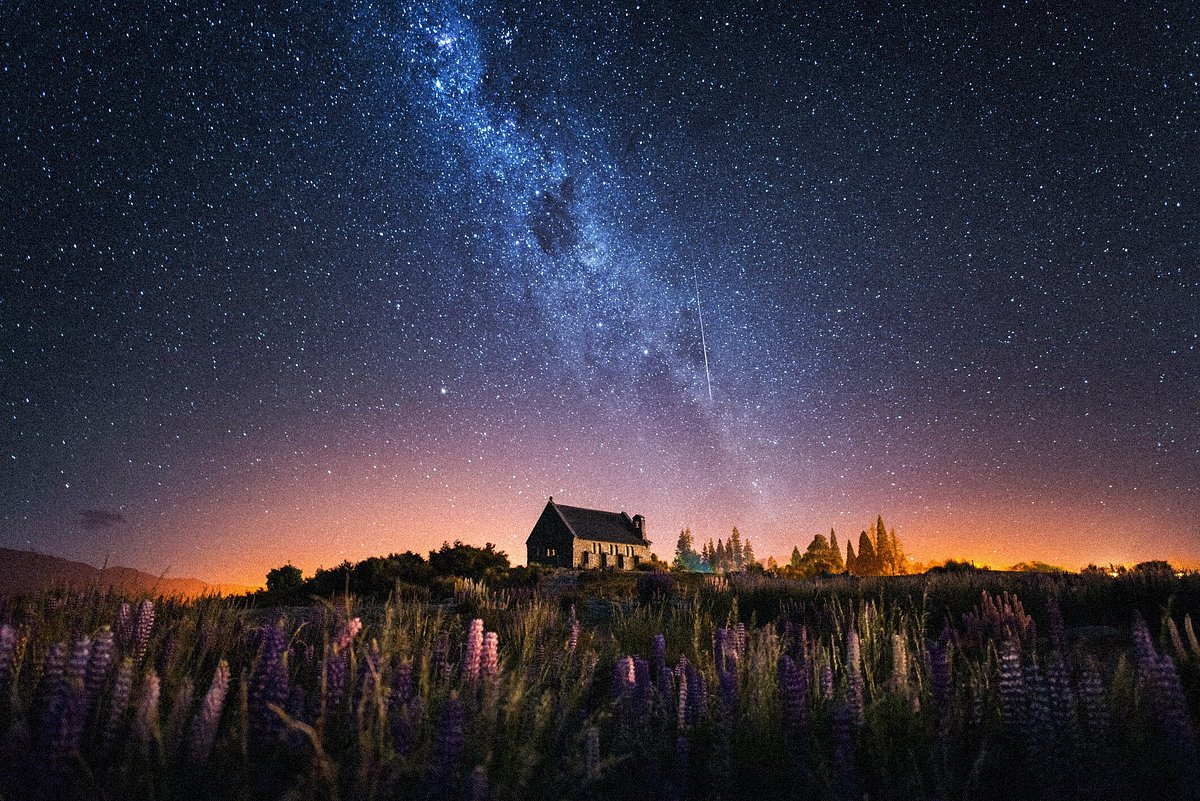
- Community News
- Area Births
- In the Courts
- Marriage Licenses
- Real Estate Transfers
- West Virginia News
- National News
- International News
- Local Sports
- Local Sports Columns
- West Virginia Sports
- Ohio Sports
- National Sports
- News and Sentinel Races
- Local columns
- Letters to the editor
- Anniversaries
- Engagements
- Coronavirus
- Classifieds
- Garage Sales
- Statement of Values
- Terms of Service
- Submit News
- Browse notices
- Place a notice

- Today's Paper
Subscribe Today
Mid-ohio valley model railroad club to unveil new attractions at open house.

Harold Shive (Photo Provided)
PARKERSBURG — The Mid-Ohio Valley Model Railroad Club will unveil several new attractions and honor one of its deceased members with an open house on Saturday.
The late Harold Shive will be remembered with an open house in his name from 10 a.m. to 4 p.m. at the club facility in the rear basement of NOE Office Equipment at 610 Green St. in downtown Parkersburg.
Meanwhile, the club to which he was so important, will unveil lots of fresh scenery, a brand new layout, a photo station and the return of an old-time scale of trains.
Shive, a valued member of the club for many years and a model train collector and operator, was fond of Thomas The Tank Engine and Friends. The club will remember this children’s favorite by running Thomas trains in several scales at the open house.
Prior to his passing at age 90 in 2019, Shive was a staff sergeant in the United States Air Force, president of the National Amateur Press Association and owner of Harold’s Quick Print and Olde Harold’s Print Shoppe in Pennsboro. Shive served MOVMRC as its librarian and edited and distributed the organization’s newsletter. The New Jersey native was also a key member of the N and S scale groups and was a fixture at all club events, where he often operated model trains.
Since its last open house in February, MOVMRC has undergone a number of physical improvements, including new scenery and control systems on the large HO scale layout, completion of the framing and benchwork on a brand-new O scale layout, upgraded wiring on the G scale layout, several new vignettes on the N scale layout and new skirting around most of the club layouts.
“The open house will be a good representation of what we are building and the direction in which we are heading,” said club President Jonathan Insley, who doubles as O scale superintendent. “We will have a full-size template down on the new O scale layout so our guests can see exactly where the tracks, buildings and accessories will be located.”
Insley, owner of Insley Plumbing in Marietta, and fellow club member Jim Mysakowec took a recent road trip to upstate New York to acquire a gigantic scale model of a power plant. This detailed item will be on display at the open house and is certain to become a featured attraction of the new layout.
In addition to HO, O and G scales, model trains will be running in N scale on two highly-detailed layouts, both of which feature vignettes representing places, and events, of historic significance in the Parkersburg area. What’s more, Standard Gauge tinplate trains will be in operation at MOVMRC for the first time in several years.
Another new feature of the club, which will be unveiled at the Shive Memorial Open House, is a selfie station, with appropriate props, in the train layout room. Guests will be able to use this area, free of charge, for selfies and to create personal mementos of their visit.
Admission to the open house is free and a drawing will be conducted for a Lionel O scale Thomas the Tank train set. Free parking will be available in the NOE Office Equipment lot.
Guests who may be interested in promoting a business or organization, through the club, will be afforded the opportunity to purchase advertising space on billboards at several high-visibility locations on the HO layout.
In addition to model trains and railroad photos and historical artifacts, guests may be able to see real trains in action, as the Belpre Industrial Parkersburg Railroad yard tracks are located just outside the club entrance. The NOE parking lot is an ideal location from which to watch trains and take photos.
Following the Shive Memorial Open House, MOVMRC’s next events are an open house during the annual Parkersburg Homecoming Festival in August and the club’s annual Fall Train Show on October 26 on the WVUP campus.
Today's breaking news and more in your inbox
- Daily Newsletter
- Breaking News

U.S. special operations leaders are having to do more with less and learning from Ukraine

Israel moves deeper into Rafah, fights Hamas militants regrouping in northern Gaza

West Virginia voters to pick from GOP candidates who still dispute 2020 outcome

Art in the Alley encourages creativity in Marietta

Suspect being sought in shooting death of Ohio police officer

U.S. aims to stay ahead of China in using AI to fly fighter jets
Starting at $2.99/week..
Death Valley historic salt tram tower damaged

Why will high-speed train from Vegas go to Rancho Cucamonga, CA instead of Los Angeles?

Meeting on planned LDS temple near Lone Mountain

Where is the next hot spot in Las Vegas?

Las Vegas ordinance would restrict balloon releases

New round of talks after 48-hour Culinary Union strike in Las Vegas

Parents outraged by massive event featuring amateur ‘Bluey,’ restaurant apologizes
Ulster County announces workforce development hub plan for former IBM campus

KINGSTON - Ulster County Executive Jen Metzger and other government and educational leaders announced the signing of two leases Monday that will turn the former IBM campus into a workforce development hub.
Metzger and Ulster County Economic Development Agency Chair Gregory Simpson annnounced the signing of a master lease for 40,000 square feet of space that will create the Sustainable Ulster Workforce Development Center.
The center, a collaboration of the county, SUNY New Paltz, SUNY Ulster, Ulster BOCES and community-based partners, will house the county's departments of Employment and Training, Tourism and Economic Development, with programming and instructional space for the two colleges.
Now legal: Ulster County's first cannabis dispensary opens in New Paltz
Meanwhile, Ulster BOCES District Superintendent Jonas Schenker announced a lease for 105,000 square feet of space for a new career and technical center in the same building complex that will serve approximately 1,200 students.
"This project is truly transformational for Ulster County, involving a unique collaboration of government, educational and community-based partners," Metzger said. "Our shared vision is to create a vibrant hub of learning and professional development and a direct pathway into jobs through partnerships with employers."
"Ulster BOCES has access to the largest potential labor market pool in the area - the nearly 600 seniors we graduate each year looking to enter the workforce and pursue post-secondary experiences, as well as indirect access to the graduating classes of every public high school in the county," Schenker said.
The former IBM site, known as iPark 87, has seen several previous failed attempts at redevelopment since IBM moved out in 1994.
"After years of being underutilized, the facility is poised to become a vibrant hub of activity, innovation, economic development and community engagement," said Ulster County Legislature Chair Peter Criswell. "We are breathing new life into this space, transforming it into a dynamic center - from employment and training opportunities to tourism and economic development initiatives, this property will play a pivotal role in shaping the future of Ulster County."
Added Rep. Pat Ryan, former Ulster County executive, "This site will bring thousands of good-paying jobs to the region, cementing the Hudson Valley at the forefront of a vibrant new economy In New York State for decades to come."
Cold case: Bronx man arrested five years after Middletown shooting death of Sebastian Avilan-Medina
SUNY New Paltz Vice President for Administration and Finance Michele Halstead said the college is considering which of its academic programs and other offerings "would best fit in this facility."
"We look forward to the continued work we are sure to have with Ulster County, the Ulster County Economic Development Agency, Ulster BOCES, SUNY Ulster...and the potential businesses that may occupy the transformed space," Halstead said.
Mike Randall covers breaking news for the Times Herald-Record and the Poughkeepsie Journal. Reach him at [email protected].

- Entertainment
- Investigations
- Latest Headlines
- What Are They Hiding?
- 2024 Election
- Clark County
- Nation and World
- Science and Technology
- Road Warrior
- Las Vegas Weather
- East Valley
- North Las Vegas
- Summerlin/Centennial Hills
- Remembering Oct. 1, 2017
- Deborah Wall
- Natalie Burt
- Remembering Jeff German
- Police Accountability
- Alpine Fire
- 100 Years of Growth
- Dangerous Driving
- Raiders News
- Golden Knights
- UNLV Football
- UNLV Basketball
- Nevada Preps
- Sports Betting 101
- Las Vegas Sportsbooks
- National Finals Rodeo
- Where Are They Now?
- On TV/Radio
- MMA and UFC
- Casinos & Gaming
- Conventions
- Inside Gaming
- Entrepreneurs
- Real Estate News
- Business Press
- Sheldon Adelson (1933-2021)
- Debra J. Saunders
- Michael Ramirez cartoons
- Victor Joecks
- Richard A. Epstein
- Victor Davis Hanson
- Drawing Board
- Homicide Tracker
- Faces of Death Row
- Kats’ Cool Hangs
- Arts & Culture
- Home and Garden
- Las Vegas Hiking Guide
- RJ Magazine
- Today’s Obituaries
- Submit an obit
- Dealer News
- Classifieds
- Place a Classified Ad
- Provided Content
- Real Estate Millions
- Internships
- Service Directory
- Transportation
- Merchandise
- Legal Information
- Real Estate Classifieds
- Garage Sales
- Contests and Promotions
- Best of Las Vegas
- Nevada State Bank
- Verizon Business
- P3 Health Partners
- Adult Health
- Star Nursery
- Partner Articles
- Ignite Funding
- Supplements
- Travel Nevada
- Subscriptions
- Newsletters
- Advertise with Us
- >> Business
- >> Housing
This Henderson housing community leads Las Vegas Valley in growth
Three of the top five Las Vegas Valley communities in new home construction are located in Henderson, according to the data company Zonda.
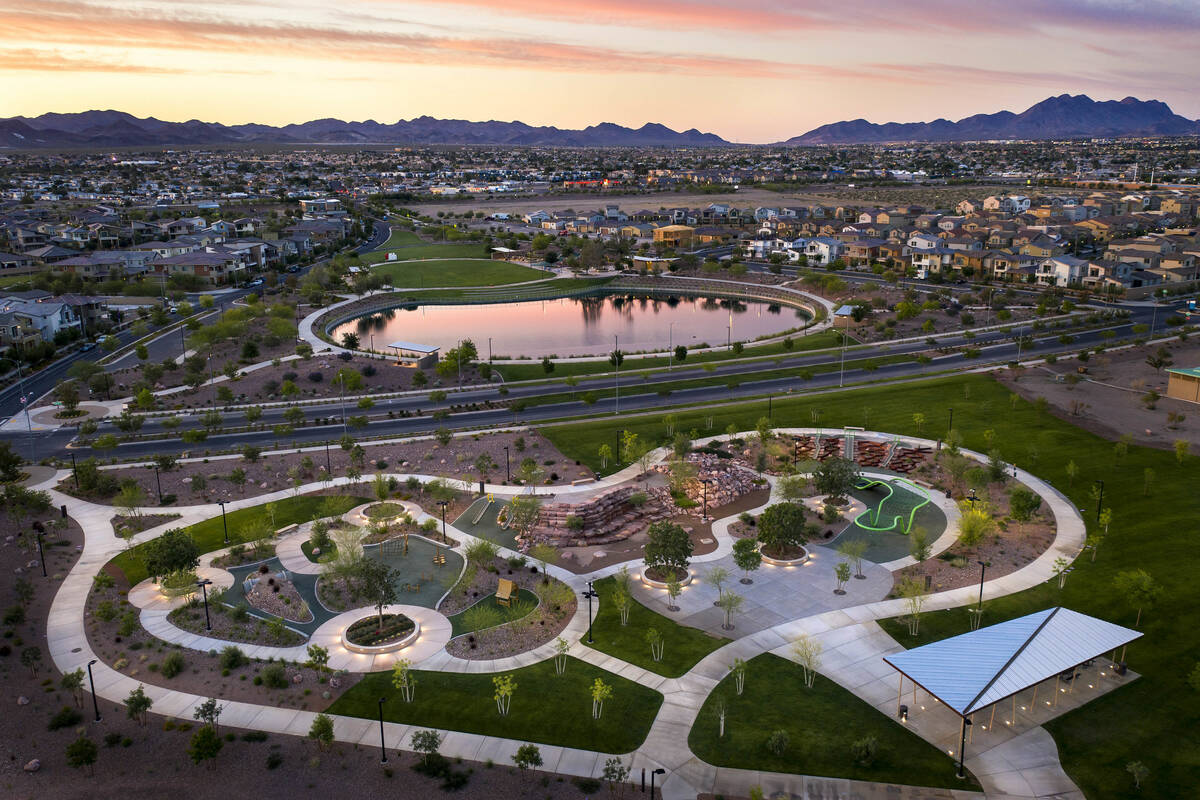
The Henderson master-planned community of Cadence is leading Clark County in new home construction and riding the wave of new home sales in the valley and across the country.
So far in 2024, 153 homes have started construction in Cadence and its Symmetry Trails neighborhood, which is an average of 12.8 homes a month, according to data obtained by the Las Vegas Review-Journal from residential construction data company Zonda.
The northeast Henderson community is being spearheaded by nearly a dozen separate homebuilders, including Century Communities and Lennar, one of the largest homebuilders in the country.
Right behind Cadence on the new home construction list is Saguaro North Landings in the western valley, with 151 new home starts this year. The community, which is being built by KB Home, sits southeast of Enterprise on the west side of Interstate 15.
Henderson enclaves make up three of the top five spots for new home construction starts this year. Inspirada/Groves came in third (142), and LLV Northshore/Del Webb came in fourth (133).
New home construction appears to be finding its way back to a pre-pandemic equilibrium, according to Zonda, which obtained its data from Clark County. In the fourth quarter of 2023, 9,600 single-family residences broke ground, a drop from other quarters over the last few years. The peak for construction was in the first quarter of 2022, when work started on 13,229 homes.
Cadence has been building for a decade
Cadence is north of where state Route 582 and Lake Mead Parkway cross, to the southwest of Lake Las Vegas and directly south of Clark County Wetlands Park.
Cheryl Gowan, the vice president of marketing for The LandWell Company, the Henderson-based developer of Cadence, said although the community is getting increased attention lately, it’s actually celebrating its 10th year of development .
“We’re seeing buyers in all demographics, including first-time homeowners, new families and empty nesters,” she said, adding the first lights went on in 2014 and the community hit 1,000 homes completed in 2018.
Homes range from $400,000 to $700,000-plus, which puts them mostly above the median sale price for the Las Vegas Valley ($425,000). So far approximately 5,200 homes are occupied, and the community will have a total of 12,250 residential units when it is completed in roughly five years, Gowan said.
The community is anchored by the 50-acre Central Park and the Citrine Sky Park. It already has an ER hospital and the 30-acre Cadence Village Center.
Why new builds
Brittany Barnett, a real estate agent with Realty One Group, said she can “see the appeal” and Cadence’s increased prominence as of late. However, she also said the area still needs to fill out with more amenities to attract more buyers.
Still, it could be a cheap long-term bet for new homebuyers who are being scared away from more expensive projects in other parts of the valley, she said.
“Maybe things will pop up more out there… I think it might potentially be a good investment if you’re willing to live further out as the homes are more affordable. They are definitely a lot lower than, say, if you wanted to live in Green Valley, and if you wanted to spend the same amount you’re probably going to get a 20 year-old home.”
Barnett said new home sales now make up the majority of her sales as few existing homes are on the market, thus master-planned communities like Cadence are becoming more enticing to buyers, especially first-time homebuyers.
“I always try to take my clients to get a new home as opposed to selling them a resale home,” she said. “Also a lot of the builders are giving incentives like lenders offering promotional interest rates, and we can negotiate more.”
The Las Vegas Valley’s residential real estate market has been mired by high interest rates since last year, when sales of all properties hit their lowest levels since the Great Recession in 2008. Myriad factors are playing into a national housing crisis, including a lack of supply, elevated mortgage rates and institutional investors snatching up single-family residential properties and turning them into rentals.
Clark County recently announced $66 million of funding “to support the construction and rehabilitation of affordable housing units for low to extremely low-income residents” as part of its Welcome Home initiative.
Contact Patrick Blennerhassett at [email protected] .


The nation’s largest homebuilder has been leading the charge but has trailed off in recent months, according to new data.

The community boasts views of the entire Las Vegas Valley and features properties that cost up to $6 million.

The home, which went viral after appearing on a website last summer, draws heavily from the Johnny Depp film series and features a bar that looks like a ship.
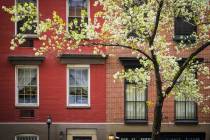
Rents in most major U.S. metropolitan areas have risen some 1.5 times faster than wages in the last four years, according to an analysis by Zillow Group Inc.

Clark County commissioners voted to award nine applicants a total of $66.25 million from a county housing fund.

The unincorporated area of Enterprise is beginning to rival North Las Vegas and Henderson for new development and residents.

On top of this, residential real estate continues to become more and more unaffordable for the average American, according to Redfin.
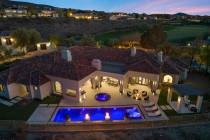
The home in the Anthem Country Club in Henderson sold for $4.8 million, with the sale recorded by the county on May 1.
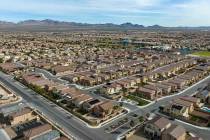
Two cities in the valley rank 10th and 11th in the nation for fastest-growing house prices, according to a new study.

Zonda statistics show a bounceback in housing starts on the residential side as the market finally gets off the pandemic roller coaster ride.
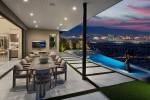

IMAGES
VIDEO
COMMENTS
Historic sites, ghost towns, refuges Explore Nearby Attractions. Grab some food! Restaurants. What roads are closed or damaged? Road Conditions. Enhance Your Experience! Guided Tours. Park footer. Contact Info. Mailing Address: P.O. Box 579 Death Valley, CA 92328 Phone: 760 786-3200. Contact Us Tools. FAQ; Site Index; Español; Stay Connected ...
In this below-sea-level basin, steady drought and record summer heat make Death Valley a land of extremes. Yet, each extreme has a striking contrast. Towering peaks are frosted with winter snow. Rare rainstorms bring vast fields of wildflowers. Lush oases harbor tiny fish and refuge for wildlife and humans. Despite its morbid name, a great diversity of life thrives in Death Valley.
21. Do Some Stargazing. As a Gold Tier Dark Sky National Park, Death Valley offers some of the best stargazing and astrophotography opportunities in the country. While you can enjoy stargazing and photographing the night sky year round, the park holds special dark sky events in the winter and the spring.
5. Dantes View. Dantes View. Dante's View offers one of the best overall perspectives of Death Valley. The view from the top looks out over the valley floor, as far as the eye can see, and across to the mountains that line the far side of the valley. This lookout is a little out of the way but worth the effort.
21. Find the Famous Death Valley Mud Cracks. Finding the best mud cracks was high on my list of things to do at Death Valley National Park as the photos I'd seen before visiting seemed almost fake. Death Valley is famous for scenes like the ones below - a valley floor beautifully cracked with geometric shapes.
This incredible view at Artists palette is one of the top things to do in Death Valley. Access: One-way paved road, no vehicles longer than 25 feet Facilities: Toilet in car park Time needed: 30 minutes including drive Distance from Furnace Creek Visitor Centre: 14.5 miles (23.5km)/ 24 minutes Another of the best views in Death Valley is at Artists Palette.
Proper hiking shoes. You don't necessarily need heavy hiking boots for your Death Valley trip, but you should at least invest in some trail runners or light hikers. Flexible sole gym shoes aren't good for gripping the rocky, gravely soil of Death Valley. We've put 1,000's of miles on the Hoka Speedgoat trail runners.
Death Valley and Sequoia National Park are only 3 hours away from each other. We will also access through the west entrance. BEST THINGS TO SEE IN DEATH VALLEY. In this section, you will learn about the top things to see in Death Valley. Most of these attractions can be visited on the same day, and they are the essence of Death Valley.
Scotty's Castle CLOSED until 2019 due to flood damage. This 1920s vacation home in the desert was built by insurance magnate Albert Johnson. However, at the time most people believed it belonged to Death Valley Scotty, who claimed to have a secret gold mine in the tunnels beneath it. 99% of the contents are original from when the Johnssons vacationed there in the 1920s and 1930s.
Death Valley National Park is the hottest, driest, and lowest national park in the United States and welcomes 1 million visitors per year. News. ... states and contains nearly 1,000 miles of roads that wind through the park and take visitors to the amazing sites and attractions. Each year over 1 million visitors come to explore this massive ...
Death Valley National Park is an American national park that straddles the California ... Tourism expanded in the 1920s when resorts were built around Stovepipe Wells and Furnace Creek. Death Valley National Monument was declared in 1933 and the park was substantially expanded and became a national park in 1994.
2. Badwater Basin. At 282 feet (85.5 meters) below Sea Level, Badwater Basin is the lowest point in North America and one of the lowest elevations on earth. This is the place that made Death Valley famous and is one of the most visited sites in the park. And indeed, Badwater Basin is absolutely worth a visit.
Death Valley National Park Tourism: Tripadvisor has 36,337 reviews of Death Valley National Park Hotels, Attractions, and Restaurants making it your best Death Valley National Park resource.
An official form of the United States government. Provided by Touchpoints. P.O. Box 579. Death Valley, CA 92328.
from. $199. per adult. 3. Small-Group Death Valley National Park Day Tour from Las Vegas. 82. Full-day Tours. 6+ hours. Explore Death Valley National Park, the lowest point in the Western Hemisphere, on this full-day excursion from Las Vegas….
What makes Death Valley's attractions so famous is their diversity: from salt flats to volcano craters, from snow-capped mountains to dry sand dunes, and from colourful hills to arid desert. Having visited there on a break in the developed world, we wanted to write a one-stop catalogue to the best attractions Death Valley has to offer. ...
Death Valley is huge.I mean, like, Alaska huge - in fact, Death Valley National Park is the 5th largest national park in the United States - and the four larger national parks are in Alaska.It encompasses some 3.4 million acres (5,270 square miles), three-quarters the size of Denali National Park and almost the same size as Glacier Bay National Park.
Preparations: 4 Important Things To Remember When Visiting Death Valley. Most of Death Valley is accessible by car, but you should know that it is the hottest place in the United States; usually the temperature is around 113 degrees Fahrenheit and the highest recorded temperature, measured on July 10, 1913, is 133 degrees Fahrenheit. If you don't believe me, look at the picture below.
Earlier this year, Death Valley National Park drew visitors thanks to the rare formation of a lake at Badwater Basin, the lowest point in North America. But Death Valley is filled with natural and ...
A historic tram tower built more than a century ago to haul salt out of Death Valley was recently toppled in Death Valley National Park, possibly by a motorist who attached a winch to the tower to pull a vehicle out of the muck, according to park staff.. The 113-year-old tower was found upright in early March, but then discovered uprooted on April 27.
Sightseeing- Park Highlights. At over 3.4 million acres, there is a lot to see in Death Valley National Park! In a park this large, deciding which sites to visit can be overwhelming. Click on the locations in the list below to help you decide what to see based on how much time you have. Note that all of these locations can be accessed by car ...
A historic Death Valley tower toppled as a driver used it to free their stuck vehicle, rangers say. Sometime between April 1 and April 23, the tower, part of the Saline Valley Salt Tram, "was ...
This was my fourth trip to Death Valley over 40 years, last time was 2015. The Ranch area has really improved, food was much better although still national park food. We stayed at the Inn which was a splurge but had a large room, good stargazing deck and a great pool.
PARKERSBURG — The Mid-Ohio Valley Model Railroad Club will unveil several new attractions and honor one of its deceased members with an open house on Saturday. The late Harold Shive will be ...
A historic salt tram tower in Saline Valley has been damaged according to the National Park Service. Crime Police search for teen accused of shooting, killing 16-year-old in Las Vegas neighborhood
Added Rep. Pat Ryan, former Ulster County executive, "This site will bring thousands of good-paying jobs to the region, cementing the Hudson Valley at the forefront of a vibrant new economy In New ...
The Henderson master-planned community of Cadence is leading Clark County in new home construction and riding the wave of new home sales in the valley and across the country. So far in 2024, 153 ...